
Home » Travel Guides » 15 Best Places to Visit in Venezuela

15 Best Places to Visit in Venezuela
There are many beautiful and varied regions of Venezuela to explore. It has the Andean mountain range, the Caribbean coast, inland dunes, and the anaconda filled wetlands. It’s a tropical country with incredible biodiversity that you’re sure to fall in love with.
Famous as the birthplace of Simon Bolivar, the liberator of many countries in South America from Spanish rule, you’ll find tributes to him in almost every city and town.
Though the country has been struggling in recent years with inflation and rising crime, Venezuela remains a destination spot and the rewards of travelling here are amazing – it’s full of “trip of a lifetime” places you can’t afford to miss.
1. Angel Falls

Venezuela is home to the world’s highest waterfall. Needless to say, this is the most popular destination in the country. With nearly a 1 kilometre drop, spectacular is really the only word to describe it.
Located in a rather isolated jungle in the Canaima National Park, the falls are on the Orinoco River. Hikers will love the trek out to this UNESCO World Heritage Site.
To cool off you have the option of taking a dip in the white sand beaches around the lagoon or the natural pools at the base of the falls.

Calling all adventure sports lovers! You’ll want to spend time in the progressive town of Mérida. This rather affluent city has both fantastic mountain vistas and an unhurried and cultured vibe. The energy is youthful and friendly, thanks in large part to the university here.
Mérida has a gorgeous climate which attracts the outdoor enthusiasts looking for top quality activities to choose from. Try rafting, canyoning, mountain biking, hiking, and paragliding – the city’s specialty.
Stay here if you’re looking to take lightening-viewing trips to Catatumbo or wildlife trips to Los Llanos. After you’ve indulged your sense of fun, enjoy a rather fast-paced nightlife.

This small and somewhat deteriorating town on Venezuela’s coast is a UNESCO World Heritage Site due to the colonial architecture.
Coro also boasts wonderful museums and a lovely cathedral. This is a city for walking and you’ll really enjoy Zamora, where the historic mansions are.
Coro is the starting point for the fabulous sand dunes found in Parque Nacional Médanos de Coro and it’s also a nice base camp for exploring areas like the Sierra de San Luis Mountains or the Península de Paraguaná.
4. Los Roques

After your visit to the Archipelago of Los Roques National Park you’ll always think of it as one of the most beautiful places on Earth. Incredible shades of blue in the surrounding waters, white sand beaches, the vibrant green of the mangrove swamps, and the otherworldly shapes and shades of the coral reefs all combine to make the park truly breathtaking.
You’ll quickly see that it’s an area of bright and gorgeous contrasts. There are over 1,000 keys here and you can find a landscape to suit your preferences – everything from sand beach, good surf, rock beach, still water bays, coastal barrier, lagoons, salt mines, and more.
Don’t leave without trying the fishing, sailing, diving, lobster catching, and windsurfing on offer.
5. Ciudad Bolívar

Ciudad Bolívar has a proud history as the centre of the struggle for independence in Venezuela. Simon Boliver set up his military base here as he began the final campaign in the War for Independence.
It’s the capital of the country’s largest state and the historic centre, known as Casco Historico, is without doubt the countries best. There’s a staggering array of colourful colonial buildings, the Paseo Orinoco, and tons of shaded squares to loiter in.
Most travellers find a reason to stop here on their way to Angel Falls. Be sure to check out the Plaza Miranda, the cathedral and historic cemetery there.
6. Henri Pittier National Park

This is Venezuela’s oldest national park. Its claim to fame is birdlife, and with over 500 bird species, it’s little wonder.
Named for Henri Pittier, who came to the country in the early 20th century and worked to classify over 30,000 plants.
He is also one of the founders of the national park system in Venezuela. The park has fantastic coastline, beaches, bays, mountains, and a few resorts. There’s great opportunity for diving, swimming, and sunbathing.
7. Isla Margarita

One of the best places for beach bums in Venezuela is Isla Margarita, the largest island off the coast. You’ve got more than 50 beaches to choose from and each will suit various personalities – for instance, Playa el Yaque is great for water sports, Juangriego is a large laid back beach town, and Península de Macanao is largely untouched and deserted.
Venezuelans love to come to Isla Margarita thanks to the duty free shopping at the port.
The capital is La Asuncion, a large and surprisingly urban city. You’ll find great shopping, restaurants and nightlife here and in Porlamar. Be sure to head inland and do some trekking in the mountains before you go.
8. Mount Roraima

Sitting at an elevation of almost 3,000 metres, Mount Roraima has a flat tabletop that feels otherworldly. Lying mostly in Venezuela but partly in Guyana and Brazil, it is the main attraction of Canaima National Park. The hike to the top is usually done in two days.
The geological formations are as old as two billion years. Home to rare animals and birds, Mount Roraima was the inspiration for Sir Arthur Conan Doyle’s The Lost World.
Because of its uniqueness, the mountain figures prominently in many of Venezuela’s folklores.
9. Maracaibo

Usually people come to Maracaibo because they’re in the oil business, but there’s a lively historic centre that history buffs will want to see. Most people stay in the new centre where you’ll find nice shopping and upscale hotels. This is Venezuela’s second largest city and a nice day excursion.
10. Barquisimeto

The capital of the state of Lara, Barquisimeto is simply lovely, charming, and timeless. Situated on the Turbio River and nicknamed “City of the Twilight,” this is a place you’ll want to linger.
Known as the musical centre of Venezuela, there’s an energetic cultural vibe that has a definite global influence. While you’re there, stop by the Museo de Barquisimeto. This museum is housed in a large historic building with a central courtyard and chapel inside.
There’s a so the Iglesia de la Concepción, the town’s first cathedral originally built in the 19th century.
11. Los Llanos

Also known as The Plains, the grassland region of Los Llanos is located on the border between Columbia and Venezuela. During the summer months the plain tends to flood making this the perfect destination for bird lovers.
When it’s dry season Los Llanos is ideal for wildlife sighting when the animals gather in the few areas with water – giving it the nickname of the Serengeti of South America.
You’ll find anacondas, jaguars, caimans, capybaras, and the Orinoc Crocodile – now found in no other place.
12. Guayana

Not to be mistaken for the country of Guyana, the southeast region of Guayana is Venezuela at its exotic best. This is the region of Angel Falls and Parque Nacional Canaima as well as the Orinoco Delta, a phenomenal wildlife area.
You’ll find the Venezuelan Amazon, Rio Caura, and The Great Savanna (La Gran Sabana) where the Tepui Mountains loom large and distinctive. Several large communities of indigenous groups call Guayana home, including the Pemón, the Yanomami, and the Warao.
Some travellers come to Venezuela just for this region and spend their entire holiday discovering its many delights.
13. Choroni

Choroni is a quiet and charming beach town where those looking to relax and do a lot of “nothing” should plan to spend some time. The town has a colonial feel and a quiet plaza perfect for relaxing.
If you want to spend time in Henri Pittier National Park, Choroni makes a good base camp.
This is the perfect place for those who want to slow down and unwind.
14. Medanos de Coro National Park

Medanos de Coro National Park is famous for its sand dunes – considering that they’re located in a tropical country.
Some of the dunes reach 40 metres and are shaded yellow and orange. The high winds here mean the dune constantly and delightfully change shape.
Visitors love to come and sand board on the dunes or explore the larger area on camel.
15. The Andes

Most people think of sun and sand when they think of Venezuela so it’s worth noting that it’s also home to a 400km stretch of snow capped Andes Mountains. Pico Bolivar, the country’s highest peak, stands at just over 5,000 metres.
If trekking through the high passes isn’t for you, don’t discount the area. You’ll find cascading waterfalls, green valleys of cloud forest, quaint mountain villages that are only accessible by winding roads.
Start in Mérida state, which has some of the best tourist infrastructure right now for exploring the mountains. For those big into adventure, try Táchira and Trujillo.
15 Best Places to Visit in Venezuela:
- Angel Falls
- Ciudad Bolívar
- Henri Pittier National Park
- Isla Margarita
- Mount Roraima
- Barquisimeto
- Medanos de Coro National Park
Top Venezuela Attractions
Things to do in venezuela, explore popular experiences, popular cities in venezuela.

Top Attractions in Venezuela
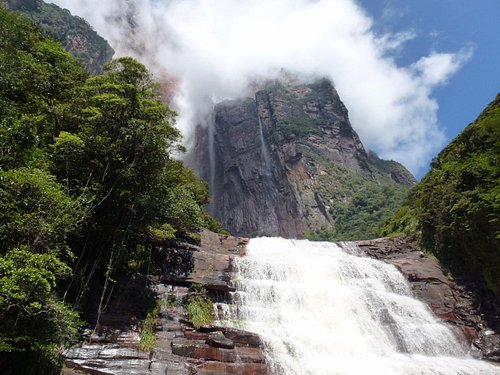
What travelers are saying

10 BEST Places to Visit in Venezuela in 2024 (Plus Tips)
- Last Updated: February 6, 2024
From Angel Falls to Mount Roraima, these are the best places to visit in Venezuela!
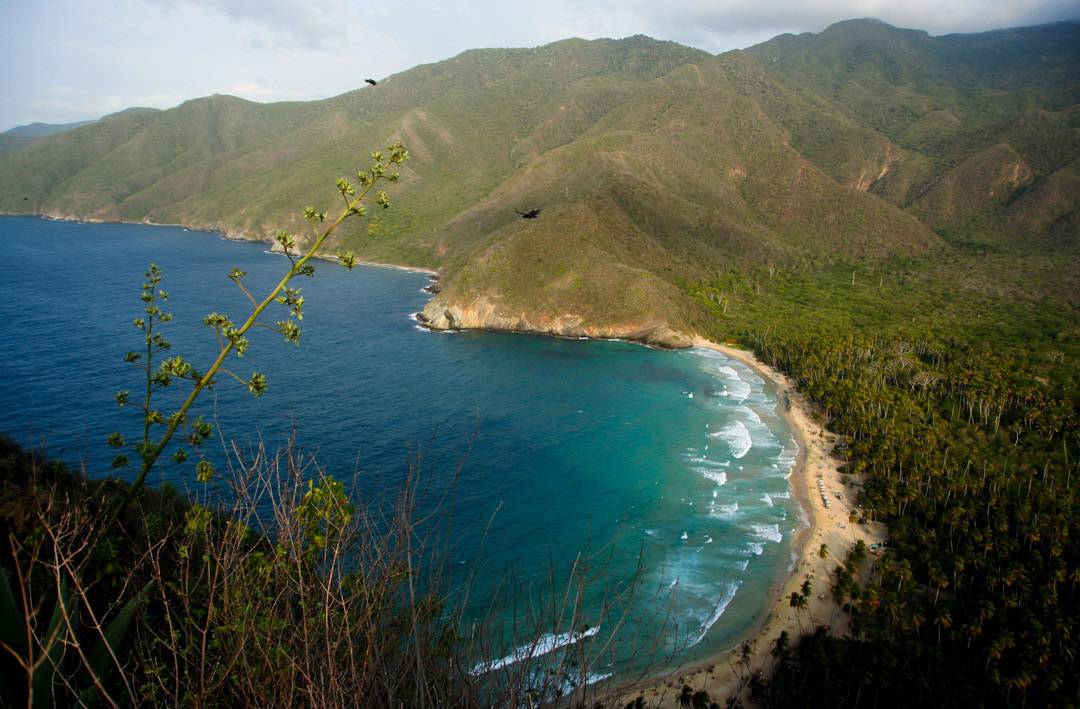
Venezuela’s economic problems, bad reputation and political uncertainty haven’t helped in the development of tourism to this Caribbean country in South America.
The truth is that, as one of the largest oil producers in the world, the government has focused most of its efforts on the exploitation of oil fields, sometimes to the detriment of other economic activities.
However, the reality could be very different. Venezuela is a jewel to discover, a virtually unexplored territory with places of incomparable beauty.
From paradisiacal beaches to impenetrable jungles to vertigo-inducing routes through the Andean highlands, the possibilities for visitors are almost endless.
Table of Contents
1) Salto Angel
2) the amazon rainforest, 3) cayo sombrero, 4) mount roraima, 5) the orinoco delta, 6) los llanos, 8) puerto colombia, 9) los médanos de coro national park, 10) parque mochima national park, 1) bring dollars or euros, 2) stay safe, 3) relax and enjoy, top places to visit in venezuela.
If you’re feeling like an adventure to one of the most beautiful countries on the planet, then don’t miss out on these amazing places to visit in Venezuela.
Angel Falls , at 979 meters high, proudly boasts being the highest waterfall in the world. Located in the Venezuelan Gran Sabana, this is a place holding a sacred character for the natives. It is, without a doubt, the biggest out of all Venezuela tourist attractions.
To get there, you’ll have to navigate up the Carrao River, right in the heart of Canaima Park, until you reach the base of the falls. Inscribed on the UNESCO World Heritage list in 1994 , this park offers hundreds of cascades of equal beauty, as well as wild rivers and red-water lagoons.
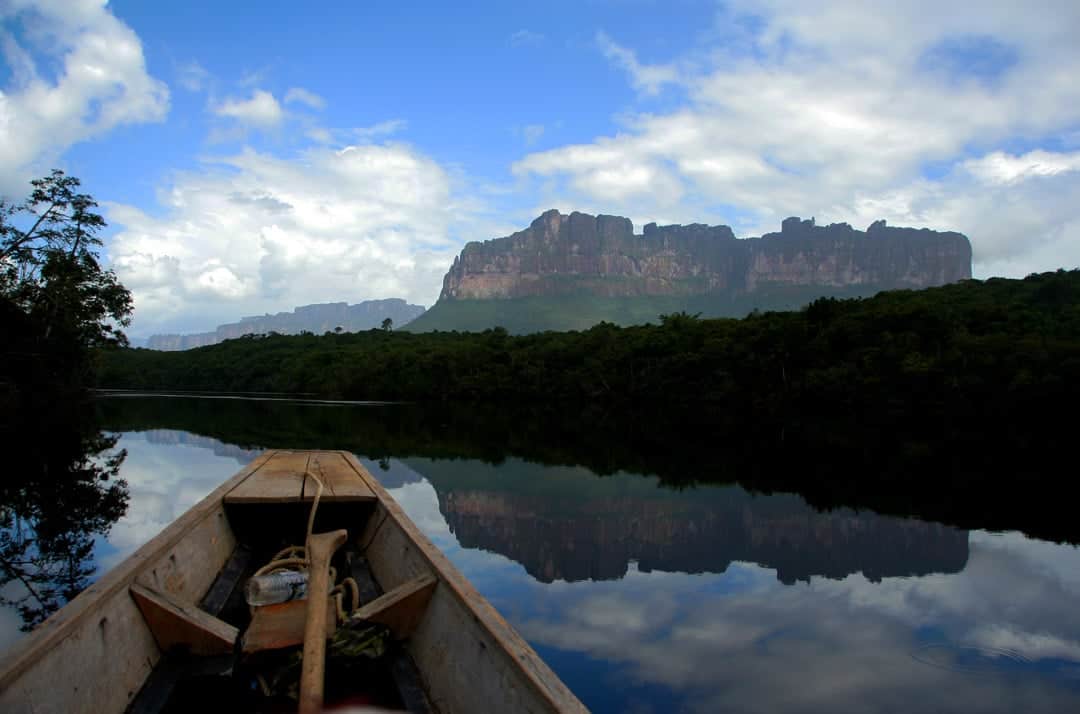
Mystical and legendary, this dense and humid territory is the largest jungle in the world. Visitors can venture along its rivers to find wild animals, lush plants and tribes that have barely changed their traditions in the last 500 years. The Amazon rainforest is one of the best things to see in Venezuela.
Although uncontrolled logging and the construction of dams are seriously threatening the future of this ecosystem, it’s still possible to visit several protected reserves and enjoy one of the seven new natural wonders of the world. Definitely an amazing spot on the list of places to visit in Venezuela.
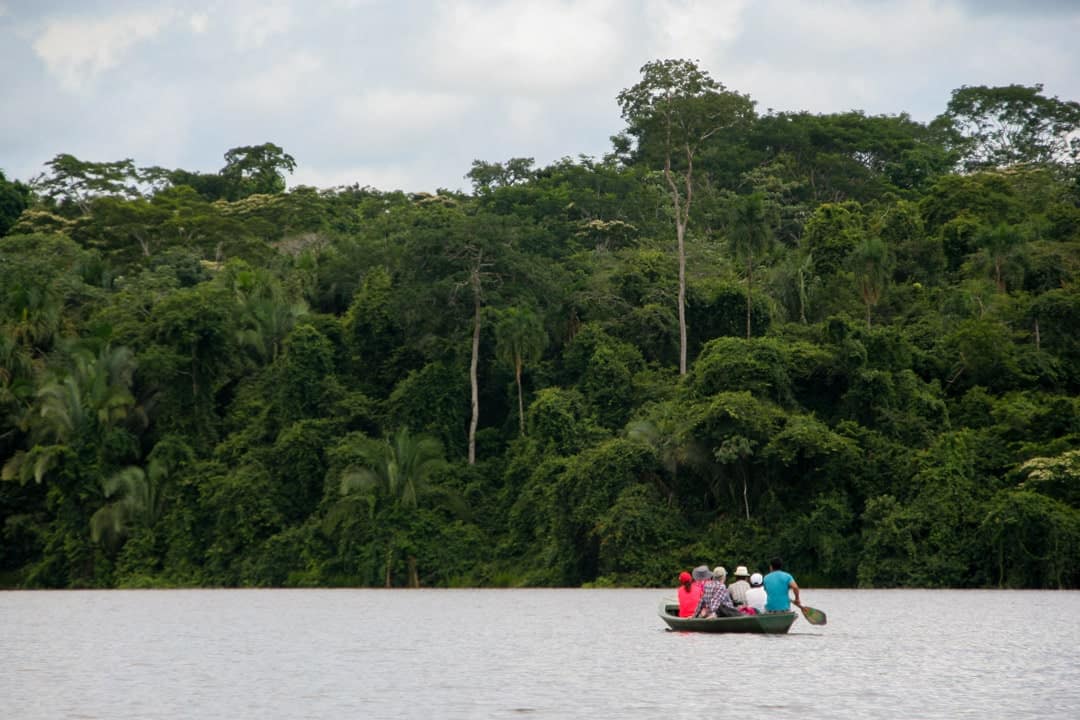
Because Venezuela’s coasts are completely bathed by the Caribbean Sea, it’s no surprise that there are plenty of amazing islands and beaches to visit.
When you think about a paradisiacal destination, you probably envision yourself lying in the shade of a palm tree on a white-sand beach with turquoise water, right?
That’s the exact description of Cayo Sombrero, a tiny island located a few kilometres off the coast of Chichiriviche, in Morrocoi National Park.
Enjoy the peace of this place with no infrastructure, houses, restaurants or hotels. You can easily arrange a boat to get you there, and agree on a time so they can pick you up.
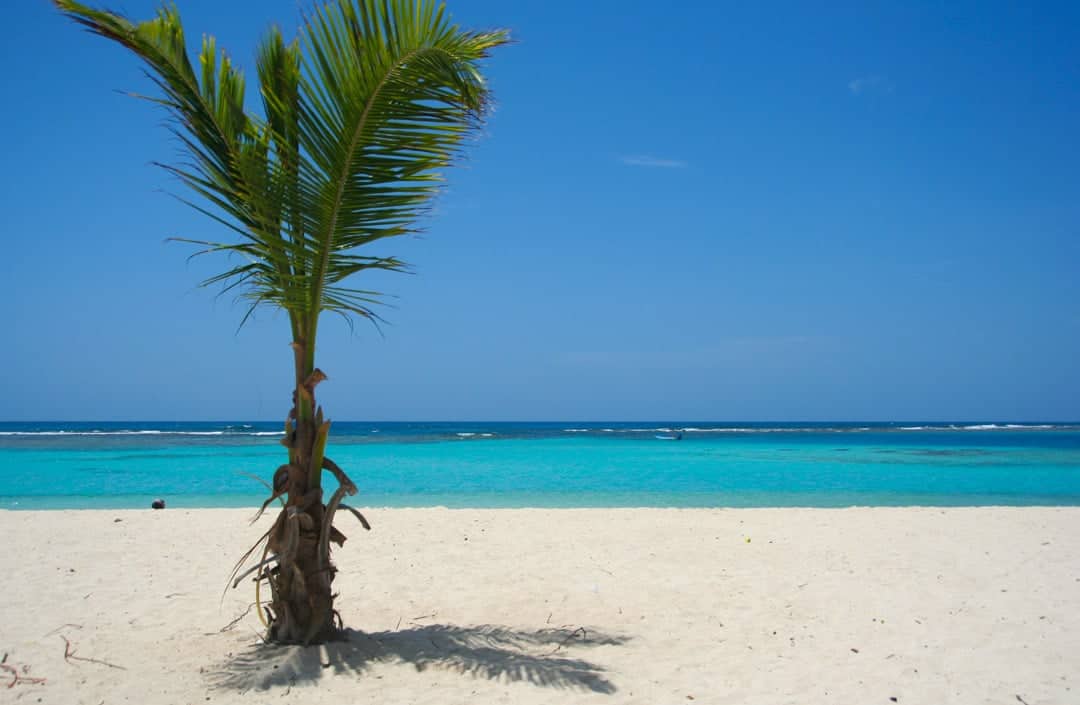
Mount Roraima, called Tepuy Roraima by the indigenous population, is a majestic table-shaped mountain located right on the triple border point of Venezuela, Brazil and Guyana.
The hike will take at least five days to complete. You’ll have to cross wild rivers and walk along steep paths before enjoying amazing views from the summit.
Once you’re on the top, the extravagant rock formations will certainly make you feel like you’re on another planet. It’s easy to understand why this mount inspired Sir Arthur Conan Doyle to write his famous novel “ The Lost World “.
For all avid hikers, Mount Roraima is one of the Venezuela attractions they can’t miss!
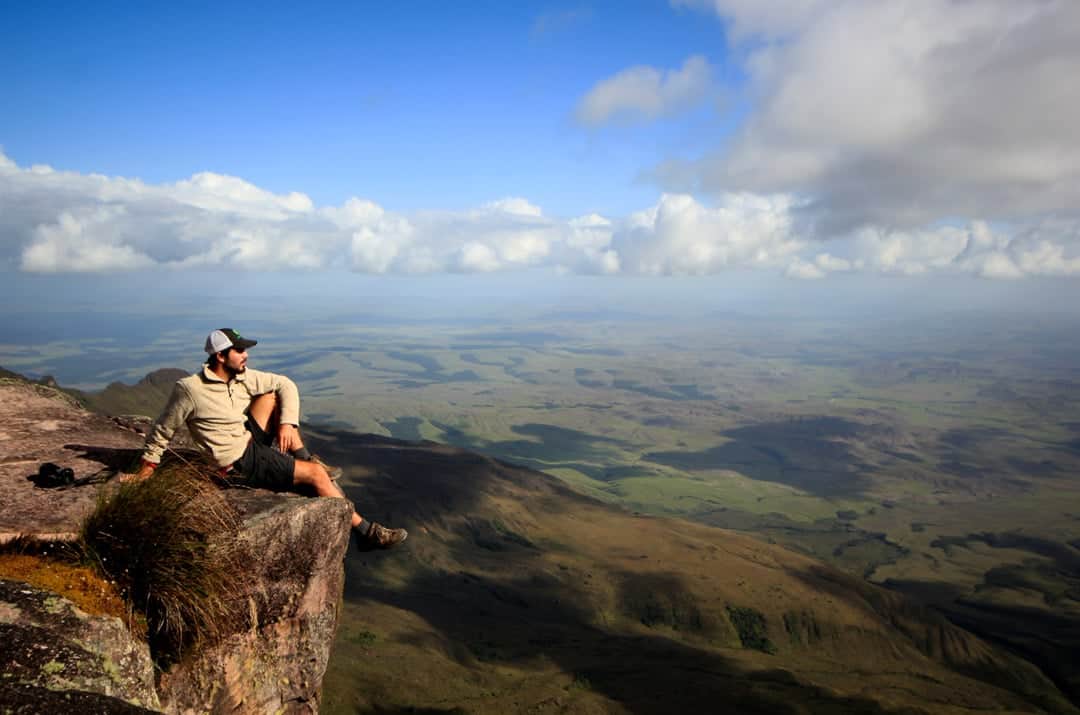
The beautiful Orinoco River, one of the most important in South America and the third largest river in the world after the Amazon and Congo, has been a subject of study by dozens of explorers since Christopher Columbus documented its existence in 1498.
The delta region, formed mainly by materials the river washed away and by mudslides from nearby volcanoes, attracts all kinds of adventurers looking for wildlife, flora and fauna.
The delta is an important starting point for jungle expeditions, during which you can see alligators, anacondas and even jaguars if you’re lucky enough.
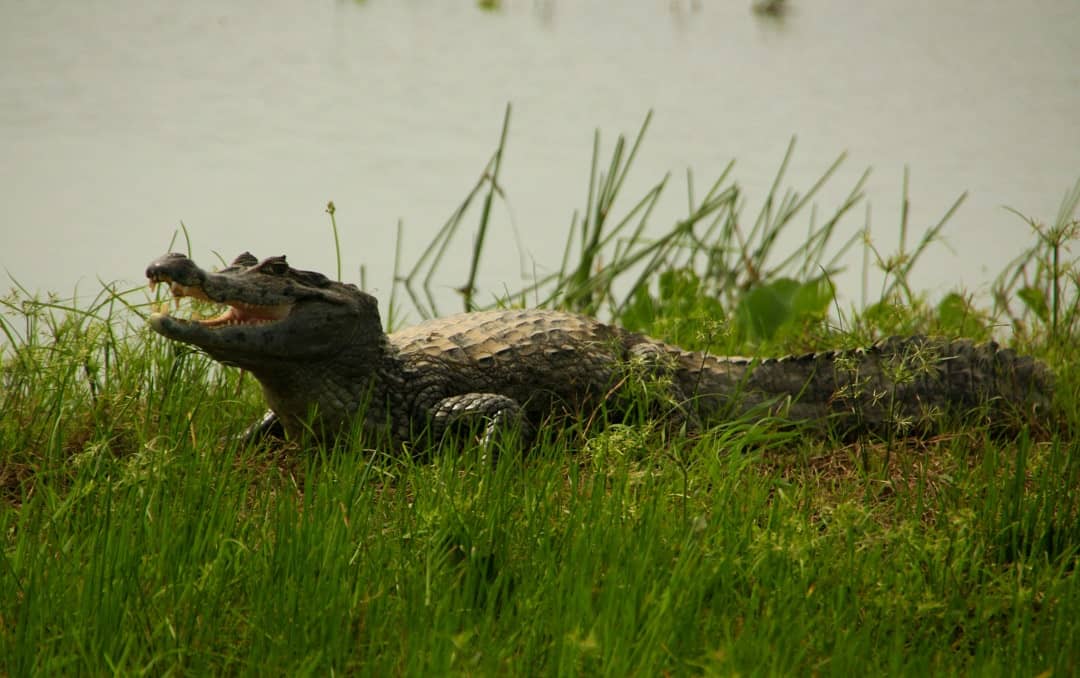
This huge savannah is to South America what the Serengeti is to Africa: a wild extension where animals are the real lords. You can take a multi-day safari and watch hundreds of birds, caimans, deer, capybaras, sloths and more.
Although the region’s activity involves mainly cattle ranching and oil production, eco-tourism is growing in Los Llanos and more visitors have the chance to take in its natural beauty.
When traveling to South America, Los Llanos must be included in your itinerary – it’s one of the best things to do in Venezuela.
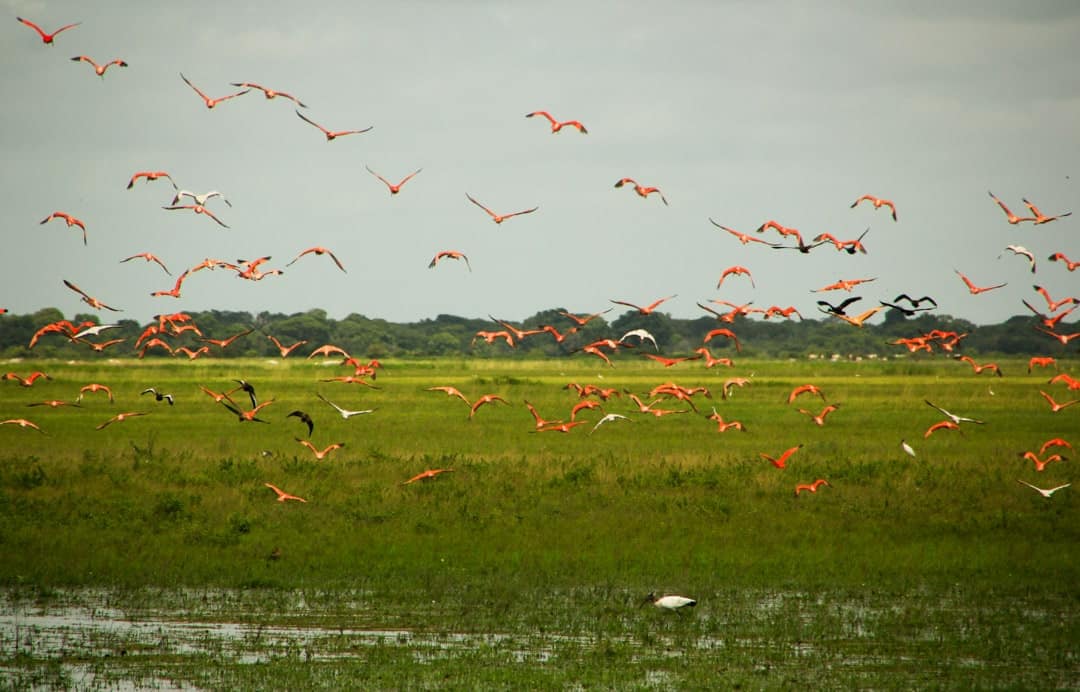
Venezuela’s attractions go beyond tropical jungles and dream beaches. The Andean Range, the mountainous backbone that so drastically affects the climate of the continent, also creates amazing landscapes in the land of Simon Bolivar.
Merida is the most important city in the Venezuelan Andean region, and it’s an excellent starting point for visiting the nearby colonial towns.
It is known as the adventure capital of the country, and it offers a wide variety of activities for all preferences. Adrenaline junkies will find top-class hiking, rafting, paragliding and rock climbing.
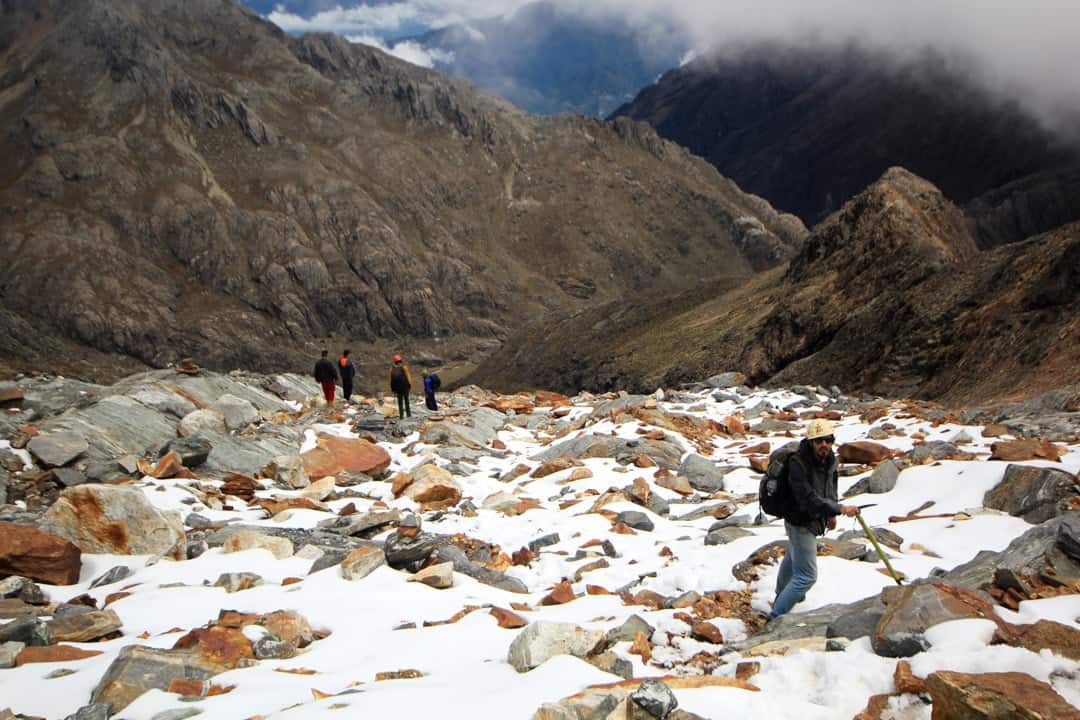
Located on the coast of the Henri Pittier National Park, this small village is characterized by steep mountains, extensive beaches and friendly people.
The beaches are not like those of white sand and turquoise water, but they still have a special charm. It’s a region with strong waves, cliffs that dominate the landscape, and local fishermen who make their living out on the rough waters.

The landscapes and ecosystems in Venezuela are so varied that it’s possible to find a desert in the northwest region of the country.
Located in the Falcón state, Medanos de Coro National Park is a dry setting of large dunes that are the products of erosion and the whims of incessant trade winds.
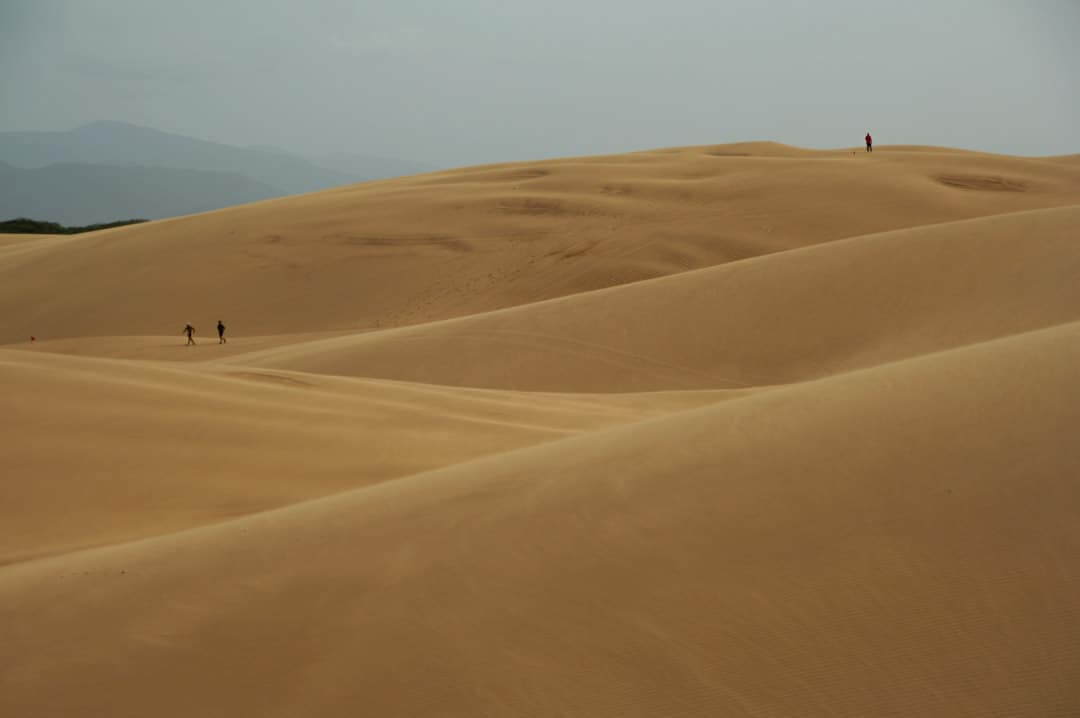
When one arrives at Mochima National Park, one immediately feels the magic of a place where it seems as though time has not passed.
Located between the states of Sucre and Anzoátegui in the eastern part of the country, this park contains a long coast of beaches and islands with pristine water.
The beautiful sunsets and the tranquility of its villages make Mochima one of the most attractive destinations on the Caribbean coast.
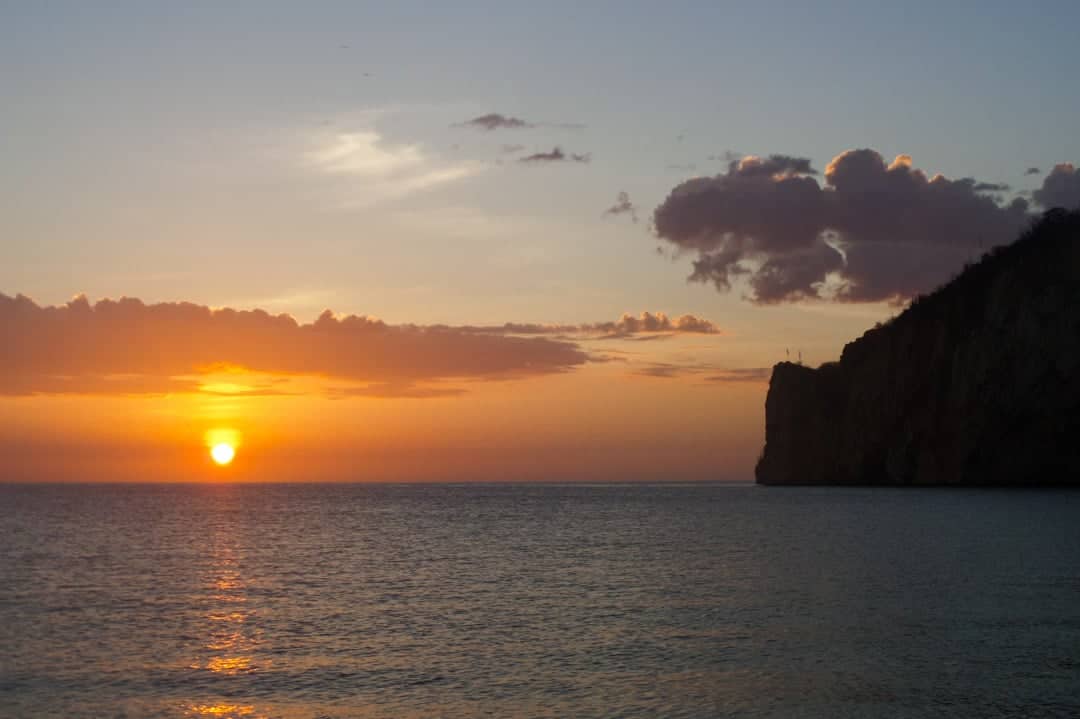
Tips For Visiting Venezuela
Now that I’ve inspired you to pack your bags and travel to this South American nation, here are our best travel tips for visiting Venezuela.
Venezuela has one of the world’s craziest economic systems. While the local people can’t buy more than a few dollars a year, they still need dollars or euros to travel out of the country and to conduct certain transactions. Therefore, the dollar black market is big business there.
Don’t get money from an ATM. You’d get the official exchange rate, and that would ruin you. Bring dollars or euros and change them on the black market.
When I say black market, don’t imagine guys in an alley, dealing with opium or AK-47s. Many people change dollars in Venezuela. Ask in your hostel or in any jewelry store and you will have your money changed in a matter of minutes.
We all know that the current situation in Venezuela is not the best. However, the places on this list are safe to visit if you take the normal precautions. The countryside is still relatively safe.
Avoid visiting big cities like Caracas, Valencia, Maracaibo, etc. If you need to stay in a city, try to make those visits as short as you can. Stay away from big concentrations, protests and other public demonstrations.
Don’t trust military officers. If your bus is stopped at a military checkpoint, hide your money in your underwear. They could ask if you have money with you.
Show them a few bolivares and tell them that’s all you have. Don’t show them your dollars because you might “lose” some of them.
Despite the bad reputation, Venezuela is an incredible country that offers just about anything you can imagine. The people are friendly and the landscapes are unbelievable.
Use common sense and avoid big cities, and everything should be alright!
Miguel Travelsauro
Hi, We’re Alesha and Jarryd!

We’ve been traveling the world together since 2008, searching for the planet’s best destinations and adventures.
Love Travel?
Sign up for our free weekly newsletter for the best travel tips, ideas and deals!
We respect your privacy. Unsubscribe at any time.
READ MORE...
Getting Around Magnetic Island – ‘How to’ Transportation Guide
The ultimate guide to the best magnetic island beaches and bays, the perfect magnetic island day trip itinerary [2024 guide], related posts, ker and downey shinde camp review – okavango delta safari, 4 thoughts on “10 best places to visit in venezuela in 2024 (plus tips)”.
Hoe do you get in? they currently not issuing visas.
I can’t stress this enough! Do not, I’ll repeat it, Do not travel to these places, not now at least, Venezuela is in a constant turmoil, you can’t trust the Police nor the Government to protect you, if anything should happen, you would be left on your own! I’m not JOKING! Venezuela is the third most dangerous Country in the World and it has out of the 15 most dangerous cities in the World, 6 within the list, including the most dangerous one been Caracas, the third been Valencia and the fifth been Barquisimeto; it would be inevitable not to have to find yourself in one of those cities trying to get to your destination; so, I’ll make myself very clear again, DO NOT TRAVEL TO VENEZUELA! Not now. That’s all I have to say.
All these places are a must visit in Venezuela. Also I would say the Angel Falls are the best to see in these country.
Awesome. Thank you for your comment and tip. 🙂
Leave a comment Cancel reply
Save my name, email, and website in this browser for the next time I comment.

©alicenerr/Getty Images
Venezuela, home to some of South America's most incredible landscapes, rightly has a terrible image problem at the moment. Hyperinflation has led to a dramatic drop in living standards and issues with the supply of basic goods, while personal safety, particularly in Caracas, is worse than anywhere else on the continent. Thousands of its own citizens have fled the country and spread throughout South America (it's estimated more than two million have left since 2014). While visiting can be incredibly cheap because of the black-market value of the dollar/euro, safety is a serious concern.
Attractions
Must-see attractions.

Museo de Arte Contemporáneo de Caracas
Occupying the eastern end of the Parque Central complex, the Museum of Contemporary Art is by far the best in the country, though it can be a little…
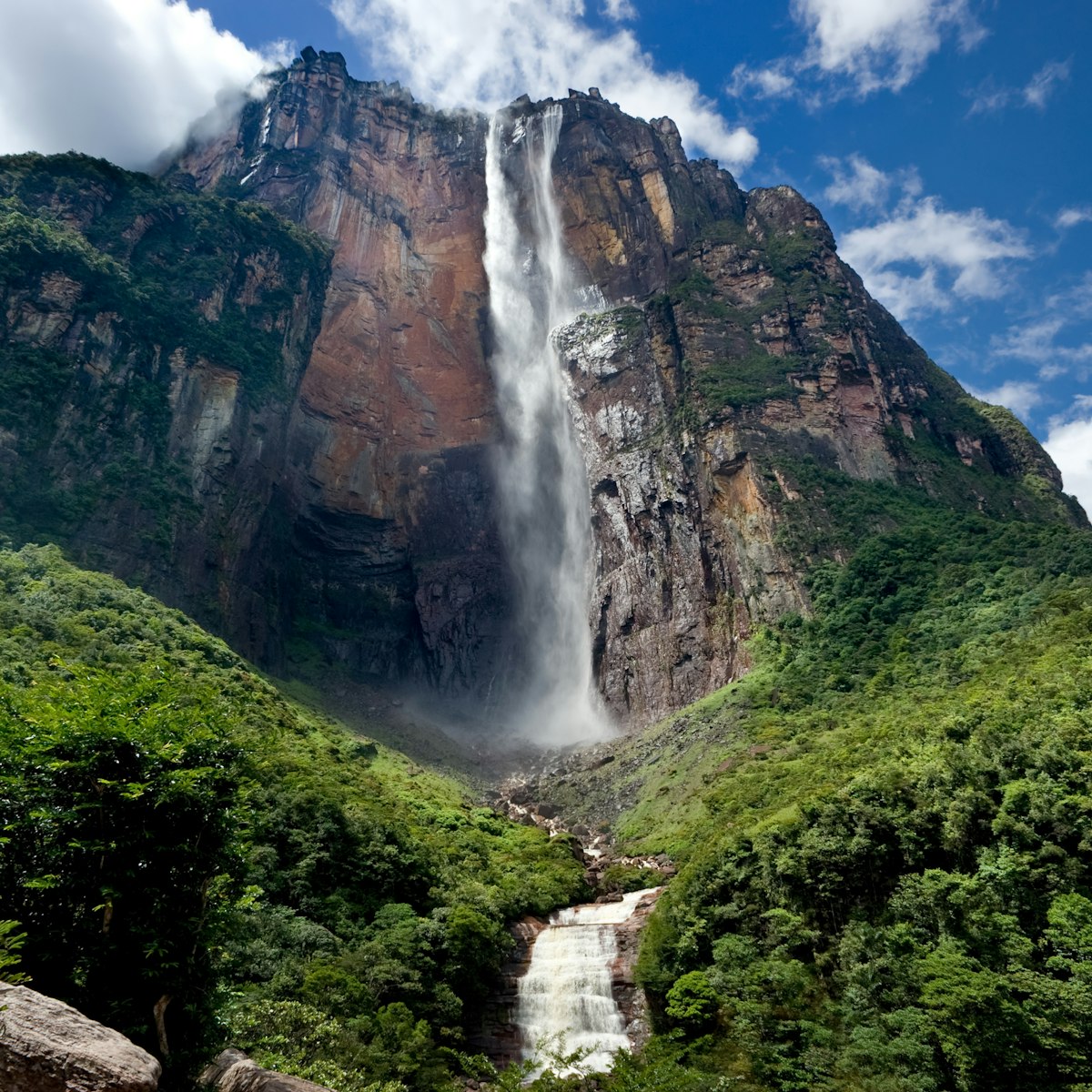
Salto Ángel (Angel Falls)
Thundering Angel Falls is the world's highest waterfall and Venezuela's number-one tourist attraction. Its total height is 979m (3211ft), of which the…
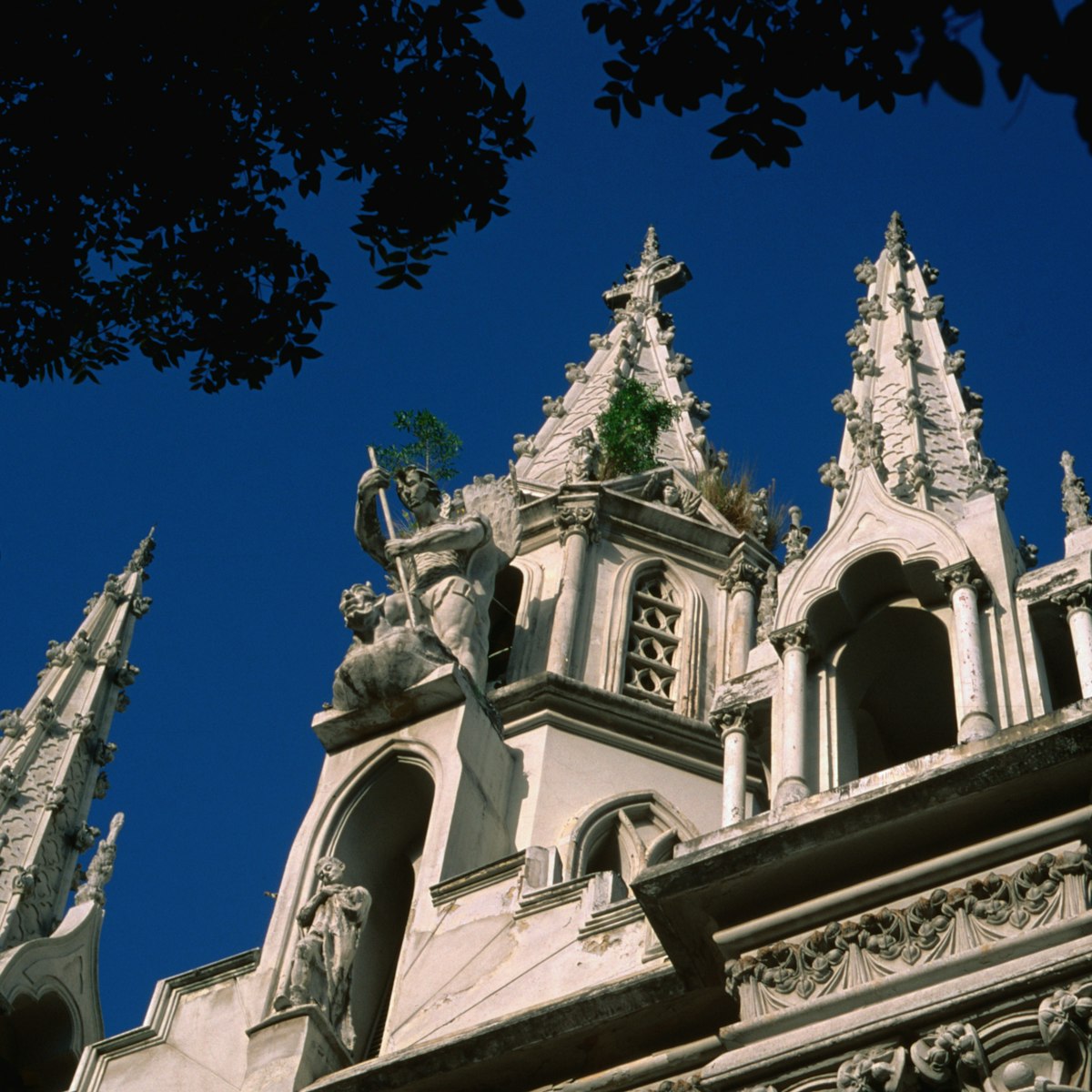
Iglesia Santa Capilla
This neo-Gothic church, one block north of Plaza Bolívar, is modeled on the Sainte Chapelle of Paris. It was ordered by General Antonio Guzmán Blanco in…

Plaza Bolívar
This leafy square is the nucleus of the old town. It's always alive with huddled groups of caraqueños engaged in conversation and children feeding freshly…

Fundación Bigott
If you’d like to dig a little deeper into traditional Venezuelan culture – perhaps learn to play joropo music with the bandola llanera (a string…

Parque Nacional Sierra Nevada
The most popular high-mountain trekking area is the Sierra Nevada national park, which has all of Venezuela's highest peaks, including Pico Bolívar (5007m…

Iglesia de San Francisco
Just south of the Capitolio Nacional, the Church of San Francisco was built in the 1570s, but was remodeled on several occasions during the 17th and 18th…

Gran Roque is the main island and population center, and exudes a distinct Caribbean feel. The sandy streets of the fishing village are lined with single…
Latest stories from Venezuela
Filter by interest:
- All Interests
- Adventure Travel
- Art & Culture
- Beaches, Coasts & Islands
- Food & Drink
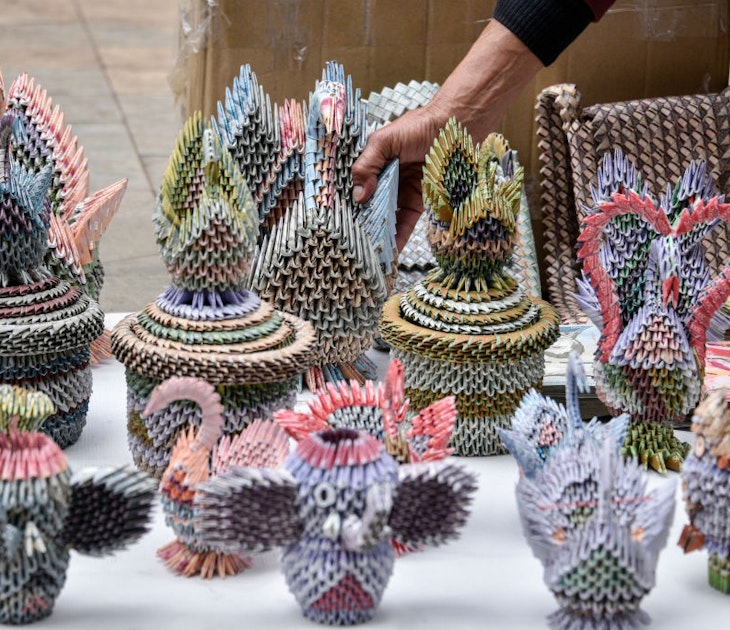
May 21, 2019 • 1 min read
On the streets of Colombia, several artists have decided to craft beautiful items from Venezuela’s colourful bank notes that, due to the collapse of the…
in partnership with getyourguide
Book popular activities in Venezuela
Purchase our award-winning guidebooks.
Get to the heart of Venezuela with one of our in-depth, award-winning guidebooks, covering maps, itineraries, and expert guidance.
Venezuela and beyond
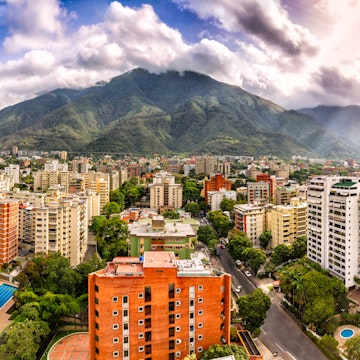

Venezuela Travel Guide
Your ultimate venezuela travel guide, with tips, and things to see and things to do in venezuela. great for first-time and returning travelers..
Rich with culture, history, and friendly locals, Venezuela is a chance to see something different.
Located on the northern coast of South America, it is filled with many white-sand beaches, blue waters, and natural wonders, making it a great getaway.
Fans of the outdoors will love Angel Falls, the highest waterfall in the world, or Pico Bolívar, the highest mountain in Venezuela.
As English is not spoken here as much, it presents a great opportunity to immerse yourself in a new language.
This Venezuela travel guide will help you plan your next vacation.
Popular Guides
5 Unexpected Reasons to Visit Venezuela
Our Highlight
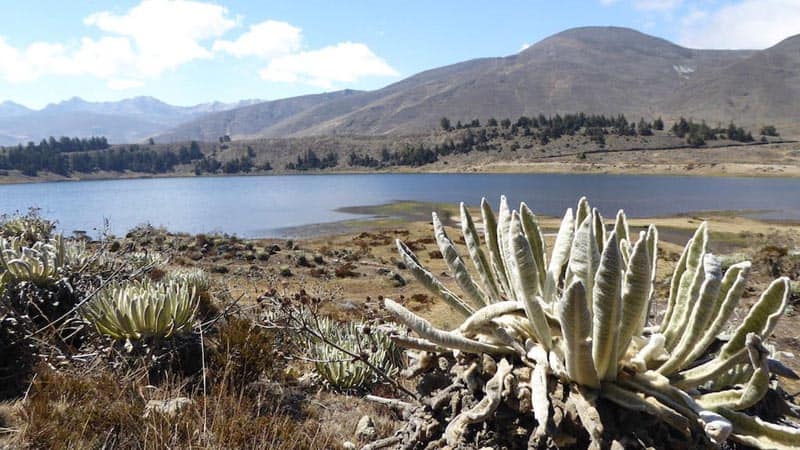
Table of contents
Table of Contents
Fast Facts about Venezuela
- Power voltage is 120V at 60 Hz.
- Venezuela’s currency is the Venezuelan Bolívar and 1 Bolívar is equal to 0.100125 USD.
- The best way to get around Venezuela is by taxi or bus.
- You will need to get a Venezuelan Tourist Visa prior to visiting, as well as a US passport valid for at least 6 months after your stay.
- Crime can and does happen here, so keep valuables close to you and avoid being out at night.
- Popular network providers in Venezuela include Digitel, Movilnet, and Movistar Mobile. Prepaid SIM cards can be purchased through any of these networks. Note that your phone needs to be unlocked in order to use a SIM card, meaning you will probably have to contact your current mobile provider to change your settings to unlocked.
- Venezuela has a sales tax rate of 16%.
Things to See and Do in Venezuela
- Canaima National Park: Fans of natural wonders will love the Canaima National Park. Declared a World Heritage Site, this park is the sixth-biggest national park in the world and is full of beautiful landscapes, diverse fauna, table-top mountains, and cliffs. Points of interest include Angel Falls (the highest waterfall in the world) and Mount Roraima (the highest of the table-top mountains). This park also has camping spots.
- Parque El Agua: Come see Venezuela’s first waterpark. Whether you want to relax in the lazy river or venture through numerous waterslides (including the 18-meters high Churun Meru), this is sure to be a fun day for the whole family.
- Morrocoy National Park: Set on the Caribbean coast of Venezuela, this island is perfect for those looking for a getaway. Relax on white-sand beaches, explore numerous cays (including the very popular Cayo Sombrero), look for dolphins, whales and green sea turtles, and stroll through the nearby towns.
- National Pantheon of Venezuela: Come learn more about Venezuela’s history at this landmark in Caracas. Created in 1870, this mausoleum is now a final resting place for many of the heroes of South America, and also contains historical works of art, including a four-thousand-piece crystal chandelier.
- Teleférico de Caracas: Take a cable lift and enjoy beautiful aerial views of Caracas while you ride to the El Ávila Mountain. Once on top, explore the El Ávila National park, grab a bite to eat, or go to the skating rink.
Venezuela Travel Guides
- 32 of The Tallest Mountains in the World by Continent
- All You Need to know about the Top 10 Best Hikes in South America
Accommodation
Budget: You can find some cheaper hotels at around 200 to 400 Bolívars per night. These hotels come with private rooms, Wi-Fi, and sometimes the hotel’s restaurant and bar.
Mid-Range: For mid-range hotels, expect to pay between 500 to 800 Bolívars per night and enjoy private rooms and suites, an outdoor pool, fitness centers, and one (or more) restaurants inside the hotel.
High-End: Upscale hotels can go from 1,000 to 2,500 Bolívars per night. Amenities include outdoor pools, saunas, massage and salon services, airport transportation, a gift shop, and banquet rooms.
Check out our favorite booking platforms Booking.com , Tripadvisor and VRBO for the best deals on accommodation.
The Best Ways to Get Around Venezuela
Getting to venezuela:.
Getting to Venezuela: The Simón Bolívar International Airport is the main airport for getting to Caracas, the capital of Venezuela, and is just 13 miles from the city center. The La Chinita International Airport is an alternative airport located in Maracaibo (northwest Venezuela), and is just over 9 miles from the downtown area.
Flights: You can check for the best flights to Venezuela on Skyscanner .
Transportation:
Train: The train system for passengers is nonexistent.
Bus: Buses are a cheap way to get around Venezuela and can be found in all major cities and towns. You can find buses for short trips with very cheap fares, as well as buses for long-distance trips that come with their own air-conditioning. You can also look for por puestos, which are essentially a ride share service that operates like a bus. Caracas also has its own metro system that runs frequently, with a typical fare costing less than 5 Bolívars.
Taxis: Taxis are another good way to get around and come with cheap fares compared to other countries. As they do not operate on a meter, it is a good idea to ask around about typical fares so you can negotiate the price with the driver. You can take a taxi for an individual trip or, if you know where you will be traveling, you can contact a travel agency and arrange private taxi transfers between cities.
Rent a car: To rent a car in Venezuela, you need to be at least 21 years old and have a U.S. driver’s license. Prices start at around 400 to 600 Bolívars a day.
You can also compare prices here
When to go To Venezuela
- Venezuela, with its tropical climate, has two seasons: wet and dry. The wet season is between May and October and is considered the best time to see Angel Falls due to the increase in rainfall. March through May are the warmest months in Caracas. For those who want to pursue outdoor activities like hiking, November is a good month to visit due to the warmer temperatures and the start of the dry season. If you’re going to Los Llanos, October may give you the best chance to see wildlife.
Where to Stay in Venezuela
Hotel Waldorf: Stay in this beautiful 3.5-star hotel in Caracas. Its prime location makes it a quick trip to the local movie theaters and beauty shops, as well as the Government Palace. Afterwards, relax in an air-conditioned room or suite, head to the fitness center, lounge in the swimming pool and terrace area, or dine at the sky bar and restaurant.
InterContinental Maracaibo: Featuring beautiful views of the Maracaibo Lake, this four-star hotel is just minutes away from the Vereda del Lago park and the Aguamania waterpark, and just a thirty-minute drive to the La Chinita Airport. InterContinental’s amenities include complimentary breakfast, an Italian restaurant with 2 bars, and an outdoor pool and hot tub. Languages spoken at this hotel include English.
Lidotel Hotel Boutique Barquisimeto: Come stay at this four-star hotel in Barquisimeto. Featuring a grand piano in the lobby and beautiful artwork in the rooms, this stylish hotel also includes a fitness center and outdoor pool, complimentary breakfast, free Wi-Fi, flat-screen TVs in each room, and the hotel’s own restaurant. The Lidotel also includes a private and secure walkway to the nearby shopping mall with many stores.
What to Pack for Venezuela
- Sunscreen: Protect your skin from the beautiful sun with some sunscreen.
- Spanish Phrasebook: As many people do not speak English, bringing a phrasebook to help with translations will help you out.
- Swimsuit: With so many beaches and waters to explore, make sure to bring a swimsuit with you.
See our packing tips: packing tips
Venezuela Travel Guide: Best Booking Resources
Whenever we travel to we make sure to start with these companies. We have tried a lot of different ones over the years and all of these have consistently proven to be the best when it comes to offering great prices.
We have used every one of these personally and continue to do so.
- Booking.com : This is our go site to when comparing prices for accommodation. It usually has the cheapest prices, especially in Europe and we love their interface. Not to mention you get free cancellation and you are guaranteed the best price.
- Trip Advisor : What we like about Trip Advisor is that we can look at all the reviews and then book our accommodation. TripAdvisor is where we go when we want to compare prices with multiple accommodation providers.
- VRBO : is the main search engine we use when we are looking for a home or apartment rental. It can sometimes be cheaper than hotels and it is the best way to stay in areas that offer a more local feel.
- Hostelworld : With one of the largest databases of hostels in the world, Hostelworld is the go-to site when you are looking for budget accommodation.
- Skyscanner : This is the first place we check for flights. It consistently comes back with the cheapest and best options. It allows us to compare a lot of airlines to get the best price.
- Rome 2 Rio : If you want to see how to get somewhere by plane, train, bus, ferry or car Rome2Rio lays it all out for you as well as related costs.I love how they show it all to you on a Google Map and it works offline.
- Get Your Guide: For all your day trip and city guide needs, we use Get Your Guide. It has the world’s largest collection of things to do with more than 30,000 activities in 7500 destinations.
- World Nomads Insurance: When traveling to Italy you should always have travel insurance. We have found the best bang for your buck is by far World Nomads.
Venezuela Travel Guide: Related Articles
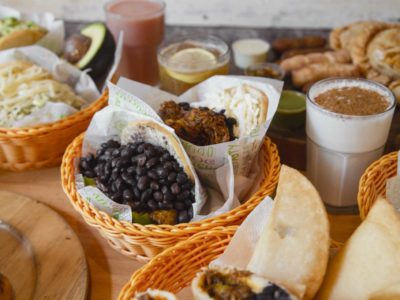
Venezuelan Food: 17 Dishes to try in Venezuela or at Home
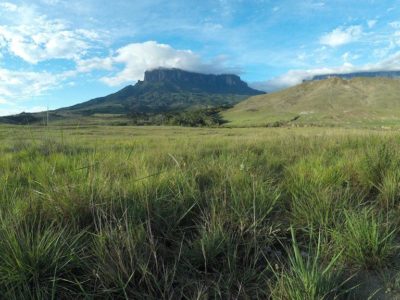

- DESTINATIONS
- EXPERIENCES

Venezuela is Open for Tourism: 8 Unbelievable Places to Visit in 2022
Venezuela is often skipped by travelers who are taking their grand tours of South America. Countries that are deemed safer and more politically stable – like Brazil and Chile – are normally the first choices for folks heading to Latin America. But for the experienced and adventurous traveler, there is no better country to visit on the continent than Venezuela. It’s so remarkably beautiful, home to some of the best places to visit on earth.
Despite political turmoil, the people here look on the brighter side of life and the incredible landscapes dotted across the country make that a lot easier. From Angel Falls to Los Roques, Venezuela is easily one of the most beautiful countries in South America. If visiting this gem of a country is on your bucket list for 2022 then we have some important tips for you.
Firstly, to book your travels with confidence, contact the team at Osprey Expeditions (founded by Ben Rodriguez). They have over 20 years of experience running tours and expeditions in Venezuela and Colombia – catering for solo backpackers, group trips and tour agencies. Osprey Expeditions has been recommended by the likes of Lonely Planet and the reviews of this company are simply the best you will find in Venezuela.
Secondly, you should know that Venezuela has an endless amount of places to visit, so narrowing down your selection is crucial. Along with the team at Osprey Expeditions, we have put together the 8 best places to visit in Venezuela for 2022. These destinations range from waterfalls to mountain tops to islands, and everything in between. With the country open again after the pandemic, there has never been a better time to go!
8 Best Places to Visit in Venezuela
1. angel falls, canaima national park.
Angel Falls needs no introduction. It’s the tallest waterfall in the world and a true wonder of the world. Standing at 979 meters, the majesty of this place will take your breath away! Combine the nature of Angel Falls with the surrounding beauty and ancestral culture found in Canaima National Park, and you have yourself one of the world’s greatest destinations.
Being at Angel Falls gives you the chance to reflect on this planet and your role in it. This park is one of the oldest places on earth – with pure and pristine nature found around every corner. The energy of the waterfall itself is electric. No photograph can do this place justice, you simply have to see it and feel it for yourself to appreciate this giant of Venezuela.
You can book an Angel Falls Expedition with Osprey Expeditions. They offer three itineraries for experiencing this waterfall: a 4-day, 5-day or 16-day trip (the 16-day itinerary includes Angel Falls, Mount Roraima and the Orinoco Delta). These trips involve everything from dense jungle walks, to river boat trips, to eating food with local tribes, to sleeping in hammocks. You will also get to visit other waterfalls along the way such as Hacha and Ucaima.
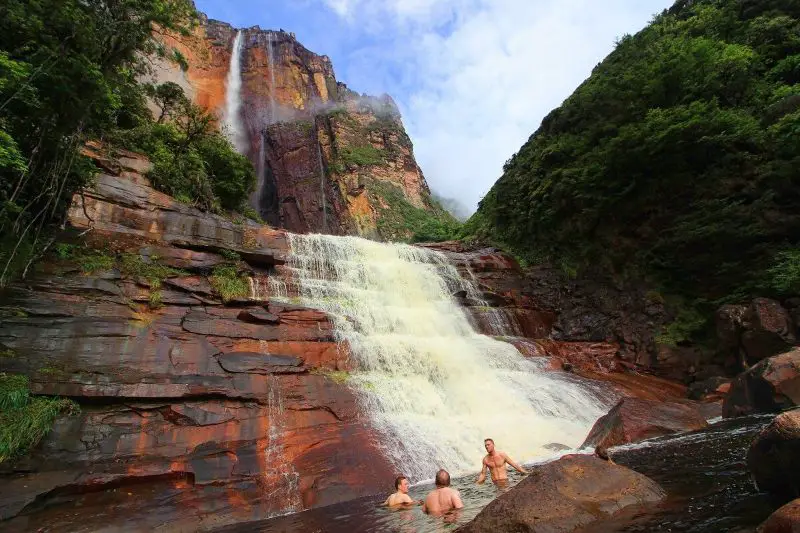
2. Mount Roraima, “The Lost World”
Mount Roraima shares a border with Venezuela, Brazil and Guyana. It has a sacred energy to it very much similar to Angel Falls. Roraima is the tallest table-top mountain in South America (known as tepuis , meaning “house of gods”, to the native people). This mountain reaches over 2,800 metres in height and is a whopping eight kilometers long!
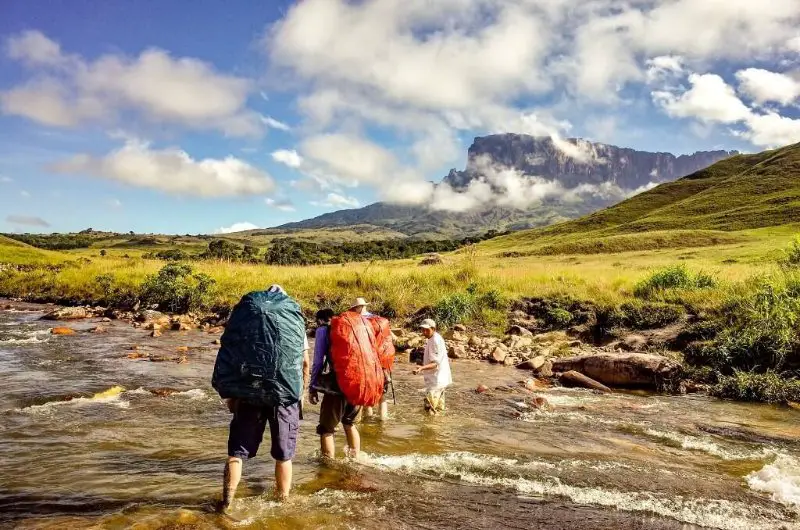
3. Los Roques National Park, Archipelago
Did you know that Venezuela has the longest Caribbean coastline in the world? This makes it a beach-lovers paradise! One of the best places to visit in Venezuela in the Caribbean Sea is Los Roques. This archipelago/national park is home to roughly 350 different islands, cays and islets – all boasting beautiful, white-sand beaches and shimmering turquoise waters.
You can take a flight to Gran Roque where the airport is located and then go island hopping. Some of the best islands to visit are Francisqui, Noronkey, Madrisqui, Crasqui and Dos Mosquises Islands. The weather is warm, the sun shines daily and the waters are perfect for snorkeling!
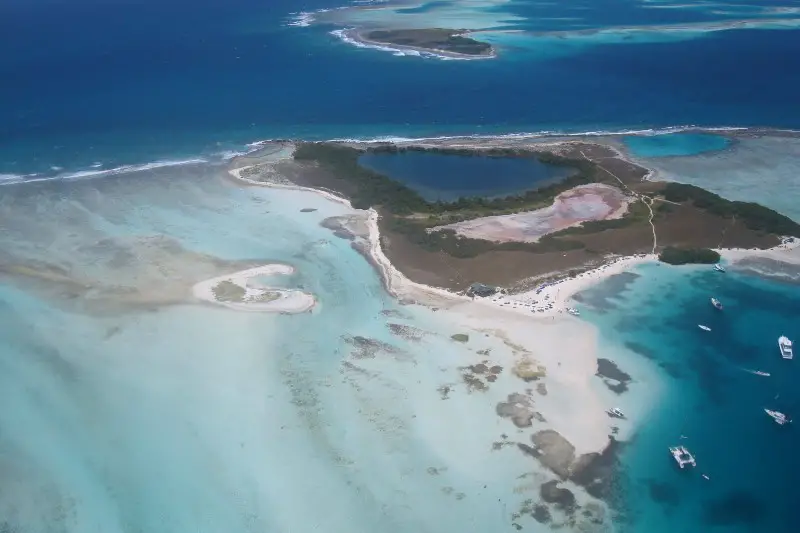
4. Orinoco Delta, Eastern Venezuela
The Orinoco Delta is one of the most unspoiled regions in the world. It’s a rich ecosystem of wetlands, wildlife and tribes. The indingeous people who call the delta home live in thatched huts which are all dispersed throughout the area. Development is almost non-existent. The only way to get around in Orinoco is on the river by boat or traditional canoe.
The most unique wildlife species here include Red Howler Monkeys, Giant River Otters, Toucans and Caimans. The variety and sheer number of different birds you will see in the delta is nothing short of remarkable! So as you can probably tell by now, the Orinoco Delta is a wildlife-lover’s dream.
Book your Orinoco Delta adventure with the team at Osprey and experience all the magical wildlife mentioned, and immerse yourself in the culture of the Warao communities – meeting villagers and craftsmen along the way. Your amazing Warao guide will give you the chance to try edible plants and juicy grubs of the delta (which is an experience in itself). Although, you will need to have a strong stomach for this!
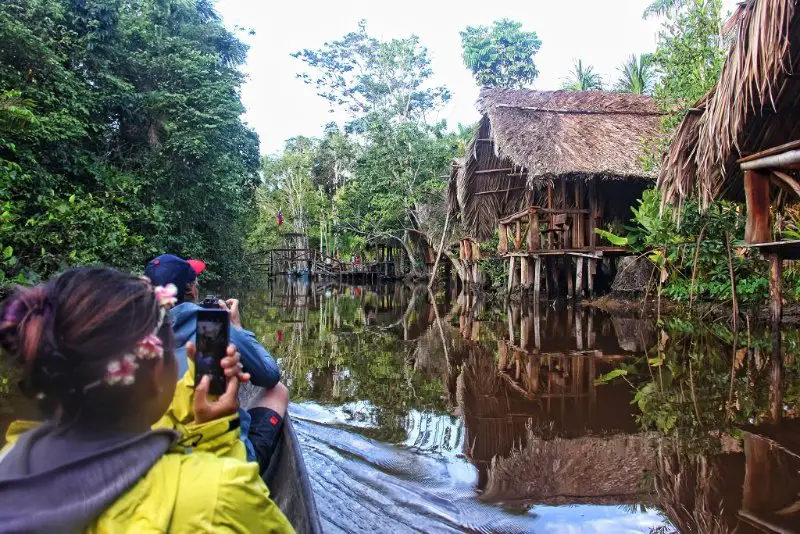
5. Catatumbo River, Near Lake Maracaibo
For a truly unique sight head to the Catatumbo River where it flows into Lake Maracaibo. It’s in this corner of the country where you find Catatumbo Lightning raging for 160 nights of the year, for 10 hours at a time. This is known as the “Relampago del Catatumbo”. Considered the most electric place on earth, this slice of Venezuela should definitely be on your list!
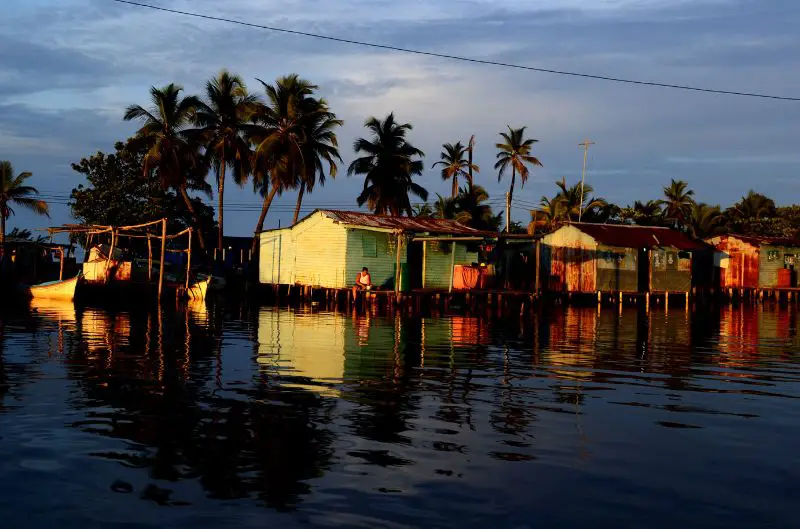
6. Caracas, Capital City of Venezuela
Join Osprey Expeditions for an exciting day tour of Caracas, the capital home to 2 million Venezuelans! On this day trip you will visit famous sights such as Simon Bolivar house, Plaza el Venezolano (San Jacinto) and the Panteon Boulevard situated in the Altagracia District. This can include pick-up at Simon Bolivar International Airport and transfers to your next tour, so you are fully looked after as soon as you arrive in the country.
7. Margarita Island, Caribbean Sea
If you’re looking for more beaches in Venezuela then head to Margarita Island! The beaches here are lovely but that’s not the only reason to visit. The island is also home to intricate mangroves, awesome little coastal towns and colonial old villages where the Spanish past is still felt today. In the interior of the island, you will discover high hills and lush vegetation – perfect for taking a hike or for a horseback riding adventure.
Indeed, by booking your Margarita Island trip with Osprey Expeditions you will be able to enjoy horseback riding, snorkeling and kayaking. The minimum stay here is for two days but you can always extend your trip for a few more days if you fall in love with this slice of Caribbean paradise.
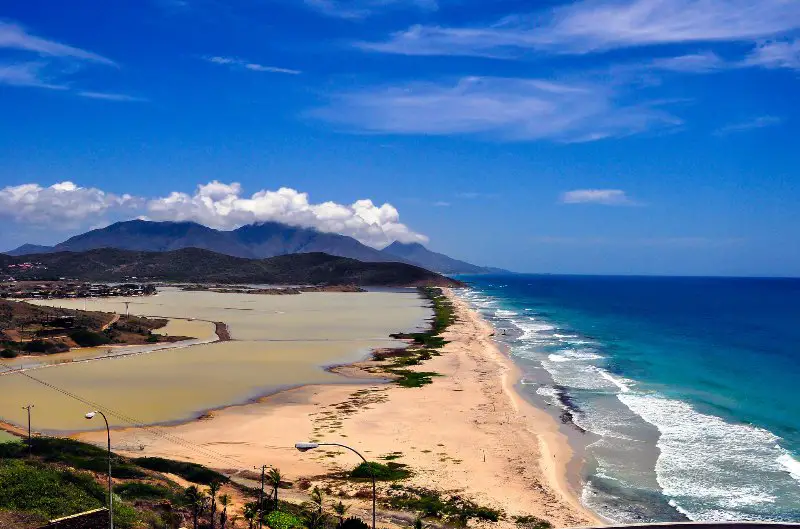
8. Choroni Locality, Northern Venezuela
Choroni is a coastal locality located in the north of Venezuela. This destination is well off-the-beaten-path and offers travelers a truly authentic experience. Beaches, waterfalls, hikes and more can all be enjoyed. The locals are notorious for their hospitality too. Ben Rodriguez, Director of Osprey Expeditions, recommends this as the perfect ending to your trip:
“Not only are the beaches great but the people are friendly. Here you can see how the local fishermen live. You should visit the pier and see how the fresh fish arrives to get traded. Also, if you have the energy, swim at Playa Grande by 6:30am to enjoy the dawn with clear waters. To me this is the ultimate way to finish a trip in Venezuela, it’s pure relaxation”.
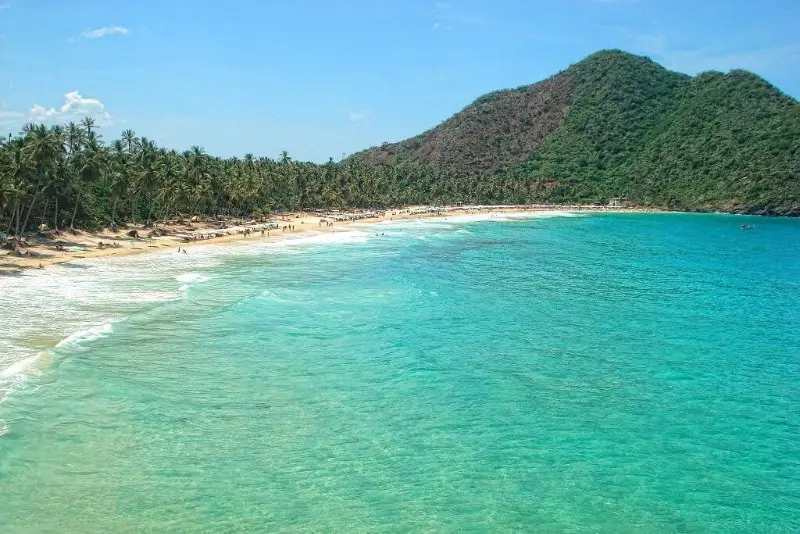
Need to Know Before you Go
Booking with a reputable company like Osprey Expeditions will give you a boost in confidence to travel to Venezuela for the first time. Their English speaking staff will meet you at the airport and look after you from start to finish, so you can focus on experiencing all of those epic places that Venezuela has to offer (instead of worrying about safety or logistics).
While the news media and government agencies paint a dark picture of Venezuela, the reality on the ground is that Venezuela is a safe country as long as you practice common sense. If you have trepidations about your safety, you should get out of the cities (like Caracas) and head to nature. You will find Venezuelans to be just as friendly as any other nation.
Most Venezuelans speak Spanish so if you took Spanish classes at school, make sure you brush up on it before you go! This will make a big difference to your experience as most people here don’t speak a word of English. But remember, the staff at Osprey Expeditions can speak English.
One of the biggest questions people have about Venezuela is visas and this changes depending on your nationality. The best option is to do extensive research online or call up the nearest Venezuelan embassy. They should be able to provide information on visa applications. Apart from that, just book your flights and tours with Osprey Expeditions, and then this gem of South America is waiting to greet you with open arms!

Author: Cameron Kennedy
Cam is a New Zealander who has been traveling the world since he was young. From family trips in Egypt and Jordan as a teenager, to solo backpacking South America at 18, to currently exploring Southeast Asia with his partner Kat - Cam is a traveler through and through.
Related posts

Leave a Reply Cancel reply
Your email address will not be published. Required fields are marked *
Save my name, email, and website in this browser for the next time I comment.
Post comment
Travel experiences
Accommodation.
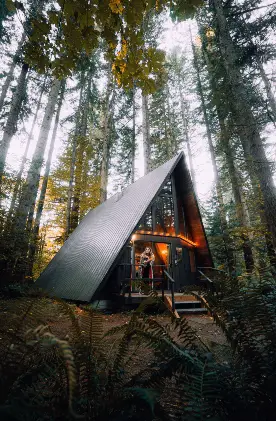
Beaches & Islands
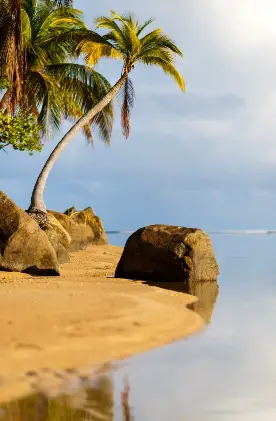
Food & Drink
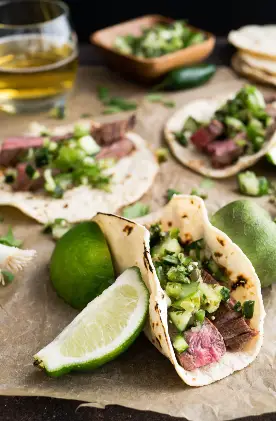
Historical Sites
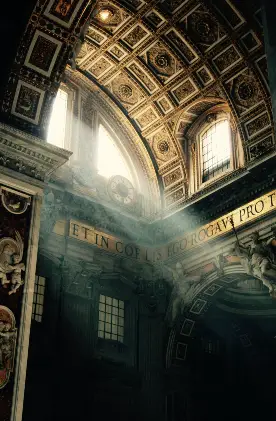
Living Abroad
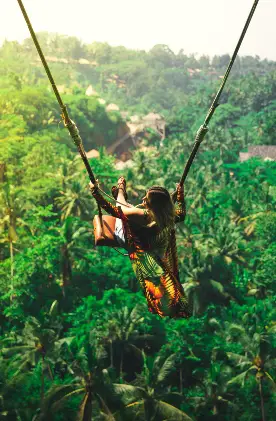
National Parks
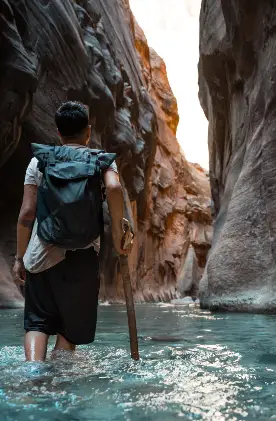
Towns & Villages
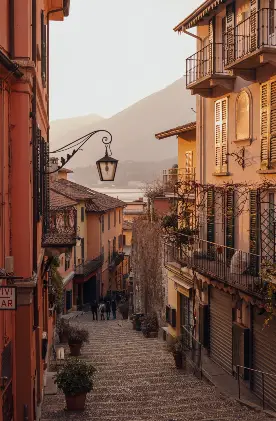
Travel Tips
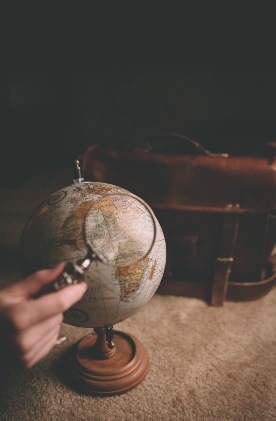
Sign up to our newsletter

Best places to visit in Venezuela
By Author Katie
Posted on Last updated: July 20, 2022
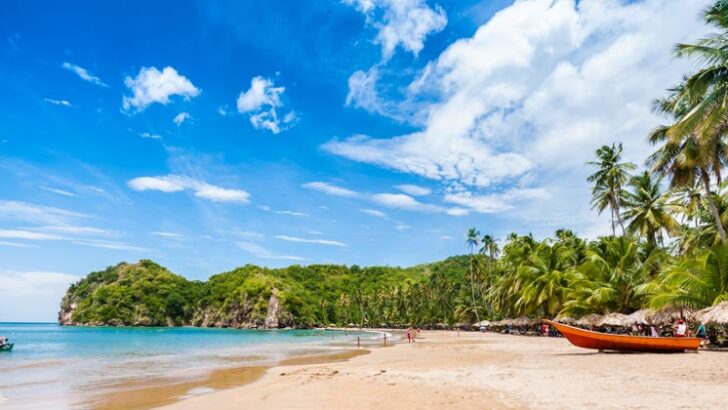
Heading to Venezuela? We share the best places to visit in Venezuela so you can plan a trip and enjoy all the best things to do in Venezuela.
Why visit Venezuela?
Venezuela, or the Bolivarian Republic of Venezuela, is a gorgeous country to visit on the northern coast of South America. Venezuela is full of vibrant culture, a wealth of natural habitats, and dry, tropical weather . The geography is very diverse, ranging from archipelagos, valleys, deserts, jungles, and mesas. These traits make tourists from all over the globe plan trips every year to visit Venezuela. But with all the exciting things there, it might be hard to decide what to do when you plan your trip there. We’re here to make things a little bit easier. Here are the top things to do in Venezuela!
Top things to do in Venezuela
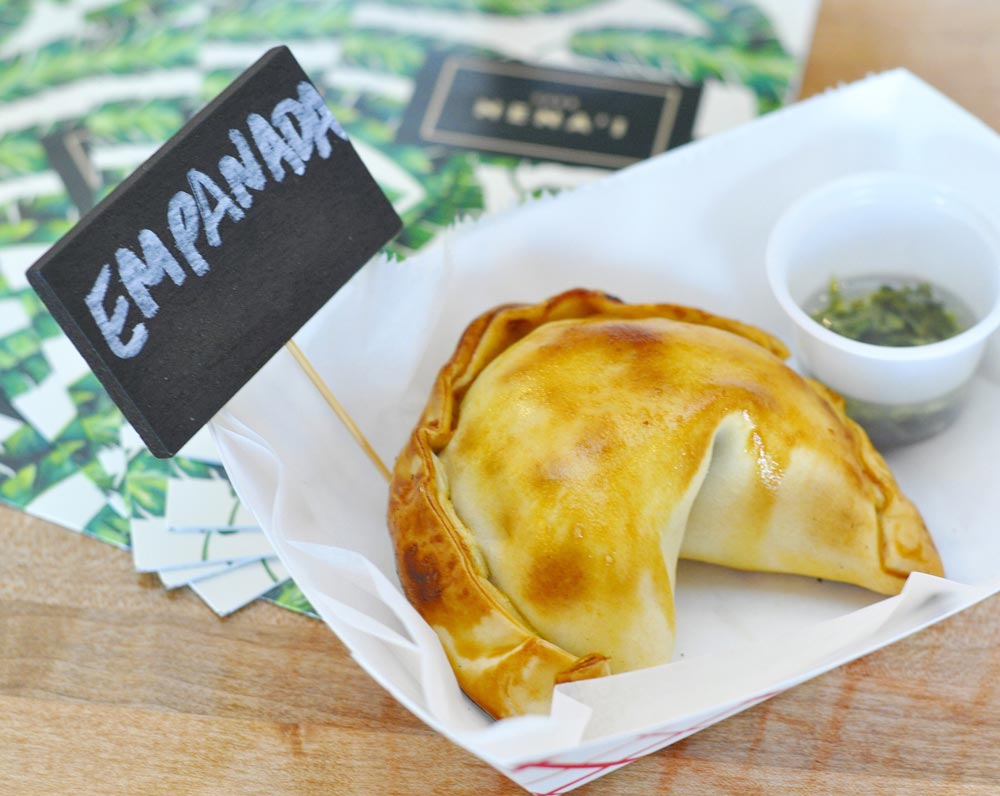
1. Try the Venezuelan Cuisine
Venezuelan cuisine is influenced by many different cultures, from their pre-Colombian roots to European and West African cuisine. Depending on where you go, regions of the country could also have widely different cuisine!
One food Venezuela is known for is its variety of fresh white cheese. A keystone of Venezuelan culture, the country has the most variety of cheeses in South America. One traditional cheesy dish that you can try is Cachapa.
A popular roadside meal, Cachapa is a dish made of corn dough pancake filled with traditional Venezuelan cheese, Queso de mano . Other fillings that go well with Cachapa are roast pork, jam, and cream. For a plate of Cachapas that you’ll never forget, Cachapera Doña Ines in Carretera de La Unión is the place to go. With their Cachapa recommended by ten food critics, you know you’re in for a treat.
For something a bit more filling, you can try out their national food, Pabellón Criollo. Pabellón Criollo consists of rice, shredded beef, and stewed black beans. The flavorful dish is also good with fried plantains, arepas (cornmeal cakes), or eggs.
For dessert, you should try Quesillo, a traditional dessert in Venezuela. Quesillo is a creamy flan-like custard that’s baked in a water bath. It’s Venezuela’s version of flan, with the difference being for Quesillo, the whole egg is used instead of just the yolk. Eating a slice of Quesillo is a sweet, creamy way to end your meal.
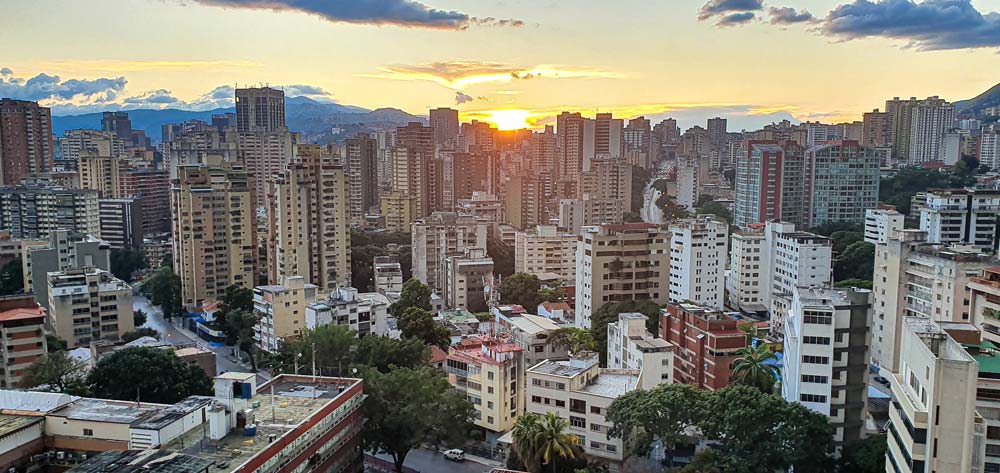
2. Visit the City of Caracas
Caracas is the capital city of Venezuela. Also known as Venezuela’s Culture Capital, the city is home to many cultural landmarks to explore.
One place to visit is the Panteón Nacional de Venezuela or the National Pantheon of Venezuela. The grand building was erected in the 1870s and is used to house the remains of Simón Bolívar, a national icon and one of the most revered heroes in South America.
The University City of Caracas is another building of great importance for Venezuelans. It is the main campus of the Central University of Venezuela, the highest-ranking institution in the country. Construction of the project began back in 1945 with the renowned Venezuelan architect Carlos Raúl Villanueva at the helm until around 1960.
The University City of Caracas is a masterpiece of urban planning, becoming an inspiration for Venezuelan architecture. It is also the only university campus in the 20th century to be designed by a single architect. With such impressive feats, it naturally became a UNESCO World Heritage Site in 2000.
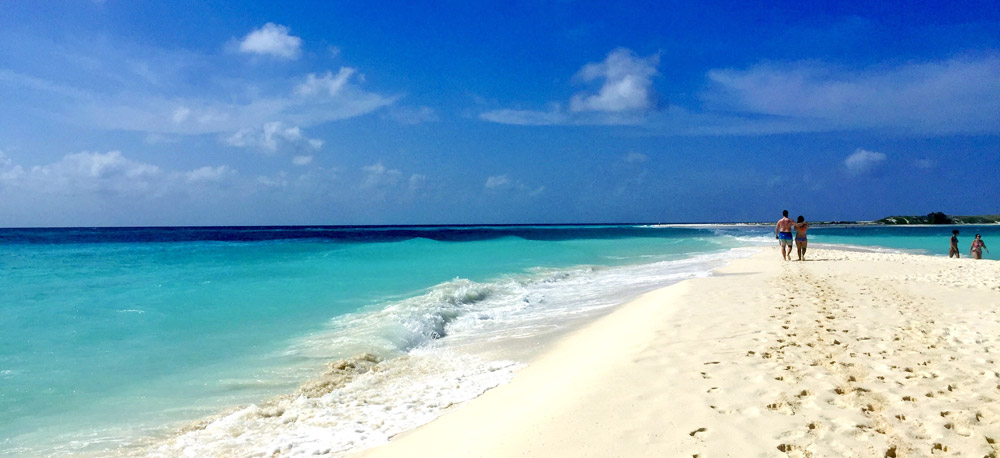
3. Bask in the Sun in Cayo de Agua
Cayo de Agua is a small island in the Los Roques Archipelago, a national park north of Venezuela. The archipelago hosts three important ecosystems, namely seagrass beds, coral reefs, and mangroves. These make the archipelago a crucial natural habitat in the Caribbean Sea.
Wildlife tourists will not be disappointed with the sea life here. The archipelago is home to numerous seabirds and countless sea creatures, dolphins, and plants. Loggerhead, green, and hawksbill turtles use the archipelago as a valuable nesting spot.
To get to Cayo de Agua and the archipelago itself, you will need to join an excursion group or hire a rental boat. But once you get there, the pristine white sands, tropical sun, and turquoise waters are a gorgeous sight sure to be worth the effort. Make sure to bring diving gear, since diving in the clear waters and coral reefs is one of the most popular activities there!
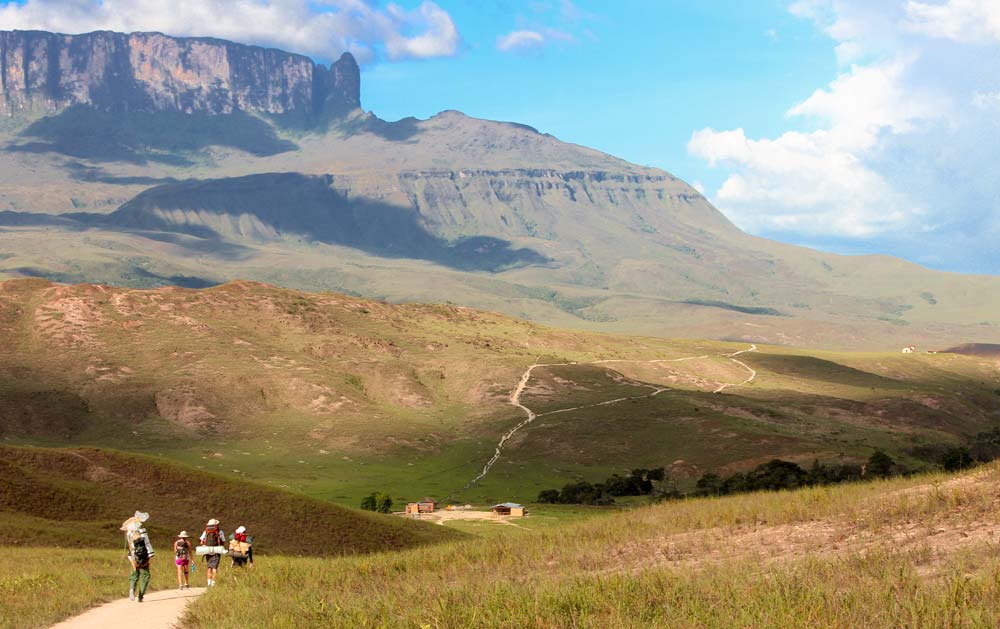
4. Hike Up the Mountain Island of Mount Roraima
Going back inland, the tepuis of Venezuela are some of the most alien and surreal geographies in the world. Tepuis are a kind of mesa found only in and around Venezuela. In the native Pemon tongue, the word tepui translates to “House of the Gods”, with their characteristic steep sides and flat tops, the tepuis are like islands in the sky. Due to their isolation combined with their different elevation, the biodiversity of the mesas can be very different from the surrounding wildlife, being home to endemic and rare plants and animals.
Mount Roraima is one such tepui. This mesa serves as a tripoint of the borders of Venezuela, Guaya, and Brazil, though most of the mountain lies within the Venezuelan border. It is also within Canaima National Park, the second largest park in Venezuela and a UNESCO World Heritage Site, making the park worth a visit all on its own.
Hiking to the tripoint marker in Mount Roraima is an exhilarating experience of traveling to a strange new world. As you ascend the steep sides of the mesa and hike on its top, you can feel your problems vanish as you find yourself immersed in a new world during your 6- to 8-day trek.
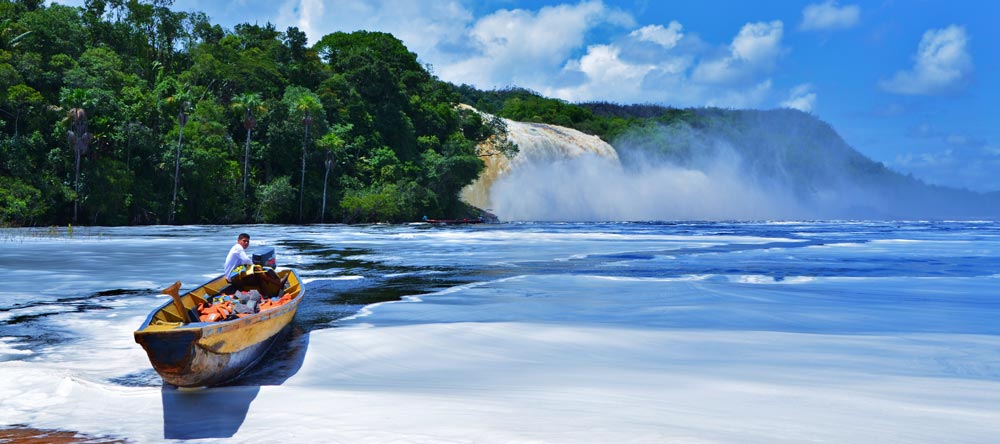
5. Travel to Angel Falls
The Angel Falls is a beautiful work of nature located on another tepui, the Auyán-tepui. The Auyán-tepui is also situated within the Canaima National Park and is the most popular tepui to visit. Known as Parakupá Vená or “The Fall From the Highest Point” in Pemon, the Angel Falls is known as the world’s tallest uninterrupted waterfall, with a plunge of 807 meters and a height of 979 meters. Because Angel Falls is in the middle of the wilderness of the Canaima National Park, the trip going there is quite the journey!
You can visit the falls at any time of the year, but you’ll have a different experience depending on when you go. If you go during the dry season (December to April), your trip to the falls will be sunny and pleasant. But if you desire to see Angel Falls at its most impressive, going during the rainy season would be the time for you. Just be warned that there is a higher chance that clouds might cover the majestic falls during your trip there. If you plan on going to Angel Falls or even Mount Roraima, planning and finding a guide is crucial for an enjoyable experience. Getting lost in the Venezuelan wilderness would not be a good time!
Whether food, history, culture, or nature, Venezuela is sure to provide the best. No matter where you go, from the cities to the beaches, jungles, and tepuis, there’s something magical about Venezuela to keep you captivated.
With proper planning , a trip to Venezuela may be the best vacation of your life. Grab some Queso de mano, rent a boat, and explore the lush forests, pristine waters, and exotic wildlife of Venezuela!
This site uses Akismet to reduce spam. Learn how your comment data is processed .

No videos yet!
Click on "Watch later" to put videos here
Venezuela Travel Guide – Everything You Need to Know

Venezuela, a country of stunning natural beauty and diverse landscapes, beckons travelers with its rich cultural heritage and vibrant traditions. Nestled in northern South America, this South American gem boasts the towering Andes Mountains, pristine Caribbean coastlines, and the mesmerizing wonders of the Amazon Rainforest. From exploring the vibrant streets of Caracas to unwinding on idyllic beaches and embarking on thrilling adventures in the wild, Venezuela offers a myriad of experiences for the adventurous traveler. Explore the country’s unique mix of cultures, savor its flavorful cuisine, and discover its remarkable biodiversity in the heart of Latin America.
What’s the Best Time to Visit? 📅
The best time to visit Venezuela as a tourist largely depends on your preferences and the type of experiences you seek, as the country has diverse climates and attractions. Here are two distinct seasons to consider:
- Dry Season (December to April): This is generally the most popular time to visit Venezuela. During the dry season, you can expect pleasant weather with clear skies and minimal rainfall. It’s an excellent time for outdoor activities, hiking, and exploring the country’s natural wonders, such as Angel Falls and Canaima National Park. Coastal areas, including the Caribbean beaches, are also great for sunbathing and water sports during this period.
- Rainy Season (May to November): The rainy season in Venezuela can bring heavy rains and occasional flooding, especially in low-lying areas. However, this period is ideal for birdwatching, as migratory birds flock to the country’s wetlands and rainforests. The lush landscapes and waterfalls are at their most impressive during the rainy season. Keep in mind that some roads and outdoor activities may be disrupted by rain.
It’s important to note that Venezuela’s climate can vary from region to region due to its diverse geography. Coastal areas have a tropical climate, while the Andes Mountains experience cooler temperatures. The Amazon Rainforest region is hot and humid year-round.
Before planning your trip, check the specific weather conditions for the regions you intend to visit and consider your preferred activities. Additionally, keep abreast of travel advisories and the current political and safety situation in Venezuela, as this can affect your travel plans.
What’s the Best Way to Get Around? 🚌
Getting around Venezuela as a tourist can be both an adventure and a logistical challenge due to the country’s varying geography and infrastructure. Here are the main transportation options for travelers in Venezuela:
- Domestic Flights: Domestic flights are a popular and convenient way to cover long distances quickly. Major cities like Caracas, Maracaibo, Valencia, and Mérida have airports with regular flights. Smaller towns and remote areas may have limited or seasonal flight options.
- Buses: Buses are a common mode of transportation for both short and long journeys within Venezuela. There are various types of buses, including luxury coaches and local buses. The quality and comfort of buses can vary, so choose reputable bus companies for long-distance travel.
- Collectivos: These shared vans or minibuses operate on fixed routes and are a cost-effective way to travel within cities and to nearby towns. They can be crowded but offer a more flexible schedule than buses.
- Taxis: Taxis are widely available in cities, and they can be an efficient way to get around, especially for short distances. Ensure that the taxi has a working meter, or agree on the fare in advance. In some areas, shared taxis (colectivos) are common.
- Motorcycle Taxis: Motorcycle taxis, known as “mototaxis,” are a popular mode of transportation in some cities and towns. Negotiate the fare before the ride and prioritize safety by wearing a helmet.
- Car Rentals: Renting a car can provide flexibility, especially for exploring remote areas and national parks. However, road conditions can vary, and driving in Venezuela may require familiarity with local traffic rules and safety precautions.
- Ferries: If you plan to visit islands or coastal areas, ferries are available. Popular destinations include Margarita Island and Los Roques Archipelago.
- Trains: Venezuela has limited passenger train services, and they are not commonly used by tourists for transportation. Trains may be more of a scenic experience than a practical means of travel.
- Walking: In cities and towns, walking can be a pleasant way to explore local neighborhoods and attractions. Be aware of traffic and pedestrian safety.
- Cable Cars: Some areas, such as Mérida, offer cable car systems that provide stunning views of the surrounding landscapes. These are more of a tourist attraction than a mode of transportation.
It’s important to note that the political and economic situation in Venezuela can affect transportation services and safety. Travelers should stay informed about the current conditions, follow any travel advisories, and exercise caution when moving around the country.
Additionally, while traveling within Venezuela, always carry essential items like water, snacks, and cash, as access to services may be limited in some regions. Be prepared for unexpected delays and changes in plans, and prioritize safety in all your travel choices.
What’s the Official Language?
The official language of Venezuela is Spanish. Here are some basic Spanish phrases and words that can be helpful for tourists:
- Hello – Hola (oh-lah)
- Good morning – Buenos días (bway-nos dee-ahs)
- Good afternoon – Buenas tardes (bway-nas tar-days)
- Good evening / Good night – Buenas noches (bway-nas noh-chays)
- Please – Por favor (por fah-vor)
- Thank you – Gracias (grah-syahs)
- Yes – Sí (see)
- No – No (noh)
- Excuse me / I’m sorry – Perdón (pair-don)
- What is your name? – ¿Cómo te llamas? (koh-moh teh yah-mahs?)
- My name is [Your Name] – Me llamo [Your Name] (meh yah-moh [Your Name])
- How much is this? – ¿Cuánto cuesta esto? (kwan-to kwesta eh-sto?)
- Water – Agua (ah-gwah)
- Food – Comida (koh-mee-dah)
- Bathroom / Toilet – Baño (bahn-yoh)
- Help – Ayuda (ah-yoo-dah)
- I don’t understand – No entiendo (noh en-tee-ehn-doh)
- I need assistance – Necesito ayuda (neh-seh-see-toh ah-yoo-dah)
- Where is…? – ¿Dónde está…? (don-deh ehs-tah…?)
- I’m lost – Estoy perdido/a (ehs-toy pair-dee-doh/ah)
Learning some basic Spanish phrases can enhance your travel experience in Venezuela, as many Venezuelans may have limited proficiency in English, especially in rural areas. Being able to communicate in Spanish will help you navigate and interact more easily with locals.
Where to Stay? 🏨
Venezuela offers a range of accommodation options for tourists, from luxury hotels to budget-friendly guesthouses and hostels. Where you choose to stay depends on your budget, travel itinerary, and preferences. Here are some popular places to consider when looking for accommodation in Venezuela:
- Caracas: As the capital and largest city, Caracas has a wide selection of hotels, including upscale options in the Altamira and Las Mercedes neighborhoods. It’s a convenient base for exploring the city’s cultural attractions and museums.
- Margarita Island: Known for its stunning beaches, Margarita Island offers a variety of beachfront resorts, boutique hotels, and vacation rentals. Popular areas to stay include Playa El Agua and Playa Parguito.
- Los Roques Archipelago: If you’re looking for an idyllic beach getaway, consider staying in one of the eco-lodges or posadas on Los Roques. This national park is famous for its white-sand beaches and crystal-clear waters.
- Canaima National Park: For a unique experience, stay in a camp or lodge within Canaima National Park. It’s the gateway to Angel Falls and offers an opportunity to immerse yourself in the natural beauty of the region.
- Mérida: This Andean city is popular among travelers for its outdoor activities and cultural attractions. Mérida has a range of accommodations, from boutique hotels to hostels catering to backpackers.
- Maracaibo: The second-largest city in Venezuela, Maracaibo offers various hotels and guesthouses. It’s known for its lively atmosphere and the famous Maracaibo Lake.
- Puerto La Cruz: This coastal city along the Caribbean coast has numerous beachfront resorts and hotels, making it a suitable destination for relaxation and water activities.
- Andes Region: If you’re interested in exploring the Andes Mountains and its beautiful landscapes, consider staying in towns like San Cristóbal or Trujillo, where you can find guesthouses and lodges.
- Amazon Region: Lodges and eco-friendly accommodations are available for those exploring the Amazon Rainforest in southern Venezuela.
- Small Coastal Towns: Along the Caribbean coast, there are charming small towns and fishing villages where you can find budget-friendly accommodations, providing an authentic and peaceful experience.
- Hostels and Guesthouses: Throughout Venezuela, you can find hostels and guesthouses that cater to backpackers and budget-conscious travelers. These are often more affordable options with a communal atmosphere.
Keep in mind that the political and economic situation in Venezuela has affected the availability and quality of accommodations in some areas. Before booking, research the current status of the accommodation, read reviews, and check for any travel advisories. It’s advisable to book accommodations in advance, especially during peak tourist seasons, and carry sufficient cash, as credit card acceptance may be limited in some places.
What to Eat? 🍽️
Venezuela boasts a rich culinary heritage, with a variety of delicious dishes that reflect its diverse culture and ingredients. Here are some must-try Venezuelan foods for tourists:
- Arepas: These versatile and iconic Venezuelan snacks are made from cornmeal and can be stuffed with a variety of fillings such as cheese, shredded beef, chicken, or beans. They are a staple of Venezuelan cuisine and come in various shapes and sizes.
- Pabellón Criollo: This traditional Venezuelan dish consists of shredded beef, black beans, white rice, and fried plantains. It’s often accompanied by a simple salad or avocado.
- Empanadas: Venezuelan empanadas are savory turnovers filled with ingredients like ground beef, cheese, chicken, or seafood. They’re deep-fried to crispy perfection and make for a popular street food snack.
- Cachapas: Cachapas are thick, sweet corn pancakes made from fresh corn kernels. They are usually served with cheese or a slice of salty cheese, creating a delightful sweet-savory combination.
- Tequeños: These are cheese-filled sticks or rolls wrapped in thin dough and fried until golden brown. Tequeños are a popular appetizer or snack in Venezuela.
- Hallaca: Often prepared during the Christmas season, hallacas are a type of tamale made with a cornmeal dough filled with a mixture of meat, olives, capers, raisins, and spices. The hallaca is wrapped in plantain leaves and boiled.
- Caraotas Negras: This dish features black beans cooked with spices, including onions, bell peppers, and garlic. It’s often served as a side dish with rice and meat.
- Chicha: A traditional Venezuelan drink made from fermented rice or maize. It can be sweet or slightly fermented and is often flavored with cinnamon or vanilla.
- Pepitona: A popular seafood dish, pepitona features small, marinated sea snails served with a tangy sauce. It’s a coastal delicacy.
- Pescado Frito: Enjoy a taste of the Caribbean with deep-fried fish, often served with sides like coconut rice, fried plantains, and a zesty garlic sauce.
- Ajiaco: This hearty soup features a variety of vegetables and meats, including beef, chicken, and pork. It’s seasoned with spices and herbs, making it a flavorful comfort food.
- Tizana: A refreshing fruit punch made with a mix of tropical fruits, such as papaya, watermelon, and pineapple, served with ice and sometimes a splash of rum.
- Dulce de Lechosa: A sweet treat made from green papaya cooked with sugar and spices until it becomes a thick, syrupy dessert.
- Cachito: A savory pastry filled with ham or other ingredients, perfect for breakfast or a quick snack.
- Quesillo: A Venezuelan flan dessert made from condensed milk, eggs, sugar, and vanilla, often drizzled with caramel sauce.
Exploring Venezuelan cuisine is an integral part of experiencing the country’s culture. Whether you’re dining at a local restaurant, enjoying street food, or savoring traditional dishes, you’ll find a rich tapestry of flavors to delight your taste buds.
What to See? 🔍
Venezuela is blessed with an array of stunning natural landscapes, historic sites, and vibrant cities that offer a wide range of must-see attractions for tourists. Here are some of the top places to visit in Venezuela:
- Angel Falls: The world’s highest uninterrupted waterfall, Angel Falls is a breathtaking natural wonder located in Canaima National Park. You can take guided tours to witness this awe-inspiring sight.
- Canaima National Park: This UNESCO World Heritage Site is renowned for its dramatic tabletop mountains, lush jungles, and pristine waterfalls. Explore the park’s diverse ecosystems, including the Gran Sabana region.
- Mérida: This charming Andean city is known for the Mérida Cable Car, one of the world’s highest cable cars. It offers stunning views of the Andes Mountains and opportunities for hiking and adventure sports.
- Los Roques Archipelago: An idyllic Caribbean paradise, Los Roques is famous for its white sandy beaches, crystal-clear waters, and excellent snorkeling and diving. It’s a protected national park and marine reserve.
- Margarita Island: This island in the Caribbean Sea boasts beautiful beaches, including Playa El Agua and Playa Parguito. It’s a popular destination for relaxation and water sports.
- Morrocoy National Park: A coastal gem, Morrocoy National Park features a labyrinth of cays, islets, and pristine beaches. It’s an ideal spot for boating, snorkeling, and sunbathing.
- Roraima: Trek to Mount Roraima, one of the table mountains known as tepuis. This challenging adventure offers unique landscapes and the opportunity to explore unique flora and fauna.
- Orinoco Delta: Discover the biodiversity of the Orinoco Delta by taking boat tours through its intricate network of waterways. It’s a paradise for birdwatchers and nature enthusiasts.
- Medanos de Coro National Park: Explore the vast sand dunes of Medanos de Coro, a surreal desert landscape located near the city of Coro. Sandboarding is a popular activity here.
- Historic Cities: Visit the historic cities of Coro and Ciudad Bolívar, both UNESCO World Heritage Sites, to admire well-preserved colonial architecture and learn about Venezuela’s history.
- Parque Nacional Henri Pittier: Venezuela’s first national park, Henri Pittier offers a diverse range of flora and fauna, along with hiking trails and beautiful beaches.
- Caracas: The capital city of Venezuela, Caracas is home to cultural attractions such as the National Pantheon, Bolívar Square, and numerous museums.
- Cerro Autana: An isolated tabletop mountain in the Amazon Rainforest, Cerro Autana is a remote and challenging destination for adventurous trekkers.
- Cueva del Guácharo National Park: Explore the cave system in this park, home to thousands of oilbirds (guácharos). Guided tours take you deep into the caves to witness these unique nocturnal birds.
- La Gran Sabana: This vast savannah region in southeastern Venezuela is known for its unusual flat-topped mountains, known as tepuis. Explore the indigenous Pemon villages and stunning landscapes.
Remember to check the current safety and travel advisories before planning your visit to Venezuela, as the country has faced challenges in recent years. Additionally, it’s advisable to travel with a local guide, especially when visiting remote or less-developed areas.
What to Do? 📸
Venezuela offers a wide range of exciting and enriching experiences for tourists. Here are some must-do activities and things to enjoy during your visit to this diverse South American country:
- Visit Angel Falls: Witness the world’s highest uninterrupted waterfall, Angel Falls, by taking a guided tour to Canaima National Park. The hike and boat trip to the falls offer incredible views.
- Explore Canaima National Park: Immerse yourself in the beauty of this UNESCO World Heritage Site, known for its tabletop mountains, stunning landscapes, and indigenous Pemon culture.
- Hike Roraima: Embark on a challenging trek to Mount Roraima, one of Venezuela’s iconic table mountains (tepui), to experience unique landscapes and a sense of adventure.
- Enjoy the Beaches: Relax on the Caribbean beaches of Margarita Island, Los Roques, and Morrocoy National Park. Try water sports like snorkeling, diving, and windsurfing.
- Go Wildlife Watching: Explore Venezuela’s diverse ecosystems and spot unique wildlife, including jaguars, capybaras, caimans, and various bird species in national parks and reserves.
- Try Traditional Venezuelan Cuisine: Savor delicious Venezuelan dishes like arepas, pabellón criollo, cachapas, and empanadas. Don’t forget to try local specialties in each region.
- Experience Mérida Cable Car: Take a thrilling ride on the Mérida Cable Car, one of the world’s highest cable cars, and enjoy panoramic views of the Andes Mountains.
- Visit Los Llanos: Explore the vast plains of Los Llanos, where you can go on wildlife safaris, ride horses, and experience the traditional cowboy culture of Venezuela.
- Discover Orinoco Delta: Take boat tours through the intricate waterways of the Orinoco Delta, where you can observe wildlife and learn about the indigenous Warao culture.
- Sandboard in Medanos de Coro: Try sandboarding on the dramatic sand dunes of Medanos de Coro National Park near Coro. It’s a thrilling and unique experience.
- Explore Historic Cities: Visit UNESCO-listed cities like Coro and Ciudad Bolívar to admire colonial architecture and learn about the country’s history.
- Go Birdwatching: Venezuela is a paradise for birdwatchers, with diverse avian species found in national parks and rainforests. Don’t forget your binoculars.
- Stargaze in the Andes: Head to the Andes region, such as Mérida, for excellent stargazing opportunities. The clear mountain skies make it ideal for astronomy enthusiasts.
- Discover Indigenous Culture: Learn about the indigenous cultures of Venezuela by visiting Pemon villages in the Gran Sabana or Warao communities in the Orinoco Delta.
- Enjoy Traditional Music and Dance: Attend local festivals and events to experience traditional Venezuelan music genres like joropo and salsa, and witness lively dance performances.
- Cave Exploration: Explore the underground world of Venezuela by visiting caves like Cueva del Guácharo National Park, known for its oilbirds (guácharos).
- Climb Cerro Autana: For the ultimate adventure, embark on a challenging trek to the remote Cerro Autana, an isolated tepui in the Amazon Rainforest.
- Take a Boat Tour to Remote Islands: Discover remote islands and pristine beaches by taking boat tours to places like Los Testigos and Cubagua Island.
- Learn About Cocoa Production: Visit cocoa plantations and learn about the process of making chocolate, an important part of Venezuela’s agricultural heritage.
- Immerse in the Amazon Rainforest: Explore the diverse ecosystems of the Amazon Rainforest, from wildlife watching to learning about medicinal plants from indigenous guides.
Before planning your activities in Venezuela, it’s essential to check the current travel advisories, safety conditions, and any specific requirements for certain destinations or activities. Additionally, consider the seasonal variations in weather when planning outdoor adventures.
Culture and Safety 🦺
Traveling to Venezuela as a tourist can be a rewarding experience, but it’s important to be aware of the local culture and take safety precautions due to certain challenges in the country. Here are some cultural and safety tips for tourists in Venezuela:
- Respect Local Customs: Venezuelans are generally warm and welcoming. Politeness and respect for local customs are appreciated. Greet people with a friendly “Hola” (hello) and use polite titles such as “Señor” (Mr.) or “Señora” (Mrs.) when addressing individuals.
- Learn Basic Spanish: While some Venezuelans may speak English, especially in tourist areas, having a basic understanding of Spanish can enhance your experience and facilitate communication with locals.
- Dress Modestly: In urban areas, casual attire is generally acceptable. However, in more conservative or rural areas, it’s advisable to dress modestly and avoid revealing clothing.
- Be Respectful of Religion: Venezuela has a predominantly Catholic population, and religious traditions are significant. Be respectful when visiting churches and religious sites.
- Tipping: Tipping is customary in restaurants, and a tip of around 10% is generally appreciated. Tipping for other services, such as guided tours or hotel staff, is also customary.
- Safety in Numbers: It’s often safer to explore cities and attractions in groups or with a guide, especially in less touristy areas.
- Photography: Always ask for permission before taking photos of people, especially in indigenous communities or sensitive areas. In some cases, photography may be restricted.
- Stay Informed: Keep up-to-date with the latest travel advisories and safety information for Venezuela. The political and economic situation in the country can affect safety conditions.
- Avoid Risky Areas: Some areas of Venezuela may have higher crime rates and security concerns. Research your destination and be cautious when traveling in unfamiliar neighborhoods, particularly at night.
- Use Reputable Transportation: Choose well-established and reputable transportation providers, especially when using taxis or public transportation. Always confirm the fare or use metered taxis.
- Carry a Copy of Documents: Make photocopies of your passport, visa, and important documents, and keep them in a separate location from the originals. Leave a copy with a trusted contact at home.
- Money Safety: Be cautious when handling money and avoid displaying large sums of cash in public. Use ATMs in well-lit and secure locations.
- Avoid Political Protests: Steer clear of political demonstrations, rallies, and gatherings, as these can become volatile. Stay informed about any planned protests in the area.
- Stay Hydrated and Informed: Venezuela’s tropical climate can be hot and humid. Stay hydrated, use sunscreen, and be prepared for varying weather conditions.
- Emergency Numbers: Familiarize yourself with local emergency contact numbers for medical services, authorities, and your embassy or consulate.
- Travel Insurance: Ensure you have comprehensive travel insurance that covers medical emergencies, evacuations, and theft or loss of belongings.
- Use Caution at Border Areas: If traveling near Venezuela’s borders, be aware of potential security risks and immigration requirements. Check the latest information regarding border crossings.
While Venezuela offers many attractions and cultural experiences, it’s essential to exercise caution and stay informed during your visit. Be flexible with your travel plans, as conditions can change rapidly. Always prioritize your safety and well-being while exploring this beautiful country.
In conclusion, Venezuela captivates tourists with its breathtaking natural landscapes, rich cultural tapestry, and warm hospitality. From the Andes Mountains to the Caribbean coast, this South American nation offers diverse experiences for travelers. However, it’s crucial to consider safety and be mindful of the current political and economic situation in the country. With proper planning and precautions, visitors can uncover the hidden treasures of Venezuela, making it a rewarding and unforgettable destination for those seeking adventure and exploration.
You may also like

State of Palestine Travel Guide – Everything You Need to Know

South Sudan Travel Guide – Everything You Need to Know

Democratic Republic of the Congo Travel Guide – Everything You Need to Know
Travel destinations.
- Experiencing Australia 20
- Experiencing Cambodia 5
- Experiencing China 24
- Experiencing Cruise 6
- Experiencing France 5
- Experiencing Germany 3
- Experiencing Indonesia 10
- Experiencing Italy 11
- Experiencing Japan 10
- Experiencing Korea 7
- Experiencing Malaysia 6
- Experiencing Maldives 7
- Experiencing Myanmar 10
- Experiencing New Zealand 17
- Experiencing Singapore 15
- Experiencing Switzerland 4
- Experiencing Taiwan 14
- Experiencing Thailand 18
- Experiencing Vietnam 5
Top Things to Do in Venezuela
Places to visit in venezuela, explore popular experiences, popular cities in venezuela.

Top Attractions in Venezuela

What travellers are saying

Best places to visit Venezuela
- January 16, 2023
- Ben Rodriguez

Here I enlist the 10 most interesting from my point of view, those that in 20 years with Osprey Expeditions I have been able to define as the most important ones.
Canaima National Park
Canaima National Park was decreed as such by the National Government on June 12th, 1962, with an area of one million hectares (1,000,000 Ha.), which was increased to three million hectares (3,000,000 Ha.) on October 10th, 1975, making it one of the largest national parks in the world. It is located in Venezuela’ s Guayana region, South of the Orinoco River , in the Gran Sabana Autonomous Municipality and the Sifontes Municipality in Bolívar State . Canaima National Park is truly one of the world’s greatest natural wonders, op by its very size and because of its joi spectacular scenery and vast natural resources. It is crossed by huge rapids as well as slow, majestic rivers, which flow TI in marked contrast to the thick jungle of this paradise, reflecting the variety of green hues as they blend with the water. On the plains, the rivers weave across the open grasslands, interrupting their course only at the many indescribable waterfalls that are the common feature of Guayana , Venezuela . The rolling scenery meets the legendary tepuis , table-top mountains which rise abruptly, with polychromatic vertical walls transporting the spectator back over thousands of years and showing the Earth’s physio chronology as if in an open book. Exuberant wildlife and flora = join in a variegated concert of living beings, with intense color and light in harmonious natural surroundings. The daily spectacle includes jungles, forest, grasslands, mountains, strong winds and torrential rains, which give way to wide, blue skies. In this landscape beyond comparison one cannot forget the human element Indian communities found in Canaima National Park are made up of members of the Pemón group. Even though they have been influenced by other cultures as a whole, they maintain their own culture and traditions. Canaima is The Lost World , a place to be revered and preserved.
Tepuis Among the main features in Canaima National Park , we find the tepuis with their vertical walls carved by the erosion of millions of years. Tepui walls are composed of poly chrome sandstone, quartz and agglomerates, which emerge abruptly out of the grasslands and thick jungles. Tepuis have flat, slightly sloping tops, where plant life is endemic. Scientific men have termed the table-tops island in time or ecological islands. The very peculiarities of these mountains, especially the plant life at the table-tops, make these ecosystems unique. Rising up through the clouds, the beholder cannot help but feel he is traveling back in time.
Climate Most Canaima National Park is under the influence of Equatorial Climate. The park’s average temperature is 10°C to 21°C . The average annual precipitation varies between 1,500 and with rather pronounced two seasons: period of relative dryness between January and April, and rainy season between May and December.
Geology The most ancient rock formations in the world’s geo chronology are found in Canaima National Park . Dating from the Precambrian period, they are assumed to have been formed between 1,5 and 2 billion years ago. These rock formations belong to the Guayana Shield .
All these places look great, right? To be frank, Canaima is just full of many places like them, there are 1000’s of waterfalls, caves, canyons, grottos, rock formations, unique spots that would be a Top notch attraction anywhere else but they are still not even photographed/named/ known in Canaima or Venezuela. Distances are huge! You see the map and they look so close, looks like a walk in the park but in reality you need to join an expedition and have a big budget, logistics to reach them. For Angel Falls you need a minimum of 4 full days. There are flights on Thursdays and Sundays, only one airline available. We have departures at least once a month and run our expeditions with small groups only. Keep reading our website, sure you will find more valuable information. Roraima, you need a minimum of 6 days for the trek + 2-3 travel days. We have at least 1 departure every 2 months. Let's talk about the different possibilities we can offer you Ben Rodriguez

- Angel Falls
It is the world’s tallest uninterrupted waterfall, with a height of 979 metres. The waterfall starts on the top of the Auyán-tepui mountain in the Canaima National Park, a UNESCO World Heritage site in the region of Bolívar State, Venezuela.
Mount Roraima
is one of the world’s most extraordinary natural geological formations and the highest of South America’s Pakaraima Mountains. The 31-square-kilometer summit area is defined by 400-meter-tall cliffs on all sides and includes the borders of Brazil, Venezuela, and Guyana.

Gran Sabana
is a region in southeastern Venezuela that offers one of the most unusual landscapes in the world, with rivers, waterfalls and gorges, deep and vast valleys, as well as impenetrable jungles and savannas. The region also hosts the isolated tabletop mesas known as tepuis.
Los Roques Archipelago
The Los Roques archipelago comprises about 42 small islands that encircle a lagoon spanning approximately 400km. In the northeast, the El Gran Roque rises with its meager heights, consisting of three lighthouses and a network of small houses formerly belonging to fishermen who hailed from Margarita Island . The remaining keys in the archipelago are flat and abandoned, but abound with various bird species. However, the real marvels of Los Roques are found beyond the land, extending down to the sea’s depths. The coral reefs create an underwater world that is breathtakingly beautiful, yet delicate, with an incredible variety of marine life, amidst an unimaginable blend of greens and blues. The tropical light bathing the Los Roques sea presents visitors with a paradise replete with brilliant colors, densely populated, and magnificently crafted by marine creatures. Despite its name, Los Roques has hardly any rocks. The island’s only rocks end in the cliffs of El Gran Roque , making the name unsuitable for the surrounding landscape, which is dominated by the sea and sand. In Los Roques, the light illuminates every corner, making it a perfect hostess for visitors.
Marine Ecosystems The archipelago boasts an impressive variety of species, particularly within its coral reefs, which hold significant biological, ecological, physiographic, and scenic value. The marine fauna and oceanic life found within the reefs are infinitely more diverse and valuable than the species found on land. Coral reefs are exceptionally diverse environments, characterized by small areas of rough and calm waters, fluctuations in temperature, and bright and shady areas with an abundance of nutrients, generating habitats for various species of fish, such as the ocean surgeonfish, angelfish, and spotfin butterflyfish. These species have adapted specifically to life on the coral reef, with some, like the flashy cleaner fish , cleaning other fish, while others, like the parrotfish , scrape polyps off the calcareous surface of the corals with their mandibles. Surrounding the reef, there are barracudas , nurse sharks , various species of rays and manta rays , and enormous screens of plankton. The snappers , yellowtail snappers , and groupers found in the area are of great commercial value, as is the spiny lobster , which accounts for over 90% of the national production and is particularly valuable in Los Roques.
Seagrass beds constitute another underwater ecosystem, consisting of flowering plants that reproduce through their fruits, unlike algae. They are commonly found in bright shallow waters with depths ranging from 0.5 to 6 meters. Seagrass beds form dark zones in lagoons of low depth behind coraline barriers or are located in mangrove swamps, where they make up the ideal substratum to keep the plants firm. The most frequently encountered species are turtle grass, which is the favorite food of green turtles, parrotfish and surgeonfish , and manatee grass, which has leaves resembling spaghetti. The seagrass beds serve as a perfect labyrinth filled with nutrients, where hundreds of fish find a suitable habitat to spawn, live out their young lives, and hide from predators. Additionally, the seagrass beds serve as a refuge for cushion sea stars, sea cucumbers, sea worms, and mollusks like the queen conch , which has a pinkish shell and is one of the best snails in the Caribbean with much-appreciated meat. Queen conch has been commercially exploited on a large scale as a typical dish of some Caribbean islands, and its shells have been used in religious ceremonies, as domestic utensils, and as souvenirs. Due to overexploitation, the capture of queen conch and turtle populations has been prohibited to ensure their conservation.
Geology The Los Roques Archipelago, made up of igneous-metamorphosed rocks, was formed during the Cretaceous period, about 130 million years ago. During the Tertiary Period, the archipelago was uplifted and remained close to sea level. Calcareous sediment layers were then deposited on the platform, due to the action of marine currents and the disintegration of coral, mollusk shells, and other marine organisms. In the Pleistocene epoch, around 15-19 thousand years ago, the ice melted, causing the expansion of coral reefs and the creation of North and South Barriers which provided protection for inner areas and resulted in the formation of keys. Since then, stable conditions of temperature, salinity, clarity, and water depth have created a suitable environment for the survival and preservation of the reef structure by corals, calcareous algae, mollusks, and other organisms.
Are these the best beaches of Venezuela? Not really! We have so many great beach locations here and Los Roques are surely one of them. You only reach Los Roques by plane, there are 1 or 2 departures per day and they all depart from Caracas Airport only. The Posadas in Los Roques have a good standard but they can be pricey sometimes, for example a decent place to stay can be around US$ 100 per person per night with 3 meals. Feel free to contact us and let's explore all beach possibilities in Venezuela. Ben Rodriguez Director
- Orinoco Delta
The Orinoco Delta (known in Venezuela as Delta Amacuro State), is a largely undeveloped complex of tropical wetlands and shallow aquatic ecosystems within the coastal plain of eastern Venezuela that covers an area of about 30,000 square kilometer s on both banks of the Orinoco river which runs through almost all of Venezuela and part of Colombia with hundreds branches. The Orinoco is the second largest river in South America after the Amazon and the fourth largest in the world.
The easiest way to explore the diversity of the Orinoco Delta is directly on the river. A tour on the Orinoco brings out the spectacular views of this spectacular river delta. Small boats, from motorized excursion boats to rustic dugout canoes, allow our clients to immerse themselves in the lush and dense green world of tropical sensations.
The fauna of the Orinoco Delta is as diverse as its flora. The most likely things to be heard and seen are the colorful parrots, macaws, birds and butterflies, as well as the howler monkeys and capuchin monkeys. Along the banks and in the water are numerous fish, including the infamous Piranhas , caimans and freshwater dolphins.
Warao Indians - Original inhabitants of the Orinoco Delta
Despite its seemingly untouched appearance, the jungle of the Orinoco Delta is actually home to the Warao people, who live in harmony with nature. The Warao, with a population of approximately 35,000, have become well-adapted to their environment, learning how to swim and maneuver canoes from an early age. Canoes are essential to their way of life, enabling them to fish and access clearings on the many islands within the forest. The Warao build canoes of various sizes, utilizing sassafras and ceiba trees for larger vessels and copaiba bark for smaller boats. The Warao reside in palafitos, rectangular pile dwellings that are supported on trunks of moriche palm trees. They rely on the moriche palm for sustenance, extracting flour, grubs, and sap for food and drink. Additionally, they use the palm to create fibers for weaving baskets and other crafts. The Warao possess the skills to produce wax candles, oils, and other home-based industries from materials obtained from palm trees. The most intricate and rarest basket weaves come from Nabasanuka. The Warao’s resourcefulness and expertise in crafting and weaving have enabled them to maintain their way of life for generations.
Located on the outskirts of the coastal mountain range and hidden in the mountains of Henri Pittier National Park , Aragua State, 162 km from Caracas , It is a fishermen village with a population estimated at under 5.000 inhabitants where major industries consist of fishing, growing cacao, and tourism.
From Maracay , the state capital, a distance of 40 minutes by car separates the city from this wonderful destination. The access road is narrow and has sharp curves, so it is recommended to do it during the day.
Playa Grande , one of the top beaches of Venezuela, can be reached at a short distance walk, it is well endowed with a gastronomic offer made up of a wide variety of fish. The beach is bordered by an extensive forest of coconut palms. You can also visit the Mirador after walking up hundreds of steps that can be a challenge for many and enjoy a 360º view of the town, this is a great spot to enjoy the sunset.
Local fishermen offer boat rides to Chuao (20mins) a cocoa plantation coastal village and Cepe (30mins), where other activities such as diving , snorkeling or kitesurfing can be done.
Choroni is the best value for your money. I always recommend this place to all my clients, I love Playa Grande and the feeling of freedom feeling you get from the streets of Choroni. Here you can find accommodation from US$ 30 with a nice location and service. You can also find crazy prices and high standard accommodation for those who can afford a higher standard. Ben Rodriguez
Margarita Island
Merida & andes, the mountains of south america.
The origin of the Andean system is the same global geo logical event that gave birth to the Himalayas , the Alps and the Rocky Mountains . This long range of mountains faces the Pacific Ocean on the west and the Amazon and Orinoco basins on the east of the continental mass. Its expanse through seven countries- Chile , Argentina , Peru , Bolivia , Ecuador , Colombia and Venezuela – shelters a great ecological and cultural diversity. The Venezuelan Andes represent the northernmost branch of this impres sive range; by the Maracaibo Lake it forks to the Caribbean coast as the Perijá Sierra , and to the northeast as the Mérida Cordillera .
The world's longest and highest cable car
The cable car in Mérida , called the Teleférico by locals, transports visitors from the city at 4,914 feet to Espejo peak , which is 14,295 feet above sea level, in four stages along a 7.8-mile route. The ride itself is worth the trip, as visitors can watch the various ecosystems of the sierra slowly pass by below. At each station, visitors can embark on hikes and explore the beauty of the cloud forests, páramos , or eternal snows. One of the most popular excursions is a 4-hour mule ride from the Loma Redonda station to the town of Los Nevados , and up to one of the most breathtaking locations in the heart of the mountains. Although a perilous dirt road connects Los Nevados and the village of El Morro , many people prefer to travel on foot or by mule due to the beauty and safety of the journey.
Amazing places, unique experiences...
Angel falls & isla margarita, angel falls, roraima & orinoco, the lost world, angel falls & orinoco delta.
- Eastern Venezuela
More interesting posts


Can I take my drone to Venezuela?

15 experiencias fascinantes de Mérida

Is Venezuela a safe place to visit?
Subscribe to our newsletter and receive information about our upcoming expeditions in venezuela, click the icons to contact us, +58 414 3104491, [email protected].
Founded in 2002 by Ben Rodriguez, caters for independent travelers and tour agencies as inbound tour operator in Venezuela and Colombia.
- Roraima Trek
- The country
- Lost City Trek
- Whales Watching
- Caño Cristales
EXPERIENCES
- Angel Falls & Orinoco
- Alvaro Rojas
- Ellis Van Jason
- Get ready for Venezuela
- Angel Falls Facts
- Our departures

You will be redirected to your dashboard shortly. We will also call you back in 24 hrs .
- Places To Visit Venezuela: 8 Irresistible Reasons To Take A Trip In 2024
23 Mar 2023
Venezuela boasts of everything you could ever dream of—vibrant cities, coastal towns, clear lakes, breathtaking waterfalls, and impenetrable forests. This Latin-flavoured country is also home to some of the friendliest people in the world.
Flanked by Andes Mountains in the northwest and the Caribbean to the north, you will find bounty of places to visit in Venezuela. The striking natural beauty of this place, boasting of Caribbean coastal towns, the dust blanketed inland sand dunes, attract surprisingly a large number of tourists from around the world.
Andean peaks and myriads of animals make it the perfect country for adventure seekers. Although the country has recently been plagued by domestic problems, nonetheless, the exotic beauty and the hospitality of the Venezuelan people is sure to warm everyone’s hearts.
8 Exciting Places To Visit In Venezuela
Blessed with beauty and bounty of nature, every part of this incredible country is beauty waiting to be explored. The most popular places to visit in Venezuela are provided in the list below.
1. Angel Falls
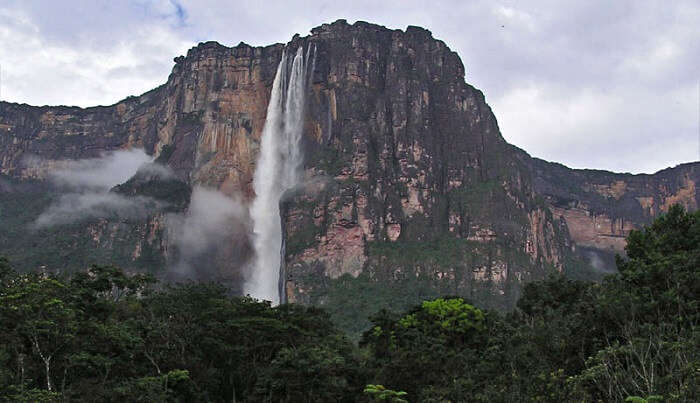
Image Source
This breathtaking cascade of foaming waters is one of the most popular tourist places to visit in Venezuela as it is the highest uninterrupted waterfall in the world. Standing at 978 meters, it has a plunge of 807 meters.
The waterfall drops over the edge of the Auyán-tepui mountain in Canaima National Park, a UNESCO World Heritage site in the Gran Sabana region of Bolívar State. The Angel Waterfalls starts from a small town called Canaima. As there are no roads to Canaima, you will have to fly from Puerto Ordaz or other nearby places in Venezuela.
The nearby places are also popular regions to visit in Venezuela as they are also equally refreshing. A typical visit to Angel Falls is an ideal three-night two-day tour. During this tour, you will see the Angel falls, lagoons of Canaima, and several other waterfalls like Hacha and Sapito. If you are looking for places to visit in Venezuela for couples then this. It is the perfect romantic place to visit in Venezuela for couples with an opportunity to spend starry nights under the sky.
Best time to visit: June to September Location: 8011, Bolívar, Venezuela
Must Read: Canaima National Park: A Gateway To Adventure, Thrill, And Venezuelan Wildlife
Looking To Book An International Holiday?

Trip to Sri Lanka at Rs 13,500/-
Plan Your Vacation Today!

Trip to Singapore at Rs 20,499/-
Get Quotes From Local Experts

Mauritius Holiday Starting at Rs 65,000/-
Talk to Our Experts Today

Maldives Honeymoon Trip at Rs 39,800/-
Pay with easy EMI Option

Europe Trip at Rs 89,999/-
All Inclusive Deals

Vacation in Dubai at Rs 27,499/-

Hong Kong Holiday at Rs 24,999/-
Money Safe Guarantee

Thailand Holiday at Rs 7,999/-
Flights Excluded

See more at TRAVELTRIANGLE.COM
2. Isla Margarita
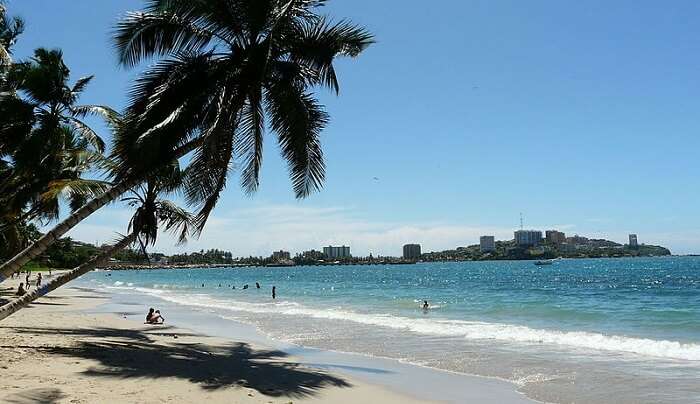
The largest island off the northern coast of Venezuela, Isla Margarita, is located to the northeast of the country’s capital Caracas and is a part of the Nueva Esparta state. Often called the Pearl of the Caribbean, it is adorned with pristine beaches with white sand stretching across miles as well as tropical beaches with seawater lapping the shore. It is one of the best places to visit in Venezuela .
A great place for beachcombing and adventure sports like wind and kite surfing is a famous place to visit in Venezuela, especially among locals for duty-free shopping. This region also has an exuberant nightlife complete with beach bars, discos, salsa clubs, and fine dining restaurants.
Best time to visit: Any time of the year especially the summer months of March to May Location: Nueva Esparta, Venezuela
Suggested Read: 32 Budget International Trips For Your Holiday Which Will Cost You Less Than An iPhone!

One of the best coastal towns in Venezuela, it features among the most popular tourist places to visit in Venezuela. It boasts of many colonial houses and a peaceful environment. It is located near the Henri Pittier National Park.
Teeming with wildlife, the Henri Pittier National Park also features lowland jungles and mysterious cloud forests. While there are deer, snakes, and other fauna, it is home to a vast majority of colorful and exciting birds.
One can expect to see violet-chested hummingbirds, fruit eaters, toucanets, parakeets, and tanagers. Thus this island gives you an all-in-one experience complete with sandy beaches, rainforests, and exotic birds.
Best time to visit: January to March Location: Choroni, Aragua, Venezuela
Suggested Read: International Destinations On Diwali Weekend: 10 Places That Can Light Up Your Holidays
4. Los Llanos
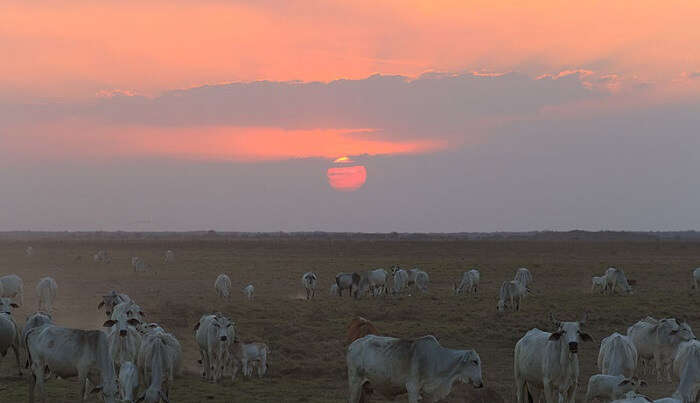
Los Llanos or “the plains” may seem just a vast stretch of tropical grassland but it is one of the most famous places to visit in Venezuela . Beautiful as it is verdant, the coming together of flooded grassland and savannas makes a trip to this place memorable. Inundated by the Orinoco River, it serves as a border between Venezuela and Colombia.
Subject to seasonal flooding, much of this region is treeless. Covered with carpet grasses during the dry season, it harbors many animals like jaguars and capybara. During the rainy season, usually from June to September, it is flooded heavily, turning it into a bird watcher’s paradise. The Serengeti of the South has a lot to offer, sporadic wildlife sightings, and gorgeous sunsets.
Best time to visit: June to September Location: Los Llanos, Panama
Suggested Read: Reality Check – Indian Carriers Make It To The List Of 200 Most Affordable International Airlines
Planning your holiday but confused about where to go? These travel stories help you find your best trip ever!

Ramya Narrates The Story Of 6 Girls On An Extraordinary Trip To Thailand
Bangkok. Phi Phi. Krabi. Why should guys have all the fun?

Sandeep Illustrates On The Best Activities For A Family Trip To Mauritius
Water sports. Cocktail parties. And unlimited fun at Casela.

Nisarg Can't Stop Praising His Honeymoon Trip To Maldives
There was snorkeling, sightseeing, luxury, comfort, & much more!

Sabyacsachi's Romantic Trip Proves Europe To Be The Mother Of All Vacations
For Art, Culture, Luxury, & more...

Srishti Talks Of Her Amazing Trip To Singapore With Her Mother & Niece
A fun-filled destination for ages indeed!

67-Year Old Sridhar Tells How He Beat The Odds & Took A Solo Trip To Dubai
Desert safari. Burj Khalifa. Welcoming locals. Tell me more!

Not Adventure Lovers? Saurabh's Family Trip Proves Hong Kong To Still Be Full Of Fun
Your kids will love Disney Land & Ocean Park!

Ravi's Tale Of A Sri Lanka Family Tour Is All You Need To Know About Ramayana Tour
For the love of Ramayana & Travel!
5. Los Roques
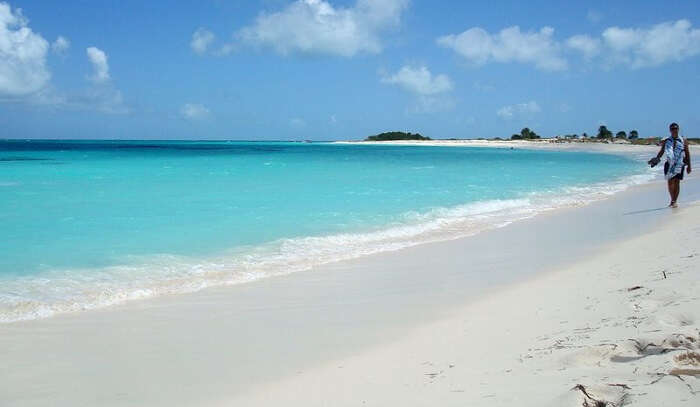
Venezuela’s diamond in the rough, Los Roques is home to around 200 cays and islands. With tall palm trees swaying in the wind and clear waves lapping the shore, it is a tropical paradise. It is a national marine park and protected ecosystem reserve that houses some of the most splendid coral reefs and underwater flora and fauna in the Caribbean.
Famous for diving, snorkeling, and a vast array of water sports, it is the perfect spot to indulge in adventure sports like surfing and kiteboarding all year round. If you are looking for the ideal place that offers you tropical beaches in a remote, peaceful environment, Los Roques is the perfect tourist place for you in Venezuela.
Best time to visit: All year round Location: Los Roques archipelago, Federal Dependencies of Venezuela, Venezuela
Suggested Read: Follow These International Travel Tips For An Epic Overseas Holiday!
6. Mount Roraima

Often called “The Floating Island,” Mount Roraima is a giant flat-topped mountain or tepui in the Pakaraima Mountains of the Guiana Highlands. About 9,094 feet (2,772 meters) high, it is the highest point in Guyana.
Ever seen those sci-fi or adventure movies where a massive mountain is enveloped by clouds? Well, Mount Roraima looks absolutely like that. It has many forms of plant life, most of which are native to the region. This region also has its share of unique fauna. The Roraima Bush Toad is native to this region and resides in shrubland. Roraima is also famous for hiking.
The challenging trails of this mountain are a favorite among people as a Venezuela tourist place. Explore the sweeping tepui playing sentinel to the lowlands and get lost in the beauty of this place as something straight out of a storybook.
Best time to visit: March to May Location: Mount Roraima, Venezuela/Brazil/Guyana
Suggested Read: 10 Brazilian Desserts To Satiate Your Taste Buds In This South American Wonderland
7. Medanos de Coro

The Mini Sahara of South America looks like something straight out of the “Welcome to Paradise” brochure. A beautiful desert complete with sand dunes sits in the heart of a tropical country. Medanos de Coro is located in the state of Falcon in Venezuela and is part of the Medanos de Coro National Park system. It is indeed one of the most astounding Venezuela tourist places .
The sands of this park are in constant motion, so often, they are called “nomad sands.”If this does not make this place “Instagram-able” enough, then there’s more. You can roam about the dunes in quad bikes or even take romantic camel rides. Take rides in the sandboards, get mesmerized by the subtle play of orange and yellow during sunsets, and explore the national park and have the best time of your life.
Best time to visit: March to May Location: Intercomunal Coro – Punto Fijo, Falcón, Venezuela
Suggested Read: Top 15 Places To Visit In Ecuador For A Megadiverse Tour In South America
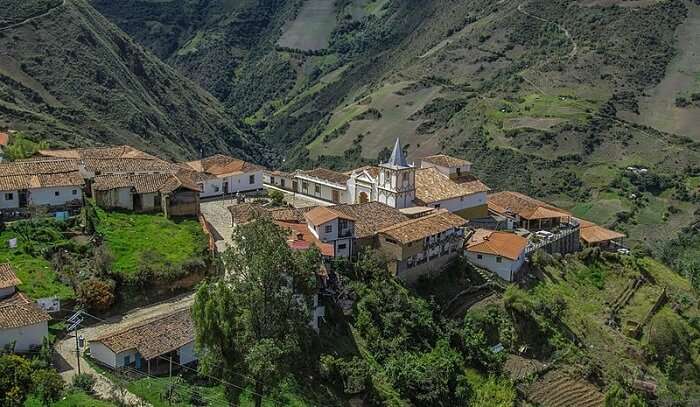
While you may have your share of experiences in ropeways and cable cars, Merasa Cable Car is different. It is the highest cable car system in the world. Its base is at Mérida at an altitude of 1,640 meters, and its terminus is on Pico Espejo, at 4,765 meters.
This vertigo-inducing ride should not be missed by any tourist. Major tourist attractions are all shown by this 12.5 km long ride-places that are otherwise difficult to visit can be seen easily. Another fun fact is that the final stop, the Pico Espejo derives its name from Mica Muscovite. It is an extremely bright rock that produces reflections when the sun shines on it.
Best time to visit: All year round Location: Plaza las Heroínas, final con av 8, Calle 24 Rangel, Mérida, Venezuela
Further Read: 10 Best American Road Trips For An Unforgettable Journey In The Land Of Enchanting Sceneries!
Natural wonders abound in this magical country, and hence be sure to experience them all on your international vacation to Venezuela. For those who like to go offbeat and wish to explore unconventional countries on a traveler’s list, Venezuela makes an excellent choice. However, be safe and stay away from danger to avoid landing yourself into any kind of trouble.
Looking To Book A Holiday Package?

Spellbinding Cochin Family Tour 2D/1N Package @ Rs 2,750
Plan your trip today!

Himachal Family Tour Package 4D/3N @ Rs 8,750
Get quotes from multiple travel experts.

Exciting Andaman Family Trip 5D/4N @ Rs 10,250
Compare & customize quotes before booking.

Gangtok & Darjeeling Tour Package 5D/4N @ Rs 13,000
Have Questions? Talk to our travel experts today.

Wonderful Goa Family Package 3D/2N @ Rs 6,500
Best prices guaranteed.

Riveting Rajasthan Vacation 3D/2N Package @ Rs 6,499
EMI option available.

Enchanting Uttarakhand Tour 4D/3N Package @ Rs 7,199
Explore best destinations with our experts.

Delightful South Weekend Tour 3D/2N Package @ Rs 4,999
Thrilling weekend full of fun.

Marvelous Gujarat Tour 3D/2N Package @ Rs 4,999
Talk to our experts today.
Recent Posts
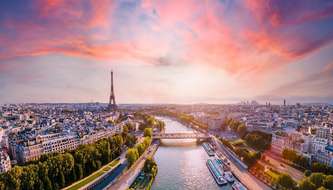
11 Villages In France: Perfect For Adventure Seekers
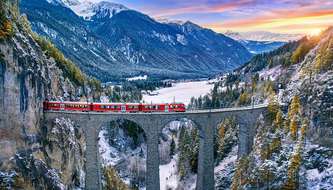
10 Picturesque Villages In Switzerland Loaded With Natural Charm
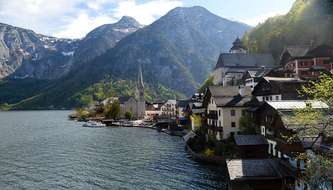
10 Charming Villages In Austria That You Can Explore Off The Beaten Path
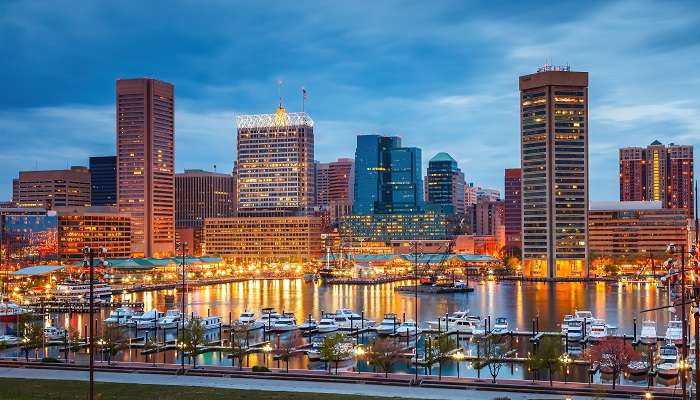
12 Hidden Gems In Maryland: Seek Offbeat Experience

10 Captivating Reasons To Visit Japan: Unveiling The Land Of Endless Wonders
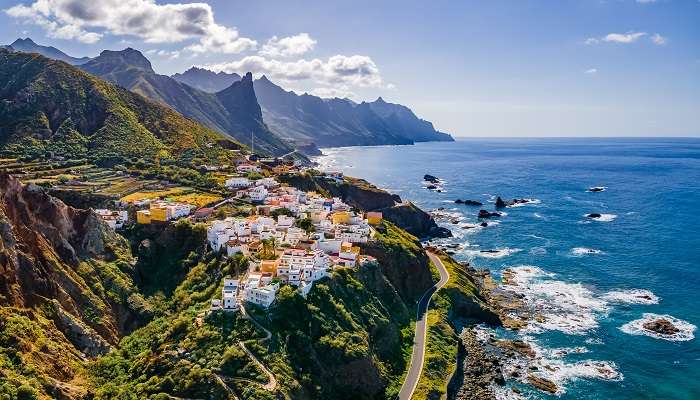
Hidden Gems In Spain You Won’t Find On Any Other List
Trending Blogs

20 Mysterious Places In India To Visit In 2023 More Bizarre Than The Bermuda Triangle

10 Scariest Roads In India That Are A Driver’s Nightmare

101 Places To Visit In India Before You Turn 30 in 2024

35 Exotic Places To Visit In December In India 2024 To Enjoy A Surreal Vacation

60 Best Honeymoon Destinations In India In 2024

95 Best Honeymoon Destinations In The World In 2023 For A Romantic Escape!
Best Places To Visit In India By Month
Best places to visit outside india by month.
- TravelTriangle
- International
- South America »
- Tour Packages
- Honeymoon Packages
- Family Packages
- Budget Tour Packages
- Luxury Tour Packages
- Adventure Tour Packages
- Group Tour Packages
- Maldives Tour Packages
- Bali Tour Packages
- Dubai Tour Packages
- Singapore Tour Packages
- Thailand Tour Packages
- Europe Tour Packages
- Sri Lanka Tour Packages
- Tour Packages From Delhi
- Tour Packages From Mumbai
- Tour Packages From Bangalore
- Tour Packages From Chennai
- Tour Packages From Kolkata
- Tour Packages From Hyderabad
- Tour Packages From Ahmedabad
- Thailand Tourism
- Bali Tourism
- Singapore Tourism
- Maldives Tourism
- Mauritius Tourism
- Dubai Tourism
- Europe Tourism
- Hotels in Thailand
- Hotels in Maldives
- Hotels in Mauritius
- Hotels in Bali
- Hotels in Dubai
- Hotels in Singapore
- Hotels in Sri Lanka
- Meet the Team
- Work with Us
- Czech Republic
- Netherlands
- Switzerland
- Scandinavia
- Philippines
- South Korea
- New Zealand
- South Africa
- Budget Travel
- Work & Travel
- The Broke Backpacker Manifesto
- Travel Resources
- How to Travel on $10/day
Home » Europe » Moscow
EPIC MOSCOW Itinerary! (2024)
Moscow is the heart of Mother Russia. Just the mention of this city conjures images of colorful bulbous pointed domes, crisp temperatures, and a uniquely original spirit!
Moscow has an incredibly turbulent history, a seemingly resilient culture, and a unique enchantment that pulls countless tourists to the city each year! Although the warmer months make exploring Moscow’s attractions more favorable, there’s just something about a fresh snowfall that only enhances the appearance of the city’s iconic sites!
If you’re a first-time visitor to Moscow, or simply wanting to see as much of the city as possible, this Moscow itinerary will help you do just that!

Unlock Our GREATEST Travel Secrets!
Sign up for our newsletter and get the best travel tips delivered right to your inbox.
Best Time To Visit Moscow
Where to stay in moscow, moscow itinerary, day 1 itinerary in moscow, day 2 itinerary in moscow, day 3 and beyond, staying safe in moscow, day trips from moscow, faq on moscow itinerary.
Here is a quick look at the seasons so you can decide when to visit Moscow!
The summer months (June-August) are a great time to travel to Moscow to take advantage of the enjoyable mild temperatures. This is considered peak travel season. Bear in mind that hotel prices rise along with the temperatures!

If you’re planning a trip to Moscow during fall (September-November) try to plan for early fall. This way the temperatures will still be pleasant and winter won’t be threatening.
Russian winters (December-February) are not for the faint of heart as Napoleon learned to his peril. Some days the sun will be out for less than an hour, and snow is guaranteed. Although winters are exceptionally cold, this is when you’ll get a true glimpse of the Moscow experience!
The best time to visit Moscow is during spring (March-May). The temperatures will begin to creep up and the sun begins to shine for significant portions of the day. Hotel rates will also have yet to skyrocket into peak ranges!

With a Moscow City Pass , you can experience the best of Moscow at the CHEAPEST prices. Discounts, attractions, tickets, and even public transport are all standards in any good city pass – be sure invest now and save them $$$ when you arrive!
Moscow is a large city with many accommodation options to choose from. Staying in a location that fits with your travel plans will only enhance your Moscow itinerary. Here is a brief introduction to a few great areas of the city we recommend checking out!
The best place to stay in Moscow to be close to all the action is Kitay-Gorod. This charming neighborhood will put you within walking distance to Moscow’s famous Red Square, thus cutting down on travel time. This will allow you to see more of the city in a shorter amount of time!

It’s surrounded by restaurants, cafes, bars, and shops. If you’re a first-time visitor to Moscow, or just planning a quick weekend in Moscow, then this area is perfect for you!
Another great area to consider is the Zamoskvorechye district. This area of the city offers a blend of new and old Moscow. It has an artsy vibe and there are plenty of fun sites you can explore outside of the main touristy areas of Moscow.
Of course, as in all areas of Moscow, it’s close to public transportation that will quickly connect you with the rest of the city and make your Moscow itinerary super accessible!
Best Airbnb in Moscow – Exclusive Apartment in Old Moscow

Modern and cozy, this apartment is in the heart of Old Moscow. Bordering the Basmanny and Kitay-Gorod districts, this two-bedroom flat is walking distance to the Kremlin and Red Square. Safe, quiet, and comfortable, this is the best Airbnb in Moscow, no question!
Best Budget Hotel in Moscow – Izmailovo Alfa Hotel

The Izmailovo Alfa Hotel is a very highly rated accommodation that provides all the components necessary for a comfortable trip to Moscow. There is an on-site restaurant, bar, fitness center, and an airport shuttle service. The rooms are modern and spacious and are equipped with a TV, heating/air conditioning, minibar, and more!
Best Luxury Hotel in Moscow – Crowne Plaza Moscow World Trade Centre

If you’re touring Moscow in luxury, the Crowne Plaza Moscow World Trade Centre is the hotel for you! Elegantly furnished rooms are equipped with a minibar, flat-screen TV, in-room safes, as well as tea and coffee making facilities! Bathrooms come with bathrobes, slippers, and free toiletries. There is also an onsite restaurant, bar, and fitness center.
Best Hostel in Moscow – Godzillas Hostel

Godzillas Hostel is located in the center of Moscow, just a short walk from all the major tourist attractions and the metro station. Guests will enjoy all the usual hostel perks such as self-catering facilities, 24-hour reception, Free Wi-Fi, and security lockers. This is one of the best hostels in Moscow and its wonderful social atmosphere and will make your vacation in Moscow extra special!
Godzillas Hostel is one of our favourites in Moscow but they’re not taking guests right now. We’re not sure if they’re closed for good but we hope they’ll come back soon.
An important aspect of planning any trip is figuring out the transportation situation. You’re probably wondering how you’re going to get to all of your Moscow points of interest right? Luckily, this sprawling city has an excellent network of public transportation that will make traveling a breeze!
The underground metro system is the quickest and most efficient way to travel around Moscow. Most visitors rely exclusively on this super-efficient transportation system, which allows you to get to pretty much anywhere in the city! It’s also a great option if you’re planning a Moscow itinerary during the colder months, as you’ll be sheltered from the snow and freezing temperatures!

If you prefer above-ground transportation, buses, trams, and trolleybuses, run throughout the city and provide a rather comfortable alternative to the metro.
Moscow’s metro, buses, trams, and trolleybuses are all accessible with a ‘Troika’ card. This card can be topped up with any sum of money at a metro cash desk. The ticket is simple, convenient, and even refundable upon return to a cashier!
No matter which method you choose, you’ll never find yourself without an easy means of getting from point A to point B!
Red Square | Moscow Kremlin | Lenin’s Mausoleum | St. Basil’s Cathedral | GUM Department Store
Spend the first day of your itinerary taking your own self guided Moscow walking tour around the historic Red Square! This is Moscow’s compact city center and every stop on this list is within easy walking distance to the next! Get ready to see all of the top Moscow landmarks!
Day 1 / Stop 1 – The Red Square
- Why it’s awesome: The Red Square is the most recognizable area in Moscow, it has mesmerizing architecture and centuries worth of history attached to its name.
- Cost: Free to walk around, individual attractions in the square have separate fees.
- Food nearby: Check out Bar BQ Cafe for friendly service and good food in a great location! The atmosphere is upbeat and they’re open 24/7!
The Red Square is Moscow’s historic fortress and the center of the Russian government. The origins of the square date back to the late 15th century, when Ivan the Great decided to expand the Kremlin to reflect Moscow’s growing power and prestige!
During the 20th century, the square became famous as the site for demonstrations designed to showcase Soviet strength. Visiting the Red Square today, you’ll find it teeming with tourists, who come to witness its magical architecture up close!

The square is the picture postcard of Russian tourism, so make sure to bring your camera when you visit! No matter the season, or the time of day, it’s delightfully photogenic!
It’s also home to some of Russia’s most distinguishing and important landmarks, which we’ve made sure to include further down in this itinerary. It’s an important center of Russia’s cultural life and one of the top places to visit in Moscow!
In 1990, UNESCO designated Russia’s Red Square as a World Heritage site. Visiting this historic site is a true bucket-list event and essential addition to your itinerary for Moscow!
Day 1 / Stop 2 – The Moscow Kremlin
- Why it’s awesome: The Moscow Kremlin complex includes several palaces and cathedrals and is surrounded by the Kremlin wall. It also houses the principal museum of Russia (the Kremlin Armory).
- Cost: USD $15.00
- Food nearby: Bosco Cafe is a charming place to grat a casual bite to eat. They have excellent coffee and wonderful views of the Red Square and the Moscow Kremlin!
The iconic Moscow Kremlin , also known as the Kremlin museum complex, sits on Borovitsky Hill, rising above the Moscow River. It is a fortified complex in the center of the city, overlooking several iconic buildings in the Red Square!
It’s the best known of the Russian Kremlins – citadels or fortress’ protecting and dominating a city. During the early decades of the Soviet era, the Kremlin was a private enclave where the state’s governing elite lived and worked.
The Kremlin is outlined by an irregularly shaped triangular wall that encloses an area of 68 acres! The existing walls and towers were built from 1485 to 1495. Inside the Kremlin museum complex, there are five palaces, four cathedrals, and the enclosing Kremlin Wall with Kremlin towers.
The Armoury Chamber is a part of the Grand Kremlin Palace’s complex and is one of the oldest museums of Moscow, established in 1851. It showcases Russian history and displays many cherished relics. Definitely make sure to check out this museum while you’re here!

The churches inside the Moscow Kremlin are the Cathedral of the Dormition, Church of the Archangel, Church of the Annunciation, and the bell tower of Ivan Veliki (a church tower).
The five-domed Cathedral of the Dormition is considered the most famous. It was built from 1475–1479 by an Italian architect and has served as a wedding and coronation place for great princes, tsars, and emperors of Russia. Church services are given in the Kremlin’s numerous cathedrals on a regular basis.
The Grand Kremlin Palace was the former Tsar’s Moscow residence and today it serves as the official workplace of the President of the Russian Federation (Vladimir Putin seems to have bagged that title for life) .
Insider Tip: The Kremlin is closed every Thursday! Make sure to plan this stop on your Moscow itinerary for any other day of the week!
Day 1 / Stop 3 – Lenin’s Mausoleum
- Why it’s awesome: The mausoleum displays the preserved body of Soviet leader Vladimir Lenin .
- Cost: Free!
- Food nearby: Khinkal’naya is a charming Georgian restaurant with vaulted ceilings and exposed brick. It’s a popular place with locals and right next to the Red Square!
Lenin’s Mausoleum, also known as Lenin’s Tomb, is the modernist mausoleum for the revolutionary leader Vladimir Lenin. It’s located within the Red Square and serves as the resting place for the Soviet leader! His preserved body has been on public display since shortly after his death in 1924.
It’s located just a few steps away from the Kremlin Wall and is one of the most controversial yet popular Moscow attractions!
Admission is free for everyone, you’ll only need to pay if you need to check a bag. Before visitors are allowed to enter the mausoleum, they have to go through a metal detector first. No metal objects, liquids, or large bags are allowed in the mausoleum!

Expect a line to enter the building, and while you’re inside the building, you’ll be constantly moving in line with other visitors. This means you won’t be able to spend as long as you’d like viewing the mausoleum, but you’ll still be able to get a good look. Pictures and filming while inside the building are strictly prohibited, and security guards will stop you if they see you breaking this rule.
The mausoleum is only open on Tuesday, Wednesday, Thursday, and Saturday – unless it’s a public holiday or a day scheduled for maintenance. The hours it’s open for each day are limited, make sure to check online before you visit to make sure you can fit this into your Moscow itinerary for that day!
Insider Tip: The Lenin’s Museum is there for people to pay their respect; remember to keep silent and move along quickly, it’s not intended for people to congregate around. Also, men are not allowed to wear hats and everyone must take their hands out of their pockets when inside the building.
Day 1 / Stop 4 – St. Basil’s Cathedral
- Why it’s awesome: A dazzling designed cathedral that showcases Russia’s unique architecture. This cathedral is one of the most recognizable symbols of the country!
- Cost: USD $8.00
- Food nearby: Moskovskiy Chaynyy Klub is a cozy cafe serving food items and pipping hot tea; it’s the perfect place to go if you’re visiting Moscow during the winter months!
Located in the Red Square, the ornate 16th-century St. Basil’s Cathedral is probably the building you picture when you think of Moscow’s unique architecture. Its colorful onion-shaped domes tower over the Moscow skyline!
The cathedral was built from 1555-1561 by order of Tsar Ivan the Terrible. It was designed with an iconic onion dome facade and enchanting colors that captivate all who see it. Fun fact: If you’re wondering why Russian churches have onion domes, they are popularly believed to symbolize burning candles!
This iconic cathedral has become a symbol of Russia due to its distinguishing architecture and prominent position inside the Red Square. It’s one of the most beautiful, wonderful, and mesmerizing historical cathedrals in the world!

The interior of the church surprises most people when they visit. In contrast to the large exterior, the inside is not so much one large area, but rather a collection of smaller areas, with many corridors and small rooms. There are 9 small chapels and one mausoleum grouped around a central tower.
Visiting the inside is like walking through a maze, there are even small signs all around the cathedral tracing where to walk, and pointing you in the right direction! The walls are meticulously decorated and painted with intricate floral designs and religious themes.
The church rarely holds service and is instead a museum open for the public to visit.
Insider Tip: During the summer months the line to go inside the cathedral can get quite long! Make sure to arrive early or reserve your tickets online to guarantee quick access into the cathedral!
Day 1 / Stop 5 – GUM Department Store
- Why it’s awesome: This is Russia’s most famous shopping mall! It’s designed with elegant and opulent architecture and provides a real sense of nostalgia!
- Cost: Free to enter
- Food nearby: Stolovaya 57 is a cafeteria-style restaurant with a variety of inexpensive Russian cuisine menu items including soups, salads, meat dishes, and desserts. It’s also located inside the GUM department store, making it very easily accessible when you’re shopping!
The enormous GUM Department Store is located within the historic Red Square. It has a whimsical enchantment to it that sets it apart from your typical department store.
A massive domed glass ceiling lines the top of the building and fills the interior with natural sunlight. There are live plants and flowers placed throughout the mall that give the shopping complex a lively and cheerful feel! A playful fountain sits in the center, further adding to the malls inviting a sense of wonder and amusement!
The GUM department store opened on December 2, 1893. Today, it includes local and luxury stores, including Fendi, Louis Vuitton, Prada, and many more! There are numerous cafes, restaurants, and even a movie theater inside!

For a special treat, head into Gastronom 1. This 1950s-style shop sells gourmet food items, like wine, freshly-baked pastries, cheese, Russian chocolate, and of course, vodka! Also, be on the lookout for a bicycle pedaling ice cream truck with an employing selling ice cream!
The ambiance is simply amazing, a trip to this idyllic shopping mall is an absolute must on any Moscow itinerary!
Insider Tip: Make sure to carry some small change on you in case you need to use the restroom, you’ll need to pay 50 rubles – or about USD $0.80 to use the bathroom in GUM.

Wanna know how to pack like a pro? Well for a start you need the right gear….
These are packing cubes for the globetrotters and compression sacks for the real adventurers – these babies are a traveller’s best kept secret. They organise yo’ packing and minimise volume too so you can pack MORE.
Or, y’know… you can stick to just chucking it all in your backpack…
Novodevichy Convent | Gorky Park | State Tretyakov Gallery | All-Russian Exhibition Center | Bolshoi Theater
On your 2 day itinerary in Moscow, you’ll have a chance to use the city’s excellent public transportation service! You’ll explore a few more of Moscow’s historic highlight as well as some modern attractions. These sites are a little more spread out, but still very easily accessible thanks to the metro!
Day 2 / Stop 1 – Novodevichy Convent
- Why it’s awesome: The Novodevichy Convent is rich in imperial Russian history and contains some of Russia’s best examples of classical architecture!
- Cost: USD $5.00
- Food nearby: Culinary Shop Karavaevs Brothers is a cozy and simple place to have a quick bite, they also have vegetarian options!
The Novodevichy Convent is the best-known and most popular cloister of Moscow. The convent complex is contained within high walls, and there are many attractions this site is known for!
The six-pillared five-domed Smolensk Cathedral is the main attraction. It was built to resemble the Kremlin’s Assumption Cathedral and its facade boasts beautiful snowy white walls and a pristine golden onion dome as its centerpiece. It’s the oldest structure in the convent, built from 1524 -1525, and is situated in the center of the complex between the two entrance gates.
There are other churches inside the convent as well, all dating back from many centuries past. The convent is filled with an abundance of 16th and 17th-century religious artworks, including numerous large and extravagant frescos!

Just outside the convent’s grounds lies the Novodevichy Cemetery. Here, you can visit the graves of famous Russians, including esteemed authors, composers, and politicians. Probably the most intriguing gravestone belongs to Russian politician Nikita Khruschev!
The Novodevichy Convent is located near the Moscow River and offers a peaceful retreat from the busy city. In 2004, it was proclaimed a UNESCO World Heritage Site. The convent remains remarkably well-preserved and is an outstanding example of Moscow Baroque architecture!
Insider Tip: To enter the cathedrals inside the complex, women are advised to cover their heads and shoulders, while men should wear long pants.
Day 2 / Stop 2 – Gorky Central Park of Culture and Leisure
- Why it’s awesome: A large amusement area in the heart of the city offering many attractions!
- Cost: Free!
- Food nearby: Check out Mepkato, located inside Gorky Central Park for a casual meal in a cozy setting. There are indoor and outdoor seating options and the restaurant is child-friendly!
Gorky Central Park of Culture and Leisure is a large green space in the heart of Moscow. The park opened in 1928, and it stretches along the scenic embankment of the Moskva River. It covers an area of 300-acres and offers a lovely contrast from the compact city center.
You’ll find all sorts of wonderful attractions, from boat rides to bike rentals to tennis courts and ping-pong tables, and much more! there are an open-air cinema and festive events and concerts scheduled in the summer months. A wide selection of free fitness classes is also offered on a regular basis, including jogging, roller skating, and dancing!
Although many of the options you’ll find here are more suited for outdoor leisure during the summer, you’ll also a selection of winter attractions, including one of Europe’s largest ice rinks for ice-skating!

If you’re trying to decide what to do in Moscow with kids, the park also offers several venues designed specifically for kids. Check out the year-round Green School which offers hands-on classes in gardening and art! You can also feed the squirrels and birds at the Golitsinsky Ponds!
The park is very well maintained and kept clean and the entrance is free of charge, although most individual attractions cost money. There is also Wi-Fi available throughout the park.
With so many attractions, you could easily spend all day here! If you’re only planning a 2 day itinerary in Moscow, make sure to plan your time accordingly and map out all the areas you want to see beforehand!
Day 2 / Stop 3 – The State Tretyakov Gallery
- Why it’s awesome: The gallery’s collection consists entirely of Russian art made by Russian artists!
- Food nearby : Brothers Tretyakovs is located right across the street from the gallery. It’s a wonderfully atmospheric restaurant serving top quality food and drinks!
The State Tretyakov Gallery was founded in 1856 by influential merchant and collector Pavel Tretyakov. The gallery is a national treasury of Russian fine art and one of the most important museums in Russia!
It houses the world’s best collection of Russian art and contains more than 130, 000 paintings, sculptures, and graphics! These works have been created throughout the centuries by generations of Russia’s most talented artists!

The exhibits range from mysterious 12th-century images to politically charged canvases. The collection is rich and revealing and offers great insight into the history and attitudes of this long-suffering yet inspired people!
All pictures are also labeled in English. If you plan to take your time and see everything inside the museum it will take a good 3-4 hours, so make sure to plan your Moscow trip itinerary accordingly! This gallery is a must-see stop for art lovers, or anyone wanting to explore the local culture and history of Russia in a creative and insightful manner!
Insider Tip: When planning your 2 days in Moscow itinerary, keep in mind that most museums in Moscow are closed on Mondays, this includes The State Tretyakov Gallery!
Day 2 / Stop 4 – All-Russian Exhibition Center
- Why it’s awesome: This large exhibition center showcases the achievements of the Soviet Union in several different spheres.
- Food nearby: Varenichnaya No. 1 serves authentic and homestyle Russian cuisine in an intimate and casual setting.
The All-Russian Exhibition Center is a massive park that presents the glory of the Soviet era! It pays homage to the achievements of Soviet Russia with its many different sites found on the property.
The center was officially opened in 1939 to exhibit the achievements of the Soviet Union. It’s a huge complex of buildings and the largest exhibition center in Moscow. There are several exhibition halls dedicated to different achievements and every year there are more than one hundred and fifty specialized exhibitions!

The Peoples Friendship Fountain was constructed in 1954 and is a highlight of the park. The stunning gold fountain features 16 gilded statues of girls, each representing the former Soviet Union republics.
The Stone Flower Fountain was also built in 1954 and is worth checking out. The centerpiece of this large fountain is a flower carved from stones from the Ural Mountains! Along the side of the fountain are various bronze sculptures.
You will find many people zipping around on rollerblades and bicycles across the large area that the venue covers. It’s also home to amusement rides and carousels, making it the perfect place to stop with kids on your Moscow itinerary! Make sure to wear comfortable shoes and allow a few hours to explore all the areas that interest you!
Day 2 / Stop 5 – Bolshoi Theater
- Why it’s awesome: The Bolshoi Theater is a historic venue that hosts world-class ballet and opera performances!
- Cost: Prices vary largely between USD $2.00 – USD $228.00 based on seat location.
- Food nearby: Head to the Russian restaurant, Bolshoi for high-quality food and drinks and excellent service!
The Bolshoi Theater is among the oldest and most renowned ballet and opera companies in the world! It also boasts the world’s biggest ballet company, with more than 200 dancers!
The theater has been rebuilt and renovated several times during its long history. In 2011 it finished its most recent renovation after an extensive six-year restoration that started in 2005. The renovation included an improvement in acoustics and the restoration of the original Imperial decor.
The Bolshoi Theater has put on many of the world’s most famous ballet acts! Tchaikovsky’s ballet Swan Lake premiered at the theater in 1877 and other notable performances of the Bolshoi repertoire include Tchaikovsky’s The Sleeping Beauty and The Nutcracker!

Today, when you visit the theater, you can expect a magical performance from skilled singers, dancers, and musicians with the highest level of technique!
If you don’t have time to see a show, the theater also provides guided tours on select days of the week. Tours are given in both Russian and English and will provide visitors with a more intimate look at the different areas of the theater!
The stage of this iconic Russian theater has seen many outstanding performances. If you’re a fan of the performing arts, the Bolshoi Theater is one of the greatest and oldest ballet and opera companies in the world, making it a must-see attraction on your Moscow itinerary!

Godzillas Hostel
Godzillas Hostel is located in the center of Moscow, just a short walk from all the major tourist attractions and the metro station.
- Towels Included
Cosmonautics Museum | Alexander Garden | Ostankino Tower | Izmaylovo District | Soviet Arcade Museum
Now that we’ve covered what to do in Moscow in 2 days, if you’re able to spend more time in the city you’re going to need more attractions to fill your time. Here are a few more really cool things to do in Moscow we recommend!
Memorial Museum of Cosmonautics
- Hear the timeline of the ‘space race’ from the Russian perspective
- This museum is fun for both adults and children!
- Admission is USD $4.00
The Memorial Museum of Cosmonautics is a museum dedicated to space exploration! The museum explores the history of flight, astronomy, space exploration, space technology, and space in the arts. It houses a large assortment of Soviet and Russian space-related exhibits, and the museum’s collection holds approximately 85,000 different items!

The museum does an excellent job of telling the full story of the exciting space race between the USSR and the US! It highlights the brightest moments in Russian history and humanity and is very interesting and fun for all ages!
If you’re a fan of space or just curious about gaining insight into Russia’s fascinating history of space exploration, make sure to add this to your 3 day itinerary in Moscow!
The Alexander Garden
- A tranquil place to relax near the Red Square
- Green lawns dotted with sculptures and lovely water features
- The park is open every day and has no entrance fee
The Alexander Garden was one of the first urban public parks in Moscow! The garden premiered in 1821 and was built to celebrate Russia’s victory over Napoleon’s forces in 1812!
The park is beautiful and well maintained with paths to walk on and benches to rest on. The park contains three separate gardens: the upper garden, middle garden, and lower garden.

Located in the upper garden, towards the main entrance to the park is the Tomb of the Unknown Soldier with its eternal flame. This monument was created in 1967 and contains the body of a soldier who fell during the Great Patriotic War!
The park stretches along all the length of the western Kremlin wall for about half a mile. Due to its central location in the city, it’ll be easily accessible when you’re out exploring The Red Square.
It provides a bit of relief from the city’s high-energy city streets. Bring a picnic lunch, go for a walk, or just sit and people watch, this is one of the best Moscow sites to wind-down and relax!
Ostankino Television Tower
- Television and radio tower in Moscow
- Currently the tallest free-standing structure in Europe
- Make sure you bring your passport when you visit, you can’t go up without it!
For spectacular views of the city, make sure to add the Ostankino Television Tower to your itinerary for Moscow! This impressive free-standing structure provides stunning views of the city in every direction. The glass floor at the top also provides great alternative views of the city!

It takes just 58 seconds for visitors to reach the Tower’s observation deck by super fast elevator. The tower is open every day for long hours and is a great site in Moscow to check out! There is even a restaurant at the top where you can enjoy rotating views of the city while you dine on traditional Russian cuisine or European cuisine!
The tower is somewhat of an architectural surprise in a city that is not known for skyscrapers! To see the city from a new perspective, make sure to add this stop to your Moscow itinerary!
Izmaylovo District
- The most popular attractions in this district are the kremlin and the flea market
- Outside of the city center and easy to reach via metro
- Most popular during the summer and on weekends
Travel outside the city center and discover a unique area of the city! The Izmaylovo District is a popular destination for locals and tourists alike, and one of the coolest places to see in Moscow! The two main attractions we recommend checking out are the Kremlin and the flea market.
The Izmailovo Kremlin was established as a cultural center and molded after traditional Russian architecture. This colorful complex is home to several single-subject museums, including a Russian folk art museum and a vodka museum!

Next to the Kremlin is the Izmailovo open-air market, which dates back to the 17th century! The market is connected to the Izmailovo Kremlin by a wooden bridge. Pick up all your Russian souvenirs here, including traditional handicrafts, paintings, books, retro toys, and Soviet memorabilia!
You will find many hand-made and hand-painted options available at higher prices, as well as mass-produced souvenir options at lower prices!
Museum of Soviet Arcade Games
- Closed on Mondays
- Filled with old arcade games that visitors get to try out!
- The museum also includes a small cafe and burger shop
For something a little different, check out the Museum of Soviet Arcade Games! The museum features roughly 60 machines from the Soviet era, including video games, pinball machines, and collaborative hockey foosball! The machines inside the museum were produced in the USSR in the mid-1970s.

The best part is, most of the games are still playable! Purchase tickets and try the games out for yourself! The museum also has a neat little screening room that plays old Soviet cartoons and an area with Soviet magazines! This unique attraction is a fun addition to a 3 day itinerary in Moscow, and an attraction that all ages will enjoy!
Whether you’re spending one day in Moscow, or more, safety is an important thing to keep in mind when traveling to a big city! Overall, Moscow is a very safe place to visit. However, it is always recommended that tourists take certain precautions when traveling to a new destination!
The police in Moscow is extremely effective at making the city a safe place to visit and do their best to patrol all of the top Moscow, Russia tourist attractions. However, tourists can still be a target for pickpockets and scammers.
Moscow has a huge flow of tourists, therefore there is a risk for pickpocketing. Simple precautions will help eliminate your chances of being robbed. Stay vigilant, keep your items close to you at all times, and don’t flash your valuables!
If you’re planning a solo Moscow itinerary, you should have no need to worry, as the city is also considered safe for solo travelers, even women. Stay in the populated areas, try and not travel alone late at night, and never accept rides from strangers or taxis without a meter and correct signage.
The threat of natural disasters in Moscow is low, with the exception of severe winters when the temperature can dip below freezing! Bring a good, warm jacket if you visit in Winter.
However, please note that Russian views on homsexuality are far less accepting than those in Western Europe. Likewise, Non-Caucasian travellers may sadly encounter racism in Russia .
Don’t Forget Your Travel Insurance for Moscow
ALWAYS sort out your backpacker insurance before your trip. There’s plenty to choose from in that department, but a good place to start is Safety Wing .
They offer month-to-month payments, no lock-in contracts, and require absolutely no itineraries: that’s the exact kind of insurance long-term travellers and digital nomads need.

SafetyWing is cheap, easy, and admin-free: just sign up lickety-split so you can get back to it!
Click the button below to learn more about SafetyWing’s setup or read our insider review for the full tasty scoop.
Now that we’ve covered all the top things to see in Moscow, we thought we’d include some exciting day trips to other areas of the country!
Sergiev Posad (Golden Ring)

On this 7-hour guided tour, you’ll visit several scenic and historic areas of Russia. Start your day with hotel pick-up as you’re transferred by a comfortable car or minivan to Sergiev Posad. Admire the charming Russian countryside on your drive and enjoy a quick stop to visit the Russian village, Rudonezh!
You’ll see the majestic Saint Spring and the Church of Sergiev Radonezh. You’ll also visit the UNESCO World Heritage Site, Trinity Lavra of St. Sergius, one of the most famous Orthodox sites in Russia!
Lastly, you’ll swing by the local Matreshka market and enjoy a break in a nice Russian restaurant before returning to Moscow!
Day Trip to Vladimir and Suzdal

On this 13-hour trip, you’ll discover old Russia, with its picturesque landscapes and white-stoned beautiful churches! You’ll visit the main towns of the famous Golden Ring of Russia – the name for several cities and smaller towns north-east of Moscow.
Your first stop will be in the town of Vladimir, the ancient capital of all Russian principalities. The city dates back to the 11th century and is one of the oldest and the most important towns along the Ring! Next, you’ll visit Suzdal, a calm ancient Russian town north of Vladimir with only 13,000 inhabitants!
The old-style architecture and buildings of Suzdal are kept wonderfully intact. If you’re spending three days in Moscow, or more, this is a great option for exploring the charming areas outside the city!
Zvenigorod Day Trip and Russian Countryside

On this 9-hour private tour, you’ll explore the ancient town of Zvenigorod, one of the oldest towns in the Moscow region! As you leave Moscow you’ll enjoy the stunning scenery along the Moscow River, and make a few stops at old churches along the way to Zvenigorod.
Upon arrival, you’ll explore the medieval center, including the 14th-century Savvino-Storozhevsky Monastery. Next, you’ll take a break for lunch (own expense) where you’ll have the chance to try out the Russian cuisine! Next, you’ll visit the Museum of Russian Dessert and sip on tea at a Russian tea ceremony.
The final stop of the day is at the Ershovo Estate, a gorgeous place to walk around and enjoy nature!
Day Trip to St Petersburg by Train visiting Hermitage & Faberge

On this full-day tour, you’ll enjoy a a full round trip to St Petersburg where you’ll spend an exciting day exploring another popular Russian city! You’ll be picked up from your hotel in Moscow and be transferred to the train station where you’ll ride the high-speed train ‘Sapsan’ to St Petersburg.
Upon arrival, you’ll start the day by touring the Hermitage Museum and the Winter Palace. Next, you’ll visit the Faberge Museum, where you’ll explore the impressive collection of rare Faberge Eggs! In the afternoon, enjoy a sightseeing boat ride and a traditional 3-course Russian lunch.
If you’re spending 3 days in Moscow, or more, this is an excellent trip to take!
Trip to Kolomna – Authentic Cultural Experience from Moscow

On this 10-hour tour, you’ll escape the city and travel to the historic town of Kolomna! First, you’ll visit the 14th-century Kolomna Kremlin, home to the Assumption Cathedral and an abundance of museums!
Next, enjoy lunch at a local cafe (own expense) before embarking on a tour of the Marshmallow Museum – of course, a marshmallow tasting is provided! Your final stop is the Museum of Forging Settlements, where displays include armor and accessories for fishing and hunting.
Discover this beautiful Russian fairytale city on a private trip, where all of the planning is taken care of for you!

Stash your cash safely with this money belt. It will keep your valuables safely concealed, no matter where you go.
It looks exactly like a normal belt except for a SECRET interior pocket perfectly designed to hide a wad of cash, a passport photocopy or anything else you may wish to hide. Never get caught with your pants down again! (Unless you want to…)
Find out what people want to know when planning their Moscow itinerary.
How many days you need in Moscow?
We recommend that you spend at least two or three days in Moscow to take it all in.
What’s the best month to visit Moscow?
The best time to visit Moscow is over the spring, from March to May as temperatures are mild, crowds are thin and prices are reasonable.
What are some unusual things to do in Moscow?
I mean, queuing up to see an almost 100 year old corpse is pretty unsual! Check out Lenin’s Mausoleum if you fancy it!
What are some fun things to do in Moscow?
The Memorial Museum of Cosmonautics is a fun place to explore the famous space race from the perspective of the ‘other side’!
We hope you enjoyed our Moscow itinerary! We’ve made sure to cover all the Moscow must-sees as well as some unique attractions in the city! Our addition of insider tips, favorite food stops, and day trips from Moscow is an added bonus and will guarantee you make the most out of your exciting Russian vacation!
Immerse yourself in the modern and traditional Russian lifestyle! Get lost in museums, witness awe-inspiring architecture, and indulge in Russian cuisine! Spend the day strolling through all of the charming sites of Moscow, admiring the beautiful scenery and discovering the city’s fairytale-like enchantment!

And for transparency’s sake, please know that some of the links in our content are affiliate links . That means that if you book your accommodation, buy your gear, or sort your insurance through our link, we earn a small commission (at no extra cost to you). That said, we only link to the gear we trust and never recommend services we don’t believe are up to scratch. Again, thank you!

Alya and Campbell

Share or save this post

Leave a Reply Cancel reply
Your email address will not be published. Required fields are marked *
Save my name, email, and website in this browser for the next time I comment.
Notify me of followup comments via e-mail.

Touropia Travel Experts
Discover the World
17 Top Tourist Attractions in Moscow

The capital of Russia is an incredible place to explore. Visitors to Moscow come away spellbound at all the amazing sights, impressed at the sheer size and grandeur of the city. Lying at the heart of Moscow, the Red Square and the Kremlin are just two of the must-see tourist attractions; they are the historical, political and spiritual heart of the city – and indeed Russia itself.
A fascinating city to wander around, stunning cathedrals, churches, and palaces lie side-by-side with bleak grey monuments and remains from the Soviet state. In addition to its plethora of historical and cultural tourist attractions, Moscow is home to world-class museums, theaters and art galleries.
Renowned for its performing arts, fantastic ballets and amazing circus acts, catching a show while in Moscow is a must. The wealth of brilliant restaurants, trendy bars, and lively nightlife means there is something for everyone to enjoy.
See also: Where to Stay in Moscow
17. Tsaritsyno Palace
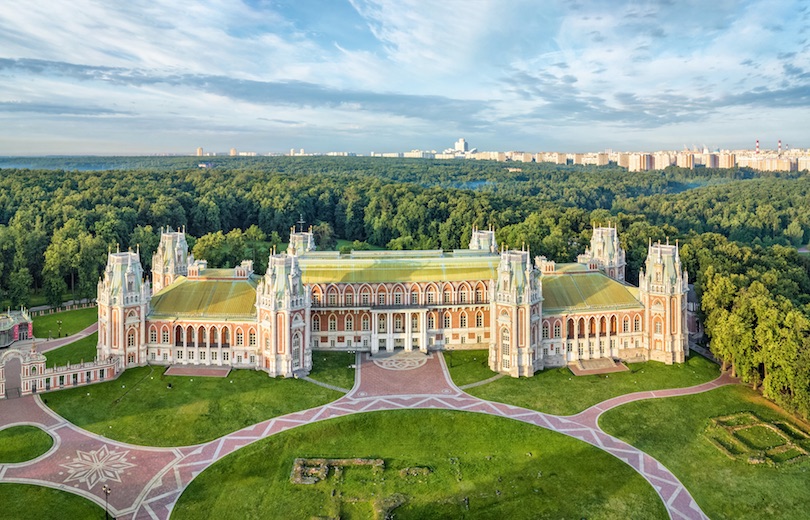
Once the summer residence of Catherine the Great, the stunning Tsaritsyno Palace is now a museum-reserve. The architecture is magnificent and there is a lovely park surrounding it for visitors to explore.
Located in the south of Moscow, the palace was commissioned in 1775 and recent renovations mean its lavish interior looks better than ever before with its elegant halls and beautiful staircases.
The exhibits on display look at the life of the empress as well as the history of Tsaritsyno itself. The huge palace grounds are also home to some other delightful buildings with the elegant opera house and wonderful brickwork of the Small Palace being particularly impressive to gaze upon.
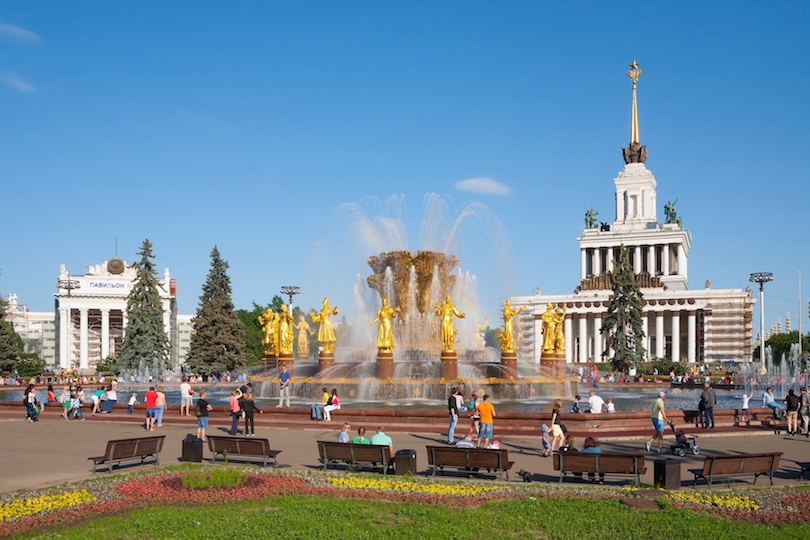
Starting out in 1935 as the ‘All-Union Agricultural Exhibition’, VDNKh has slowly morphed over the years into the fascinating open-air museum of today. Remarkably, over 400 buildings can now be found within its confines.
The huge park complex has numerous pavilions representing former Soviet republics on show, such as those of Armenia and Turkmenistan and the distinctive architecture of each of the buildings is always interesting to gaze upon. In addition to this there is the fascinating Memorial Museum of Cosmonautics which is dedicated to space exploration and the fun Moskvarium aquarium even offers you the chance to swim with dolphins.
With lots of eateries scattered about and numerous entertainment options such as horse-riding and zip-lining, there is something for everyone to enjoy; the Friendship of Nations fountain truly is wonderful.
15. Kremlin Armoury
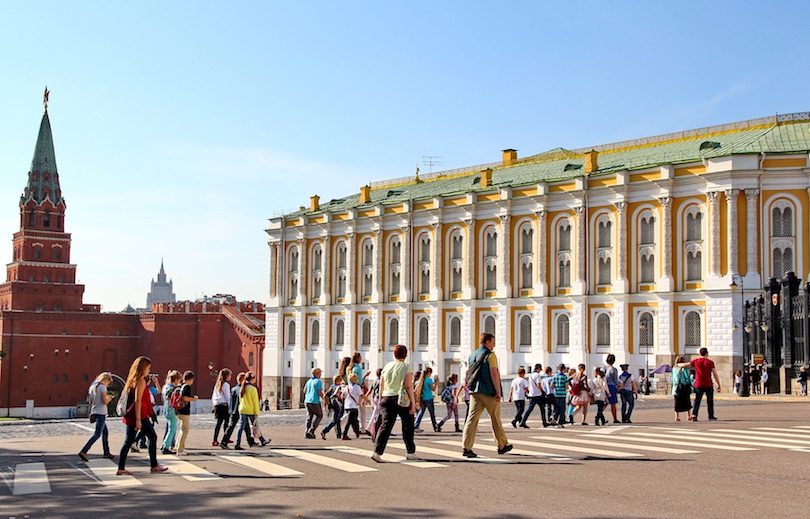
One of the oldest museums in the city, the Kremlin Armoury has a wealth of treasures; highlights include the ornate Grand Siberian Railway egg, the historic Cap of Monomakh and the stunning Imperial Crown of Russia which often has a crowd of tourists around it, jostling to take a photo.
Once the royal armory, there are loads of fascinating objects on display. Perusing the many sabers, jewelry, armor and more is as interesting as it is educational and entertaining and the swords are so finely crafted that you’ll almost wish you could pick up one and wield if yourself.
Established in 1851, the museum is situated in the Moscow Kremlin.
14. GUM Department Store

Standing for ‘Main Universal Store’ in Russian, GUM is stunning. Its wonderful skylights and beautiful facades mean it doesn’t look out of place alongside its illustrious neighbors on Red Square.
With over 200 shops, boutiques and upmarket eateries inside, it is a shopaholic’s heaven and concerned partners will be glad to find more affordable options alongside luxury brands such as Dior and Prada.
The main department store in the city, GUM was opened in 1893. The stunning architecture makes it well worth a visit even if shopping isn’t your thing.
13. Moscow Metro
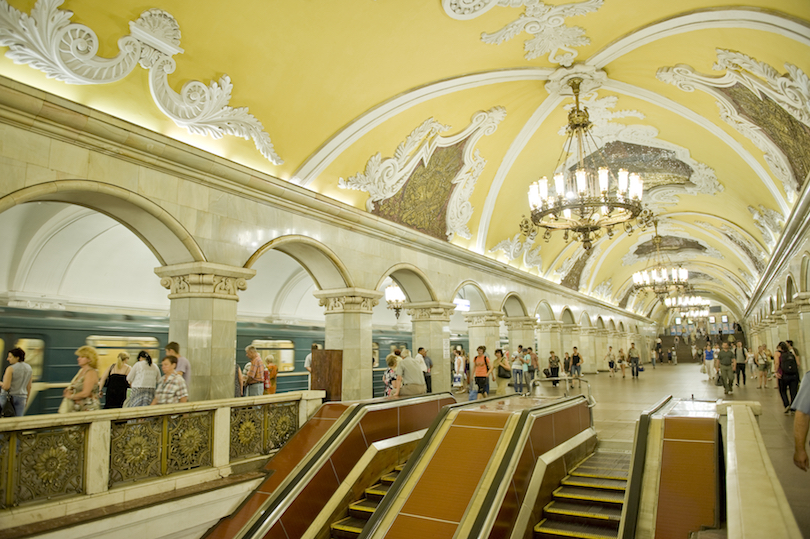
It’s not often that public transport looks like a work of art. So many stops on the Moscow Metro will astound visitors with their beauty and elegance.
Decked in marble and with frescoes covering the walls, the stations are amazing to gaze upon and are part of one of the longest metro systems in the world, with the first stations opened in 1935.
Using the metro is the quickest and easiest way to get around Moscow and braving the crowds of commuters is well worth it for the beauty all around you.
12. Arbat Street
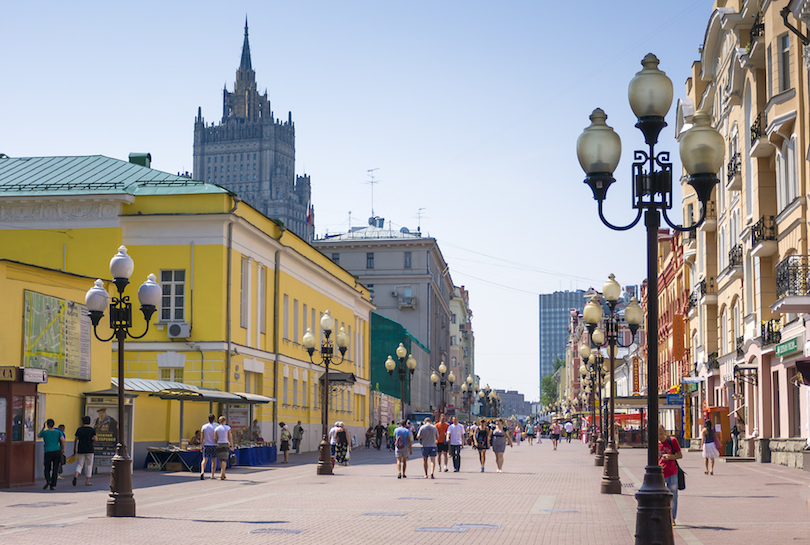
An elegant yet lively street, Arbat is full of impressive architecture and was once a popular place to live for aristocrats, artists, and academics.
A historic place, it is down Arbat Street that Napoleon’s troops are said to have headed on their way to capture the Kremlin.
Nowadays, there are many cafes, restaurants, and shops, as well as various monuments and statues to former residents such as Alexander Pushkin who was reputed to be a lover of the Russian Empress due to his massive influence in court.
11. Novodevichy Convent
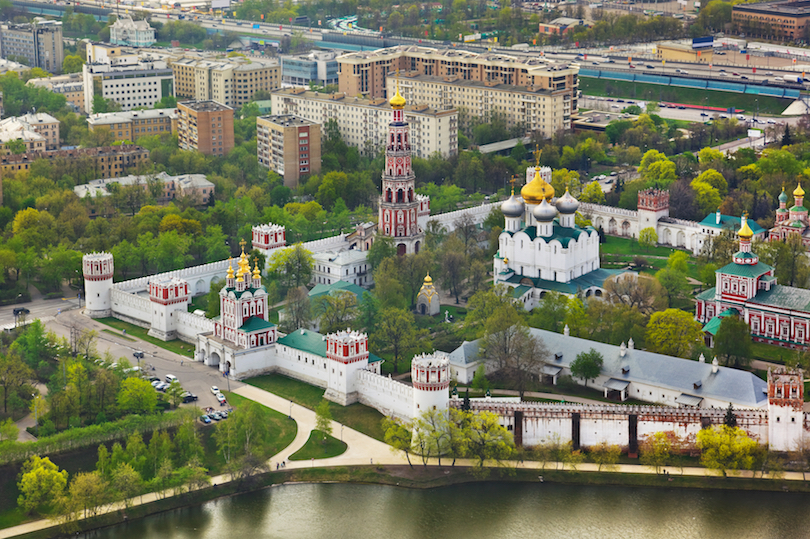
Drenched in history, the Novodevichy Convent is located in a striking building that was once a fortress. This captivating place is well worth visiting when in Moscow.
Founded in 1524, the convent houses four cathedrals; Smolensk Cathedral is the undoubted highlight due to its delightful 16th-century frescoes.
Wandering around the grounds is like stepping back in time. The Novodevichy Cemetery is where many famous leaders of the Soviet Union are buried, such as Yeltsin and Khrushchev.
10. Pushkin Museum
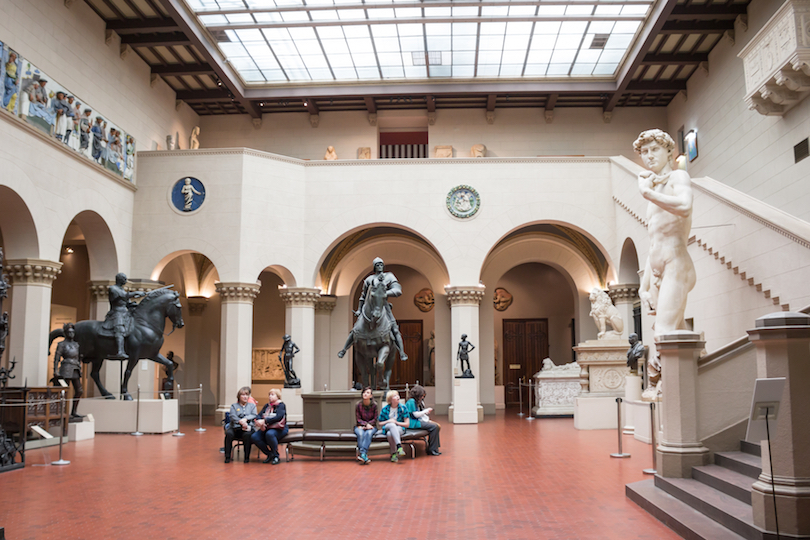
Despite its name, the Pushkin Museum of Fine Arts actually has no connection at all to the famous poet other than that it was named in his honor after his death. A delight to visit, its extensive collection focuses on European art with masterpieces by Botticelli, Rembrandt, and van Gogh all featuring.
Sculptures, graphic art, paintings and more can be found in its beautiful galleries; various sections look at themes and epochs such as the Renaissance, the Dutch Golden Age, and Byzantine art.
Among the many highlights are the clownish characters which can be found in Cezanne’s Fastnacht (Mardi Gras) and the twirling ballerinas who look so elegant in Degas’ Blue Dancers. Picasso’s Young acrobat on a Ball is also well worth checking out for its interesting use of shapes and colors.
9. Christ The Savior Cathedral
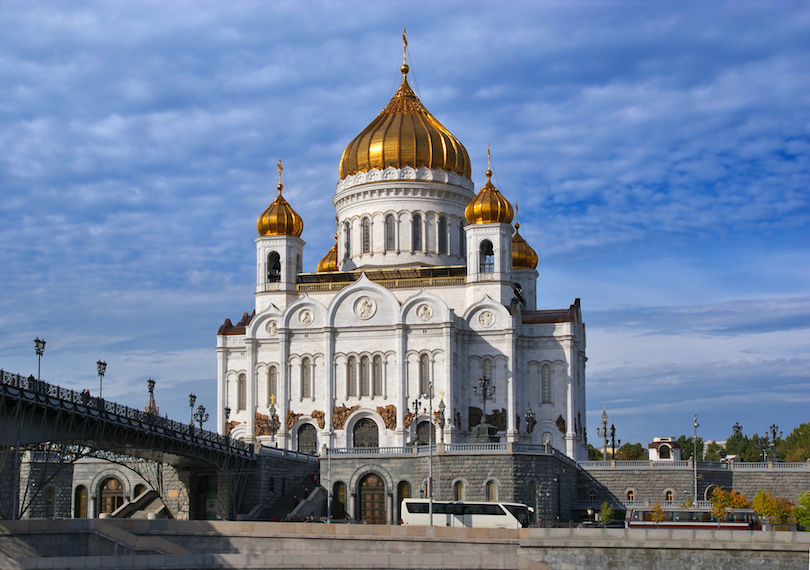
This gorgeous Russian Orthodox cathedral is located on the banks of the Moskva River, just a stone’s throw away from the Kremlin.
The church as it stands today was consecrated in 2000, as the original church that stood here was destroyed on the command of Josef Stalin in 1931 due to the anti-religious campaign.
With its delightful golden dome, spires and dazzling white facades, the Christ the Savior Cathedral is stunning. The interior is just as captivating to wander around, with its beautifully tiled floors and impressive altar.
8. Lenin Mausoleum
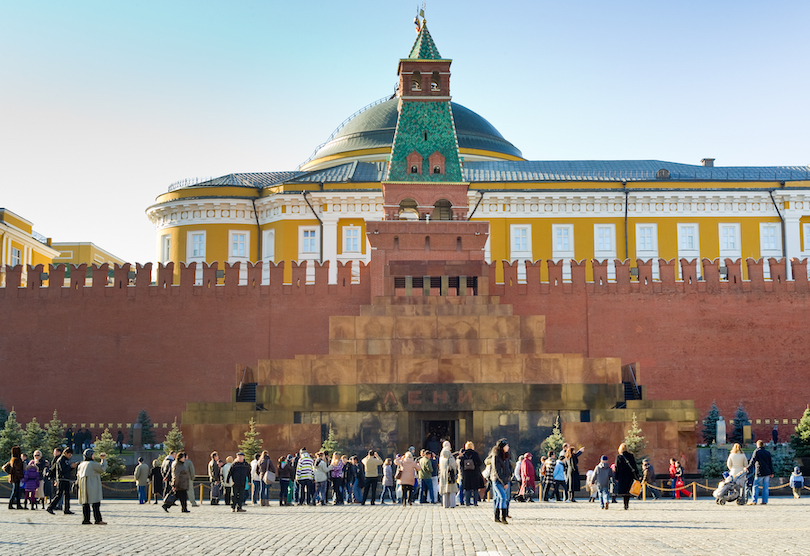
Opened to the public in 1924, Lenin’s Mausoleum is one of the most popular tourist attractions in Moscow. The red granite structure is located at the heart of the city in Red Square.
Lenin’s embalmed body lies in a glass sarcophagus; it is a somewhat eerie experience walking past the former leader of the Soviet Union but is well worth doing as you understandably can’t do it anywhere else in the world.
After visiting the mausoleum, head to the Kremlin wall right next to it for more graves of important communist figures such as Stalin and Brezhnev.
7. Tretyakov Gallery
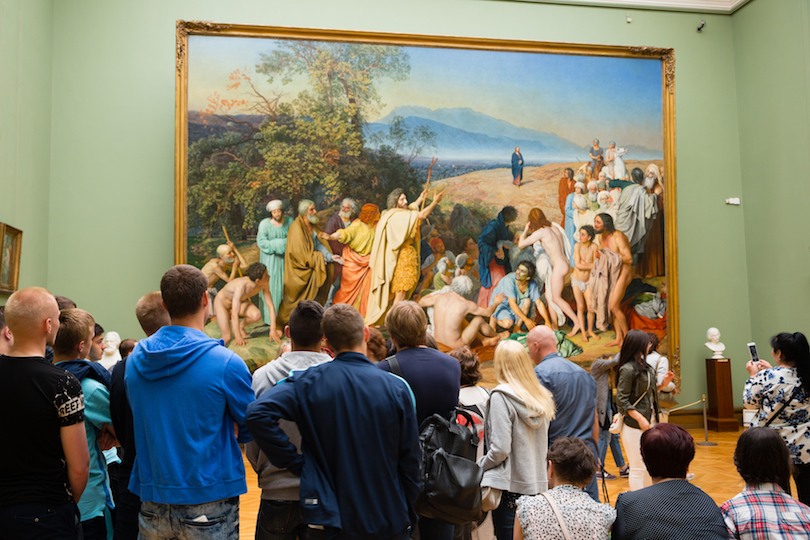
Home to the most extensive and impressive collection of Russian fine art in the world, the State Tretyakov Gallery is definitely worth visiting when in Moscow for the wealth of amazing art pieces that it has on display.
Having started out as the private art collection of the Tretyakov brothers, there are now over 130,000 exhibits. Highlights include the iconic Theotokos of Vladimir which you will almost certainly recognise despite probably not knowing the name and Rublev’s Trinity which is considered to be one of highest achievements in Russian art.
An absolute must for art lovers, the State Tretyakov Gallery will delight visitors with all that is has to offer.
6. Kolomenskoye
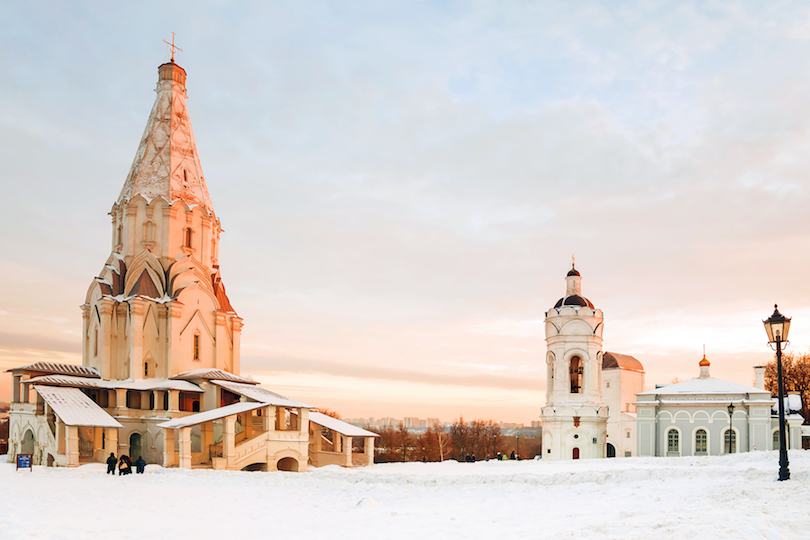
Once a royal estate, Kolomenskoye is now a museum-reserve and lies a few kilometers outside of the city center. A captivating place to visit, there is a plethora of history on show and the site overlooks the Moskva River.
Consisting of four historical sites, there are extensive gardens for visitors to explore, as well as loads of interesting old buildings, the former village of Kolomenskoye itself and the impressive Palace of the Tsar Alexey Mikhailovich – once considered the Eighth Wonder of the World by contemporaries.
Among the many stunning sights, it is the brilliantly white Ascension Church that is the undoubted highlight – dating back to 1532.
5. Gorky Park
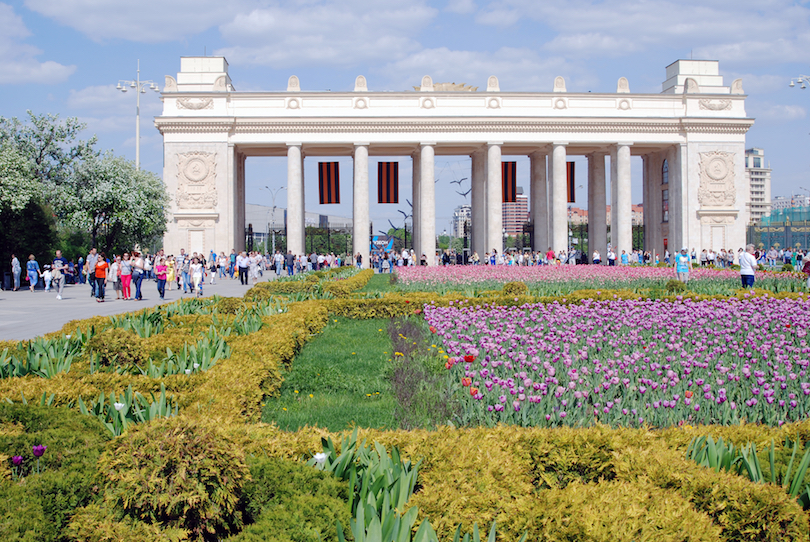
Lying alongside the Moskva River, the huge Gorky Park is a lovely place to visit. Its extensive gardens are home to numerous cultural institutions and visitors should definitely check out the Garage Museum of Contemporary Art and while the eclectic exhibits may not always feature such incredible sights as a balloon-covered rider on a zebra; they certainly always succeed in pushing back the boundaries of art.
Pop-up exhibitions and festivals can be found from time to time in the park itself and there is an open-air theatre and numerous eateries alongside a plethora of leisure activities.
Whether it’s cycling, table tennis or yoga that you are after or beach volleyball and rowing, Gorky Park certainly has it. In winter, there is a huge ice rink for visitors to enjoy.
4. Bolshoi Theatre
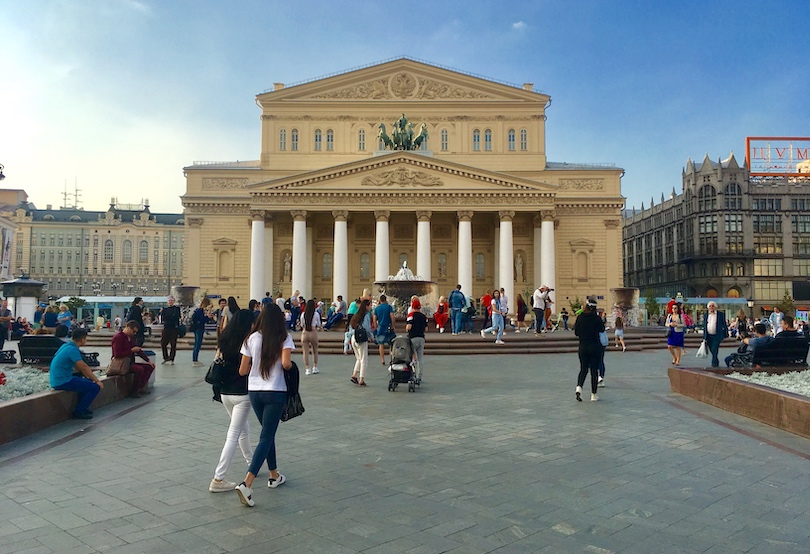
The Bolshoi Theatre is the main theater in the country. The amazing opera and ballet performances it has put on over the centuries go a long way in explaining Russia’s rich history of performing arts.
While the Bolshoi Ballet Company was established in 1776, the theater itself was opened in 1825. The glittering, six-tier auditorium is lavishly and decadently decorated; it is a fitting setting for the world-class performances that take place on its stage.
Spending a night watching a performance of such classics as The Nutcracker or Swan Lake at the Bolshoi Theatre is sure to be a memorable experience and the beauty all around you only adds to the sense of occasion.
3. Moscow Kremlin
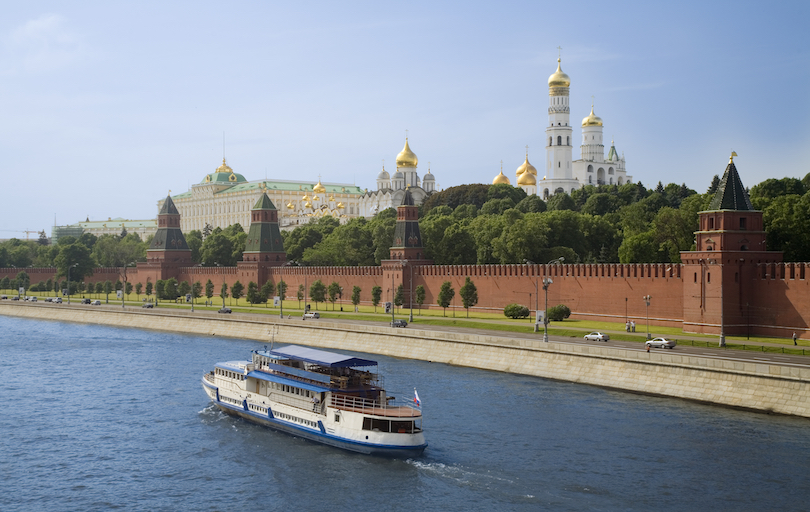
This famously fortified complex is remarkably home to five palaces and four cathedrals and is the historic, political and spiritual center of the city. The Kremlin serves as the residence for the country’s president. It has been used as a fort, and this fact is made clear by its sheer size. The Kremlin’s outer walls were built in the late 1400s.
Under Ivan III, better known as Ivan the Great, the Kremlin became the center of a unified Russian state, and was extensively remodeled. Three of the Kremlin’s cathedrals date to his reign that lasted from 1462-1505. The Deposition Church and the Palace of Facets were also constructed during this time. The Ivan the Great Bell Tower was built in 1508. It is the tallest tower at the Kremlin with a height of 266 feet (81 meters).
Joseph Stalin removed many of the relics from the tsarist regimes. However, the Tsar Bell, the world’s largest bell, and the Tsar Cannon, the largest bombard by caliber in the world, are among the remaining items from that era. The Kremlin Armory is one of Moscow’s oldest museums as it was established more than 200 years ago. Its diamond collection is impressive.
The Kremlin’s gardens – Taynitsky, Grand Kremlin Public and Alexander – are beautiful. The Kremlin has also served as the religious center of the country, and there is a tremendous number of preserved churches and cathedrals here. The collections contained within the museums include more than 60,000 historical, cultural and artistic monuments. Those who enjoy the performing arts will want to consider attending a ballet or concert at the State Kremlin Palace. Completed in 1961, it is the only modern building in the Kremlin.
2. Red Square
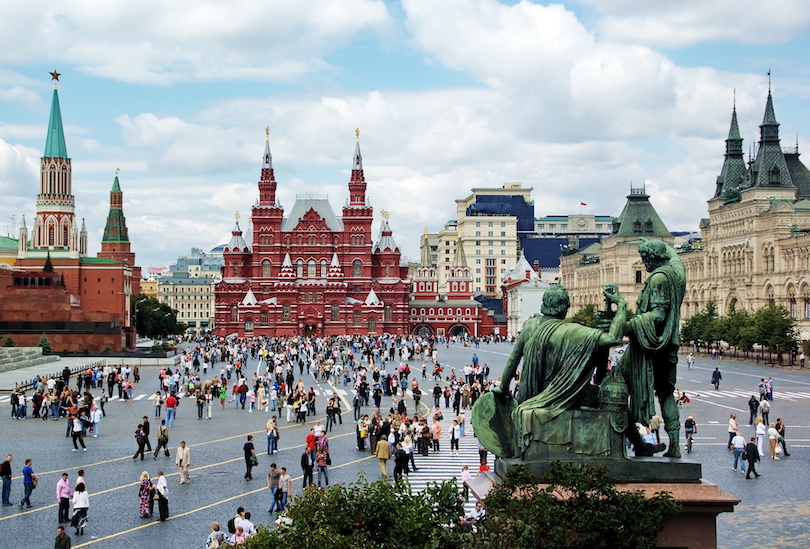
Lying at the heart of Moscow, Red Square is the most important and impressive square in the city. It is one of the most popular tourist attractions due to its wealth of historical sights and cultural landmarks.
Drenched in history, the huge square is home to incredible sights such as the Kremlin, St. Basil’s Cathedral and Lenin’s Mausoleum, among others. Consequently, it is not to be missed when in Moscow as it really is home to the city’s most stunning monuments.
It is here that many important moments in Russian history took place; the former marketplace has hosted everything from Tsar’s coronations and public ceremonies to rock concerts and Soviet military parades. Wandering around the massive square is a humbling experience and undoubtedly one of the highlights the city has to offer.
1. Saint Basil’s Cathedral
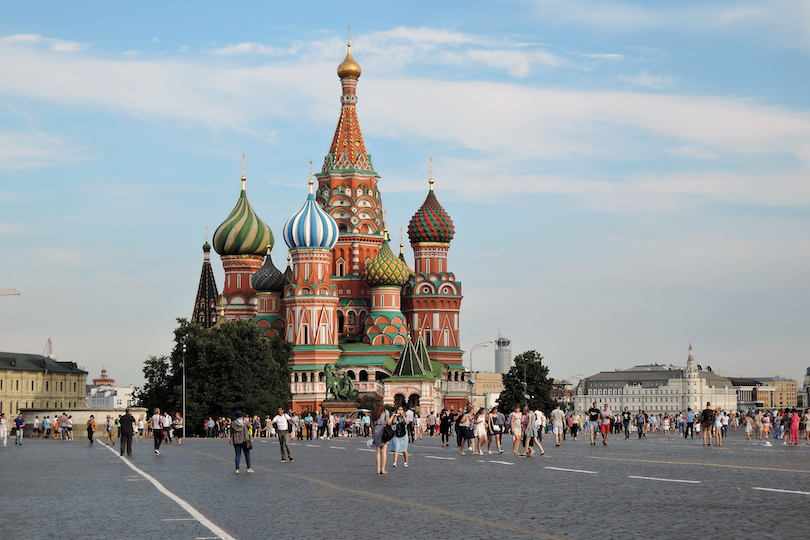
Located in the impressive Red Square, St. Basil’s Cathedral is gorgeous; its delightful spires appear as if out of a fairytale. The most recognizable building in the country, the cathedral is very much a symbol of Russia. No visit to Moscow is complete without having taken in its unique and distinctive features.
Ivan the Terrible ordered the cathedral’s construction in the mid-16th century, and legend holds that Ivan put out the architect’s eyes so that he would be unable to build another cathedral more glorious than St. Basil’s. Designed to resemble the shape of a bonfire in full flame, the architecture is not only unique to the period in which it was built but to any subsequent period. For various reasons, both Napoleon and Stalin wanted to destroy the cathedral but fortunately did not succeed.
Known for its various colors, shapes and geometric patterns, St. Basil’s Cathedral houses nine different chapels that are all connected by a winding labyrinth of corridors and stairways. On the lower floor, St. Basil’s Chapel contains a silver casket bearing the body of St. Basil the Blessed.
Throughout the cathedral are many beautiful murals, frescoes, wooden icons and other art works and artifacts. Outside the cathedral is a lovely garden with the bronze Monument to Minin and Pozharsky, who rallied an all-volunteer Russian army against Polish invaders during a period of the late 16th century known as the Times of Troubles.
Share this post:
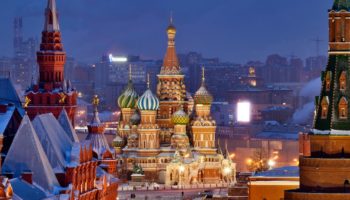
Where to Stay in Moscow
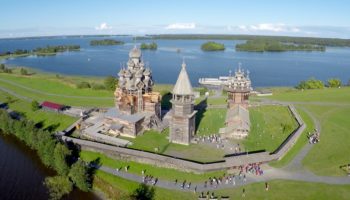
10 Top Tourist Attractions in Russia
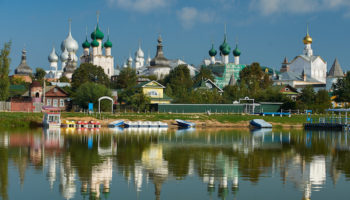
10 Best Places to Visit in Russia
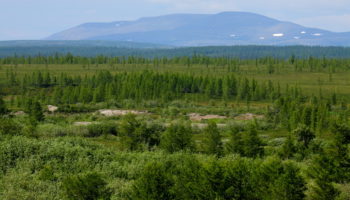
9 Most Beautiful Regions in Russia
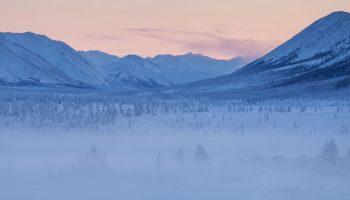
10 Most Amazing Destinations in Eastern Russia
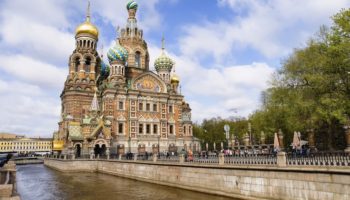
15 Best Attractions & Things to do in Saint Petersburg, Russia
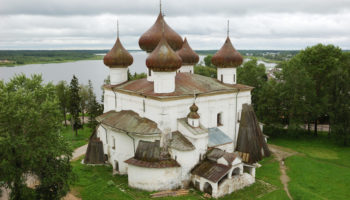
14 Most Scenic Small Towns In Russia
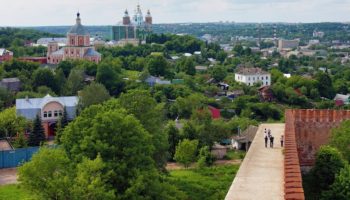
15 Best Cities to Visit in Russia
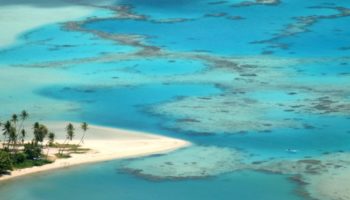
8 Most Beautiful Society Islands
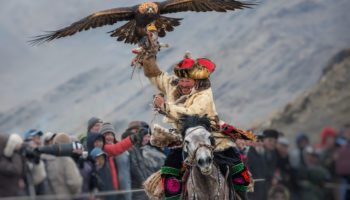
15 Best Things to Do in Mongolia

Moscow travel guide
Moscow tourism | moscow guide, you're going to love moscow.
Moscow is sometimes known as "The Third Rome" and it doesn't disappoint. With the amazing architecture and history behind some of the buildings, it's the perfect combination of contemporary mixed with historic.

Everywhere from the Moscow Business District to the Red Square will have some beautiful building or park and a plethora of delicious Russian food options. You'll be immersed in history everywhere you go, but you'll also see the signs of modern-day tsars.
The people of Moscow are welcoming and kind and can't wait to show you everything their city has to offer.
Top 5 Reasons to Visit Moscow
1. it's a history buff's paradise.
Moscow has a rich history, and not just from the time of the USSR. If you love history than the stories behind every building, landmark, and road in Moscow will have you chomping at the bit for more. Be sure to take a historic tour of the city.
2. It's an Architectural Dream
Moscow's architecture is unmatched, and the design and colors of every building are breathtaking. Visit the Kremlin, built in the 15th century, or Saint Basil's Cathedral from the 16th century.
3. Art Galleries and Museums Aplenty
There's nothing quite like Russian art, and Moscow is home to some of the world's most impressive collections. Be sure to visit the Tretyakov State Gallery or if you're into something more modern, the ARTPLAY Design Center and Flacon Design Factory.
4. The World-Renowned Subway Stations
Not many cities can claim their train stations as a drawcard, but the Moscow subway, built in 1935, is truly like walking through a royal castle. You can only imagine the engineering that went into building something so complex and impressive.
5. The Russian Theater
Probably the biggest draw to Moscow is the Russian Theater, which hosts everything from plays to ballet. The Bolshoi Ballet Company is among the most well-known symbols of Russia and experiencing this in person is incredible.
What to do in Moscow
1. moscow kremlin: russia's must-see.
The first stop in Moscow is the Red Square - home to the iconic St. Basil's Cathedral with its multicolored domes, and the gateway to the Kremlin. Just past Lenin's Mausoleum, this fortified citadel was built for royalty. Overlooking the river, it boasts a density of cathedrals and palaces behind thick walls. Step into the State History Museum and the Museum of Fashion for contrasting but equally enthralling Russian learning opportunities, or enjoy a stroll through the Aleksandrovsky Garden.
2. Bolshoi Theatre: The Show Must Go On
The Bolshoi Theater is a historical gem. This grand institution has hosted the famous Russian opera and ballet for centuries, and the performances have never lost their grandeur. The most talented opera singers and ballet dancers keep coming from Russian schools. Naturally, it is the ultimate venue to immerse yourself when it comes to traditional performance. The little sister to the Bolshoi, Maly Theater, is just across the street.
3. Cathedral of Christ the Saviour: A Worthwhile Reconstruction
This Orthodox Christian church was one of the tallest in the world until it was demolished by Stalin in 1931, as he planned to have the "Palace of the Soviets" built. Of course, this idea never came to fruition, and the Cathedral of Christ the Savior was certainly significant enough to rebuild. Since 1997 it has become a huge attraction for its beauty as well as a symbol of the country's tumultuous history. The golden domes shimmer from across the city, and the interior is fabulously colorful.
4. Gorky Park: Where Everyone Comes out to Play
This "Central Park of Culture and Leisure" lives up to its self-proclaimed title, boasting newly renovated recreation zones for visitors of all ages. For the ultimate experience, hop on the Sokolnicheskaya Metro Line and get off at Park Kultury to walk over the Crimean Bridge - the first thing you will see is the Main Gate of Gorky Park. From amusement rides to ice skating rinks, activities abound. Not to mention the simple delight of strolling by the river or lounging on the grass.
5. State Tretyakov Gallery: One Thousand Years of Art
The largest collection of Fine Russian Art in the world is found in Moscow's Tretyakov Gallery. National glory is celebrated across the halls of this museum, giving artists a platform when their work is often overlooked in foreign collections. Particularly telling are the modern art galleries, which exhibit political art created largely in response to the fascinating and tumultuous history of Russia over the 20th century.
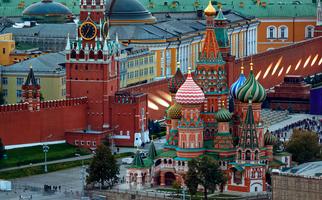
Activities & attractions in Moscow

Where to Eat in Moscow
Moscow is great for food of all types. There are high-end dining restaurants, some of which are world renowned, but there is also a lot of tasty street food and mid-range dining as well. For a luxury experience, try Savva in the city center, but expect to pay anywhere from ₽1,590 to ₽3,200 for a main. If you opt for street food, you'd be looking at paying around ₽400. For some lovely mid-range dining experiences great for solo travelers, couples, or families, check out Chaikhona No. 1 in Pushkin or Mari Vanna in Tverskaya. Mains here will be around ₽700 to ₽900. Drinks vary in price, but a beer will usually cost somewhere around ₽300.
When to visit Moscow
Deciding when to visit Moscow depends a lot on your budget and your durability. Russian winters are incredibly harsh with temperatures that reach below zero on some days and winds that will chill you to your core. This kind of weather isn't for everyone, but in the summer the temperatures can reach the high 80s. Shoulder seasons are a great time to experience Moscow because the temperatures are mild enough to enjoy the sights. Summers will always cost more because it's a peak travel period.

How to Get to Moscow
Most visitors come into Moscow by plane. The main airports are Sheremetyevo International Airport (SVO), Domodedovo International Airport (DME), and Vnukovo International Airport (VKO). Sheremetyevo International is approximately 20 miles from the center. The best way to get into Moscow is by the Aeroexpress, which costs ₽500. Domodedovo International is around 28 miles away. To get into the city, take the train from the Paveletsky Rail Terminal for ₽470 rubles. Vnukovo International is about 19 miles from the city, and you can take the train for ₽470.
Although there are quite a few trains into Moscow from other European cities, it's not a particularly popular mode of transport since the journeys are quite long. There are nine train stations in Moscow, but the main one is Leningrad Station. The main train route is the overnight train from Warsaw on Russian Railways, which costs around ₽9,000.
The M1 goes into the city from the west and the M7 goes into the city from the east. Moscow has two circular highways around it, the Third Ring Road and MKAD. This makes it easy to approach the city from any angle once you get in from the M1 or M7.
Similar to the train, approaching Moscow by bus isn't a very common way to get there. However, Lux Express has many routes to Moscow. You can travel from Riga, Tallinn, Berlin, Warsaw, Minsk, Budapest, and more.
Airports near Moscow
Airlines serving moscow, where to stay in moscow.
When it comes to accommodation, Moscow has a little bit of everything. It does luxury beautifully, with stunning 5-star hotels dotted around the city with breathtaking views, such as the Ritz Carlton in Tverskaya, or the Ararat Park Hyatt Hotel in the city center. If you're after budget options, there are plenty of mid-range hotels such as the Hilton, and many excellent hostels, such as the Davydov Hostel in the Arbat district.
Popular Neighborhoods in Moscow
Tverskaya Street - this area north of the business district is one of Moscow's most popular. Famous for its amazing cafes, nightclubs, and overall nightlife, this is the suburb to be in for a fantastic party time.
Petrovka - east of Tverskaya lies this district, which is a perfect upmarket area for boutique shopping. You'll also find lots of historic sights here like two ancient monasteries.
Arbat district - although this district is very touristy, its colorful appearance and cute eating establishments make it a lovely area to pass some time without spending a fortune.
Where to stay in popular areas of Moscow
Most booked hotels in moscow, how to get around moscow, public transportation.
The public transportation routes in Moscow are excellent with a very well-connected subway network, trams, and buses. You can buy tickets ranging from a single journey all the way up to 60. One journey only costs ₽28.
Unlike other large cities, taxi prices in Moscow are relatively reasonable. You can expect to pay a base fee of around ₽150, and then about ₽90 per mile. There are plenty of taxis around Moscow, so you shouldn't have any problems flagging one down.
With multiple Hertz, Avis, Sixt, and Elite outlets, you'll have your pick of rental companies, and you can expect to pay around ₽2,403 a day. Rates become cheaper the longer you rent. For a three-day rental, expect to pay around ₽6,310.
The Cost of Living in Moscow
Shopping streets.
Moscow is great for high-end luxury shopping, but it also has many popular international stores that you would expect to see as well. The street for top-of-the-line jewelry and items is Tretyakovsky Proyezd, located in the city center. At Izmailovsky Park you'll find a large open-air bazaar where things will be much more affordable, but you will have to pay an entrance fee of ₽50.
Groceries and Other
Moscow is filled with cheap markets to find all kinds of delicious food at affordable prices. However, for your other grocery or personal needs, you'll find the big chain Auchan or the more upmarket Perekrestok. A loaf of bread will cost around ₽50, and a dozen eggs will cost about ₽109.

15 Top-Rated Tourist Attractions & Things to Do in Moscow
Written by Diana Bocco Updated Dec 23, 2023 We may earn a commission from affiliate links ( )
Moscow is one of Europe's most enigmatic destinations, home to a fascinating history and colorful, awe-inspiring architecture you won't find anywhere else in the world. Moscow might be one of the most populous cities in the world with over 11 million inhabitants, but this hasn't changed its strong cultural and social traditions.
Walk the cobblestone streets of the Red Square or the banks of the Moskva River early in the morning, and it's hard to tell what century you're in.
Tsarist architecture, must-see churches, and glamorous shopping opportunities blend together for a visual experience you won't forget. For ideas on what to see and do while visiting Russia, here's our list of top tourist attractions in Moscow.
1. Marvel at the Size of the Kremlin
2. catch a performance at the bolshoi theatre, 3. shop at the luxurious gum, 4. make your way into lenin's mausoleum, 5. spend an hour (or three) at red square, 6. discover history at the museum of cosmonautics, 7. ride the stunning moscow metro, 8. explore the moscow state integrated museum-reserve, 9. spend a rainy day at the tretyakov gallery, 10. walk up and down arbat street, 11. stop by the vdnkh all-russian exhibition centre, 12. wander around gorky park, where to stay in moscow for sightseeing, map of tourist attractions & things to do in moscow.
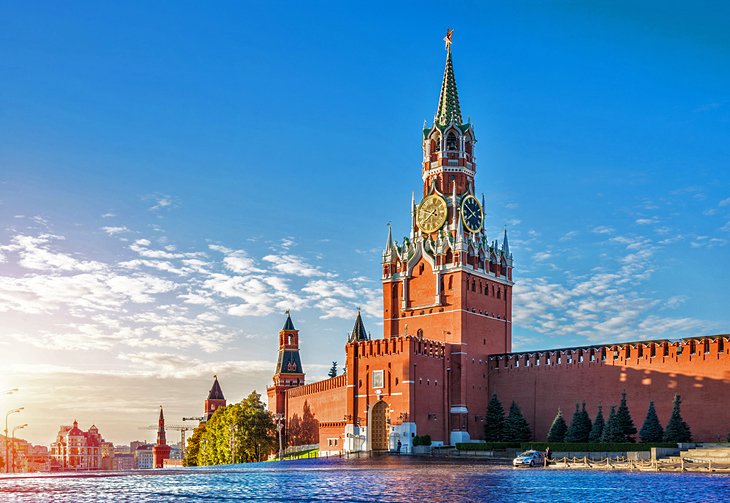
Moscow's most recognizable structure is without a doubt the Kremlin, a 15th-century fortified complex that covers an area of 275,000 square meters surrounded by walls built in the 1400s.
The Grand Kremlin Palace -which has over 700 rooms- was once home to the Tsar family and is now the official residence of the president of the Russian Federation, although most heads of state choose to reside elsewhere.
The massive complex also includes many other buildings, some of which are open to the public and can be visited regularly. Aside from three cathedrals (including one where the Tsars were once crowned) and a number of towers, the Kremlin is also home to the Armory building, a museum holding everything from the royal crown and imperial carriages to the ivory throne of Ivan the Terrible and Fabergé eggs.
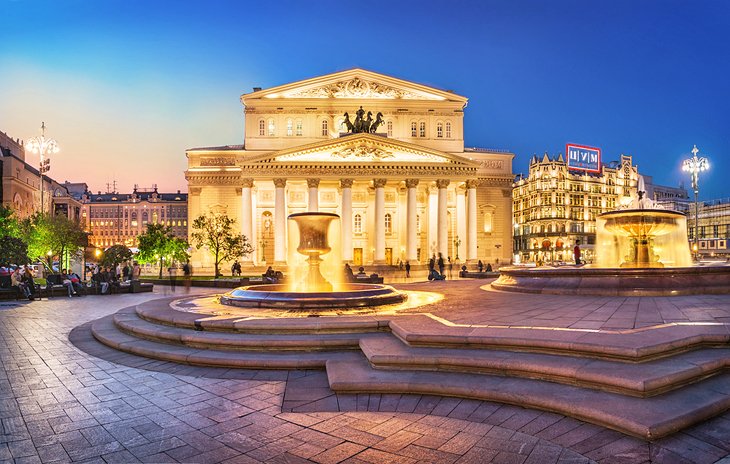
The Bolshoi Theater is home to the largest and one of the oldest ballet and opera companies in the world . While the theater has undergone several major renovations over the past century-including a recent one in 2011 to restore some of the imperial architectural details-it still retains all of its Neoclassical grandeur.
The Bolshoi Theater you see today opened in 1824, after several older versions burned down. Inside, red velvet, a three-tiered crystal chandelier, and gilt moldings give the place a Byzantine-Renassaince grandiose feel like no other.
Catching a show from the resident ballet and opera troupes is a treat, as the theater often presents a number of classic performances, such as Tchaikovsky's Mazeppa and Rachmaninoff's Francesca da Rimini, both of which originally premiered here.
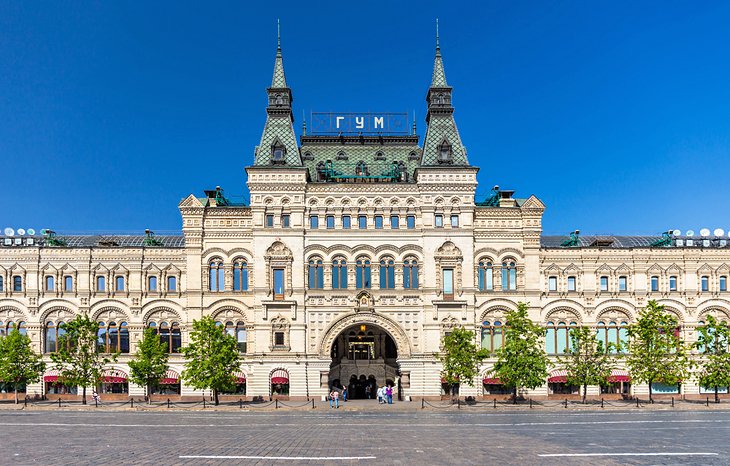
Moscow's oldest and most upscale shopping center is an architectural marvel. GUM (short for Glávnyj Universálnyj Magazín or "Main Universal Store") was built in the late 1800s in neo-Russian style to showcase a beautiful mix of a steel skeleton and 20,000 panels of glass forming an arched roof.
This was a unique construction at the time, since the glass had to be strong enough to support the snow-heavy Russian winters. The building is just as impressive outside, with all three levels covered in marble and granite.
While GUM is no longer the largest shopping center in Moscow, it's still by far the most beautiful. Home to brands like Gucci and Manolo Blahnik, this might not be the ideal destination for most budget-conscious visitors, but the beauty of the building itself is worth a visit.
On the third floor, there are also great dining options, including a Soviet-style canteen that serves traditional Russian food, and a stand selling ice cream made by hand using an original 1954 recipe originally approved by the Soviet government.
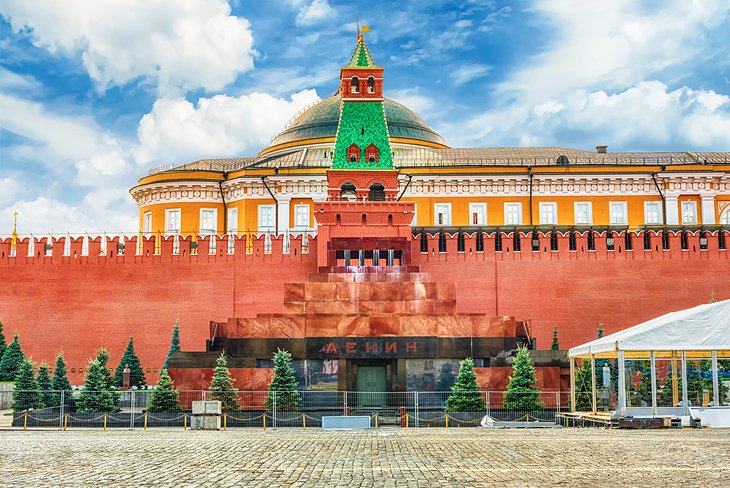
Lenin's Mausoleum, the final resting place of Soviet leader Vladimir Lenin, occupies a central spot in Red Square. His body has been in the mausoleum since his death in 1924-and although the original plan was for him to be buried after a short period of public display for mourning, the plan quickly changed.
After over 100,000 visited the tomb over a period of six weeks, it was decided that a new sarcophagus and a more permanent display space could actually preserve Lenin's body for much longer than expected-and Lenin's Mausoleum was built.
Over the years, the mausoleum and its marble stairs also became the main spot from where Soviet leaders would watch parades and events happening in Red Square.
Lenin's embalmed body can still be seen today, lying down in a bulletproof glass sarcophagus as if he's sleeping. While a visit to the mausoleum is certainly unusual, it has become a must-do for history buffs looking to understand how Lenin's legacy truly changed the nation. Come ready to wait, though -there are usually lines to get in.
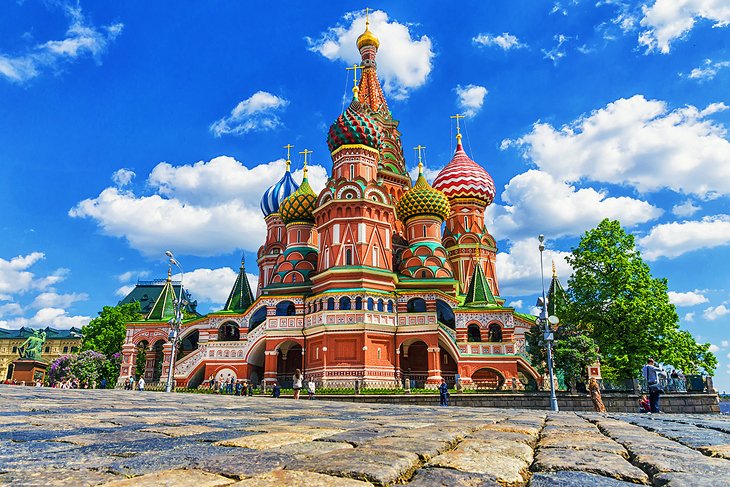
All of Moscow's main streets start at Red Square, so it's easy to see why this is considered the heart of the city. A massive space of 330 meters by 70 meters, the square is flanked by the Kremlin, Lenin's Mausoleum, two cathedrals, and the State Historical Museum.
In 1945, a massive Victory Parade was held here to celebrate the defeat of Nazi Germany by the Soviet Armed Forces.
St. Basil's Cathedral , one of the most recognizable buildings on the square, was built in 1555. The unique cathedral has architectural details inspired by Byzantine and Asian design, as well as details that resemble those found in famous mosques. There are nine individual chapels inside the church, all decorated with colorful mural art.
Both the square itself and the Kremlin are recognized as UNESCO World Heritage Sites . On weekends, there are sometimes stalls selling souvenirs and traditional items here, such as matryoshka (Russian nesting dolls), at the entrance of the square.
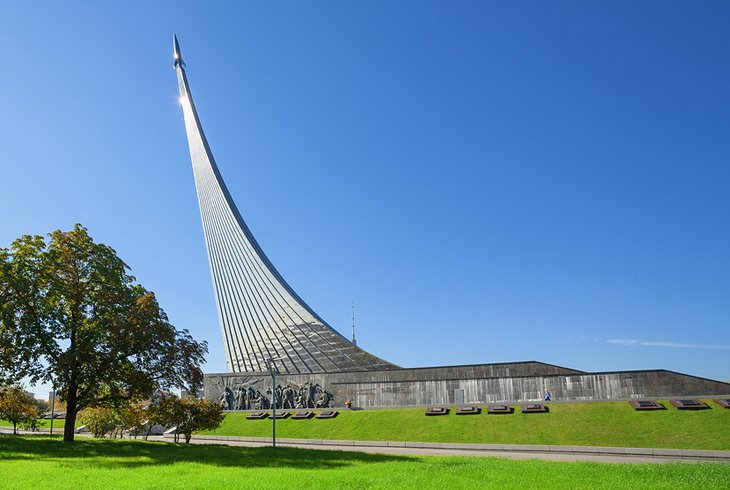
At one point, Russia and the US were toe-to-toe when it came to space exploration. While that might no longer be the case, the museum's amazing collection-which includes over 85,000 items-is still awe-inspiring.
Main exhibits include the space capsule used by Yuri Gagarin , the first human to travel into outer space; a USSR flag with moon fragments; a Soviet spacesuit; and a rocket propulsion unit from the 1960s. A special two-story hall showcases sections of the Mir space station interior, and there are also models of the first sputniks and a replica miniature spaceship.
English-language tours are available, and there's also a Cinema Hall showing subtitled short films about the history of space exploration programs and the first manned space flight.
The museum is located inside the base of the monument to the Conquerors of Space, which was built almost 20 years before the museum opened.
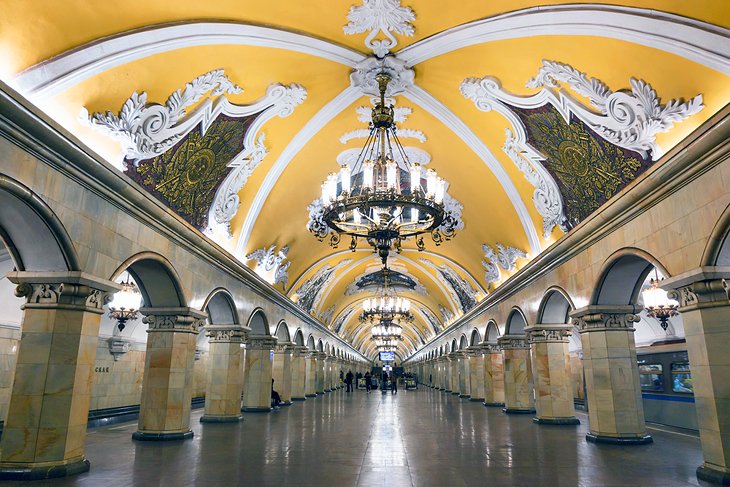
Riding the Moscow metro is an experience all in itself, but even just heading underground to walk through the stations is something no visitor should miss. With 223 stations and 12 metro lines crosscutting through Moscow, however, this can be tricky, so visiting at least a few of the most impressive ones is a good start.
Arbatskaya station was designed by a skyscraper architect, so it's no surprise that it features multicolored granite slabs and impressive bronze chandeliers.
Park Kultury station , located next to Gorky Park, is covered in marble and features reliefs of people involved in sports, while Teatralnaya station is decorated with porcelain figures dancing and wearing traditional Russian costumes.
The metro is open between 5:30am and 1:00am but it's very crowded in the early morning and after 4pm, so it's better to visit in the late morning or early afternoon to really appreciate the architecture without the crowds.
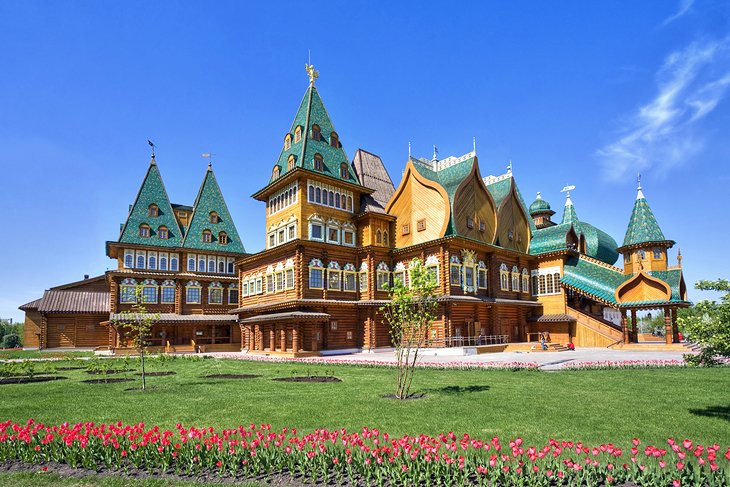
The Moscow State Integrated Art and Historical Architectural and Natural Landscape Museum-Reserve is a cultural open-air museum complex comprised of four different historical sites.
The most important site, the Kolomenskoye Estate, was once the summer residence of Tsars as far back as the 14 th century. The complex, which covers almost 300 hectares, is home to fairy-tale wooden palaces; a tent-roof stone church built in the 1500s; a water tower; fort towers and structures; and the 24-room Museum of Wooden Architecture , which includes the restored dining room of Tsar Alexei I.
Beautiful manicured gardens , riverside picnic areas, and a massive collection of both artifacts and structures make this a great destination to help you see what medieval Russia looked like. English-language tours are available, but you're also free to wander the grounds on your own.
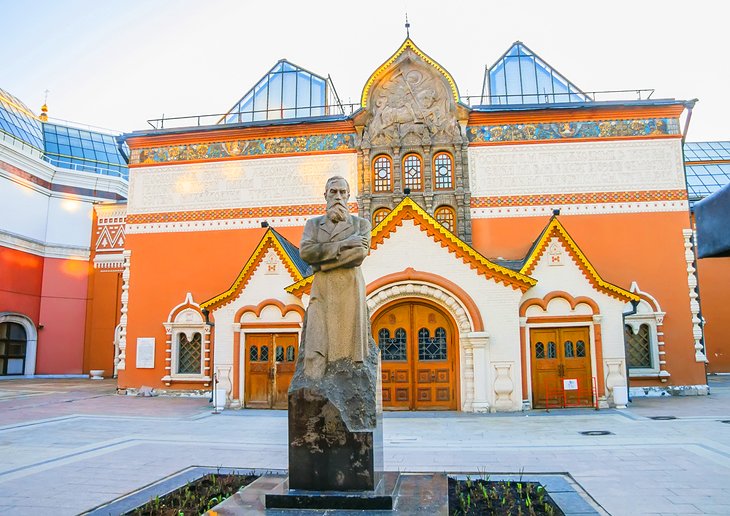
The largest collection of Russian art in the world sits here, with over 180,000 paintings, sculptures, and religious art dating back to over a millennia ago. The gallery, built using beautiful red and white colors from classical Russian architecture, is located near the Kremlin and it was built in the early 20 th century.
Significant art pieces include the Vladimir Mother of God; a Byzantine icon of the Virgin and child dating back to the 1100s; Andrei Rublev's The Trinity icon from the 15 th century; and several works by Ilya Repin, the most famous realist painter in Russia.
On the grounds of the museum, there is also an 86-meter-tall statue of Peter the Great, as well as a number of Socialist Realism sculptures.
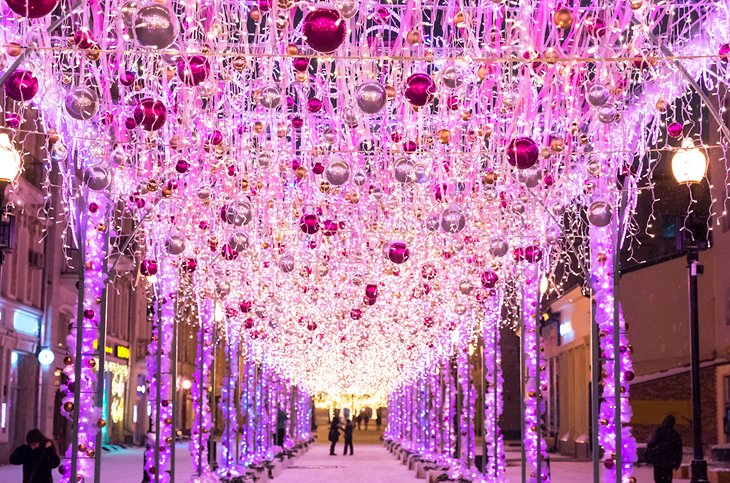
Moscow's one-kilometer-long pedestrian street has been around since the 15 th century. Originally a trade route in the outskirts of the city, Arbat Street is now very centrally located, home to posh buildings and lots of places to eat and shop.
Beautiful street lamps and two significant statues-one of Princess Turandot (from Puccini's last opera) and one of Soviet-era poet Bulat Okudzhava-adorn the street, which fills up with both locals and tourists on evenings and weekends.
A great place to pick up souvenirs or sit down at an outdoor café, Arbat Street also offers a chance to visit the former home of poet Alexander Pushkin and the café both Anton Chekhov and Leo Tolstoy used to visit.
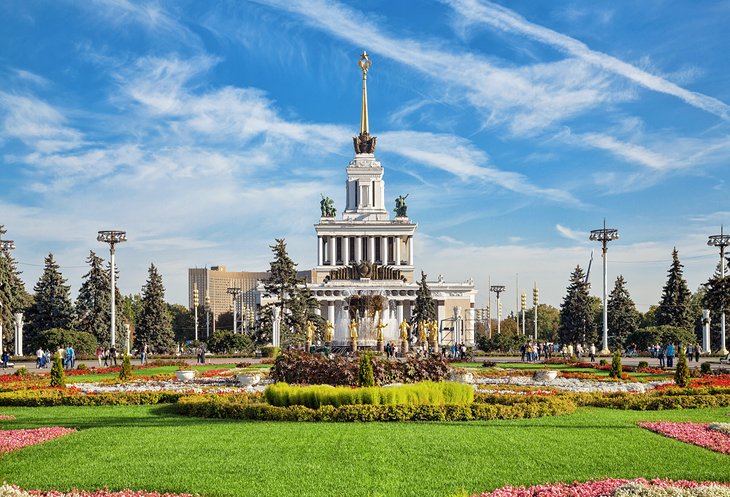
Although it was originally designed as a general-purpose trade show venue, this park complex now houses amusement rides , ice rinks , and a number of galleries and other attractions for all ages.
The park's most famous landmarks are the Moskvarium, a marine biology center home to over 8000 species of marine animals, the Garage Museum of Contemporary Art, and a shopping center selling traditional products from former Soviet countries.
There's even a film museum showing Soviet cartoons or even a full-length film (for an extra fee) and an education center offering masterclasses on everything from becoming a barista to video montage (call or write in advance to find out which ones are English-friendly).
Soviet-era pavilions, sculptures, and fountains abound here as well, including the famous Friendship of the Peoples Fountain, which features statues of women dressed in costumes from different former Soviet countries.
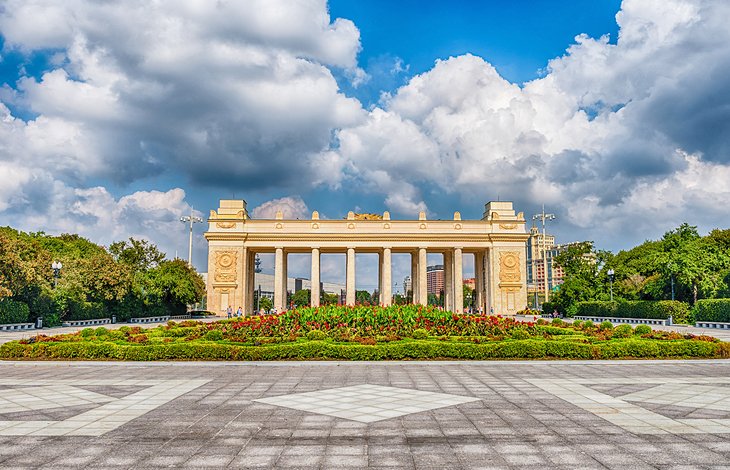
Named after the famous Russian writer Maxim Gorky (who was nominated for the Nobel Prize in Literature five times but never won it) and sitting right across the Moskva River, Gorky Park covers 120 hectares of beautiful ponds and green spaces.
Popular with both locals and tourists, the park offers a variety of things to enjoy-from sunbeds, hammocks, and drinking fountains to free yoga classes and children's playgrounds. There's free Wi-Fi and sockets for charging your phone, as well as many food stands and plenty of wild animals, including deer, rabbits, and pheasants.
Visitors can rent paddle boats and bicycles to explore the park-and from May to October, there is also an open-air movie theater, as well as scheduled presentations by street performers, musicians, and artists. Gorky Park attracts the young and old, so don't be surprised to see a mix of people exercising, playing chess, and sunbathing.
Luxury Hotels :
- Lotte Hotel Moscow is one of the top 5-star properties in Moscow offering the largest Royal Suite in Russia. The trendy rooms and suites here all have contemporary style and great city views. On-site amenities are plentiful. There are two restaurants: one serving contemporary Italian fare, and the other Japanese. There is an impressively lit indoor swimming pool, a well-known spa, and a state-of-the-art gym.
- Another excellent luxury hotel is the Ararat Park Hyatt Moscow . The residential-style property is in the heart of Moscow just next to the Bolshoi Theatre and within walking distance of the Kremlin and Red Square. The rooms and suites have been opulently designed by Tony Chi. The on-site restaurant serves a mix of European and Armenian specialities. There is also a Japanese sushi bar and a rooftop lounge with fabulous city views.
- The St. Regis Moscow Nikolskaya also has a central location just a few minutes from the Kremlin and Red Square. The 5-star property has a mix of elegant rooms and suites, including interconnecting room options for families with kids. There are multiple restaurants on-site including an Italian bistro. Other amenities include the fabulous Iridium Spa, which does a full range of treatments and has an indoor swimming pool, sauna, and steam room.
Mid-Range Hotels :
- Palmira Business Club is a top mid-range choice. The contemporary lifestyle hotel offers well-appointed rooms and suites, including options for families. Suites are quite spacious and have kitchenettes. Amenities here include a complimentary breakfast at the on-site restaurant, a hot tub, sauna, and spa. There is also a fitness center.
- The trendy Mercure Moscow Baumanskaya offers a mix of rooms and suites with contemporary decor. The mid-range hotel can arrange airport transportation and offers baggage storage. Other amenities include a restaurant and room service. The front desk is open 24 hours.
- Boutique Hotel Brighton is about 10 minutes from the city center in a leafy park area. It offers excellent value for money and has charming rooms and suites with sound-proof windows and doors, as well as blackout curtains. A complimentary breakfast is served, and there is also an indoor swimming pool.
Budget Hotels :
- Hotel Ibis Budget Moscow Panfilovskaya is about a 15-minute drive from Moscow's downtown, and it's within walking distance from a metro station that will take you there. The soundproof rooms at this budget property are clean, comfortable, and can sleep up to three people. The hotel is pet friendly, has paid parking available on-site, and also has a salon.
- If you just need a budget hotel near the airport then check out Aviator Hotel Sheremetyevo . Located right at the airport, it has soundproof rooms, including options for families. Amenities include an indoor play area for kids, a sauna and swimming pool, and a free breakfast.
More Related Articles on PlanetWare.com
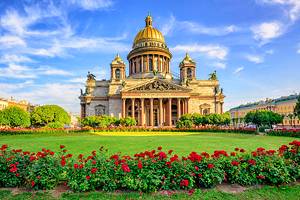
Exploring Russia: Whether you are interested in history, nature, or architecture, there's much to see in Russia. For a good introduction to some of the most fascinating spots in the country, take a look at our article on the Best Places to Visit in Russia . For more on Russia's second-largest city and all it has to offer, check out our piece on the Top-Rated Tourist Attractions in St. Petersburg .


IMAGES
VIDEO
COMMENTS
National Pantheon of Venezuela. 10. Parque Nacional Los Médanos de Coro (Medanos de Coro National Park) 11. Mochima National Park. 1. Angel Falls. Angel Falls. In the heart of the country, where table top mountains rise up like giant monoliths from the surrounding landscape, is Angel Falls.
10. Morrocoy National Park [SEE MAP] ruurmo / Flickr. Morrocoy National Park is located in the northeastern part of Venezuela. It contains an area of mangroves and numerous islets and cays with beautiful sandy beaches. Coral reefs and tropical fish are abundant in the waters around the cayos.
1. Angel Falls. Source: Douglas Olivares / shutterstock. Angel Falls. Venezuela is home to the world's highest waterfall. Needless to say, this is the most popular destination in the country. With nearly a 1 kilometre drop, spectacular is really the only word to describe it.
4. Coche Beach. 1,825. Beaches. Located along an extensive sandy tongue at the northwestern tip of Coche Island - which together with the islands of Margarita and Cubagua make up the Nueva Esparta State. Coche Beach or Playa La Punta is by far the most famous and popular beach of this kind in the Americas - arid and beautiful.
1) Salto Angel. Angel Falls, at 979 meters high, proudly boasts being the highest waterfall in the world. Located in the Venezuelan Gran Sabana, this is a place holding a sacred character for the natives. It is, without a doubt, the biggest out of all Venezuela tourist attractions.
1. Angel Falls. The heart of Canaima National Park holds one of the most beautiful places in Venezuela—the magnificent Angel Falls. Standing as the world's highest uninterrupted waterfall, its waters majestically drop an astonishing 979 meters. It is an amazing masterpiece of nature's prowess.
Madrizquí. The nearest island to Gran Roque, Madrizquí is only about 1km (0.6mi) to the southeast. It was the favorite island of affluent caraqueños (people from…. Discover the best attractions in Venezuela including Museo de Arte Contemporáneo de Caracas, Salto Ángel (Angel Falls), and Iglesia Santa Capilla.
12 Best Islands In Venezuela - Updated 2024. 12 Popular Festivals In Venezuela. Top 12 Things Venezuela Is Famous For. 1. Cayo Sombrero. Source: Photo by Wikimedia Commons user AndreaC11 used under CC BY-SA 3.0. Cayo Sombrero, also known as Key Hat, nestles discreetly amidst the azure waters of the Caribbean.
Venezuela. South America. Venezuela, home to some of South America's most incredible landscapes, rightly has a terrible image problem at the moment. Hyperinflation has led to a dramatic drop in living standards and issues with the supply of basic goods, while personal safety, particularly in Caracas, is worse than anywhere else on the continent.
Your ultimate Venezuela travel guide, with tips, and things to see and things to do in Venezuela. Great for first-time and returning travelers. Rich with culture, history, and friendly locals, Venezuela is a chance to see something different. Located on the northern coast of South America, it is filled with many white-sand beaches, blue waters ...
Some of the best islands to visit are Francisqui, Noronkey, Madrisqui, Crasqui and Dos Mosquises Islands. The weather is warm, the sun shines daily and the waters are perfect for snorkeling! 4. Orinoco Delta, Eastern Venezuela. The Orinoco Delta is one of the most unspoiled regions in the world.
My favorite thing to do in Venezuela is to hike around Mount Roraima. Roraima is located in the southern part of Venezuela, right near the border of Brazil. It features one of the highest mountains in Venezuela, with epic cliffs, lakes, and waterfalls. For the adventurous traveler, this 7-10 day hiking and camping expedition is quite the thrill ...
Top things to do in Venezuela. 1. Try the Venezuelan Cuisine. 2. Visit the City of Caracas. 3. Bask in the Sun in Cayo de Agua. 4. Hike Up the Mountain Island of Mount Roraima.
Here are some of the top places to visit in Venezuela: Angel Falls: The world's highest uninterrupted waterfall, Angel Falls is a breathtaking natural wonder located in Canaima National Park. You can take guided tours to witness this awe-inspiring sight. ... Traveling to Venezuela as a tourist can be a rewarding experience, but it's ...
6. National Pantheon of Venezuela. Founded in 1874, the National Pantheon of Venezuela is the last resting place for national heroes. The Pantheon, which interprets to the "Temple of all the Gods," was established on the spot of the church remains in Caracas. Today, it is one of the best tourist attractions in Venezuela.
4. Coche Beach. 1,825. Beaches. Located along an extensive sandy tongue at the northwestern tip of Coche Island - which together with the islands of Margarita and Cubagua make up the Nueva Esparta State. Coche Beach or Playa La Punta is by far the most famous and popular beach of this kind in the Americas - arid and beautiful.
Canaima National Park was decreed as such by the National Government on June 12th, 1962, with an area of one million hectares (1,000,000 Ha.), which was increased to three million hectares (3,000,000 Ha.) on October 10th, 1975, making it one of the largest national parks in the world. It is located in Venezuela's Guayana region, South of the Orinoco River, in the Gran Sabana Autonomous ...
The most popular places to visit in Venezuela are provided in the list below. 1. Angel Falls. Image Source. This breathtaking cascade of foaming waters is one of the most popular tourist places to visit in Venezuela as it is the highest uninterrupted waterfall in the world. Standing at 978 meters, it has a plunge of 807 meters.
Major destinations Mérida. Mérida state is a major tourist center in Venezuela. It has an extensive network of hotels not only in the capital city but also throughout the state. Starting from the city of Mérida, it has the longest and highest cable car in the world, reaching the Espejo Peak of 4,765 m (15,633 ft).
EPIC MOSCOW Itinerary! (2024) Moscow is the heart of Mother Russia. Just the mention of this city conjures images of colorful bulbous pointed domes, crisp temperatures, and a uniquely original spirit! Moscow has an incredibly turbulent history, a seemingly resilient culture, and a unique enchantment that pulls countless tourists to the city ...
The interior is just as captivating to wander around, with its beautifully tiled floors and impressive altar. 8. Lenin Mausoleum. Opened to the public in 1924, Lenin's Mausoleum is one of the most popular tourist attractions in Moscow. The red granite structure is located at the heart of the city in Red Square.
What to do in Moscow. 1. Moscow Kremlin: Russia's Must-See. The first stop in Moscow is the Red Square - home to the iconic St. Basil's Cathedral with its multicolored domes, and the gateway to the Kremlin. Just past Lenin's Mausoleum, this fortified citadel was built for royalty. Overlooking the river, it boasts a density of cathedrals and ...
Spend a rainy day at the Tretyakov Gallery. 10. Walk Up and Down Arbat Street. 11. Stop by the VDNKh All-Russian Exhibition Centre. 12. Wander Around Gorky Park. Where to Stay in Moscow for Sightseeing. Map of Tourist Attractions & Things to Do in Moscow.